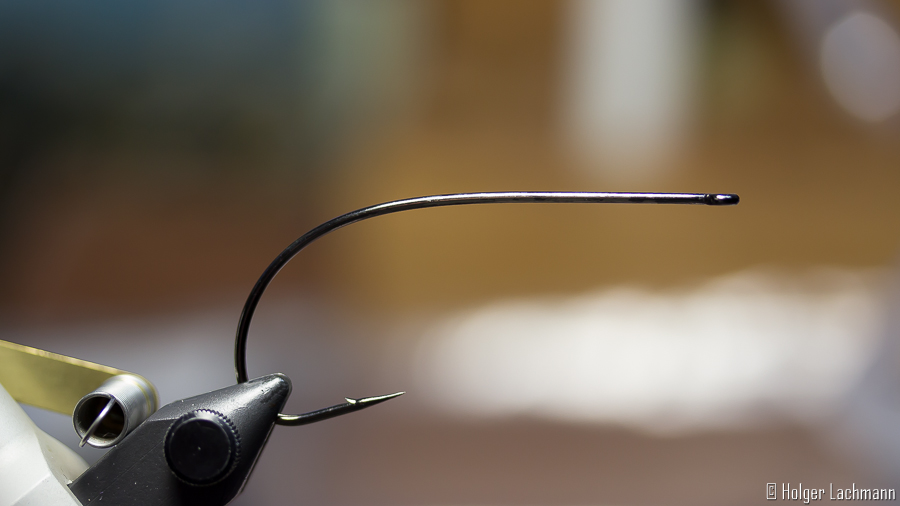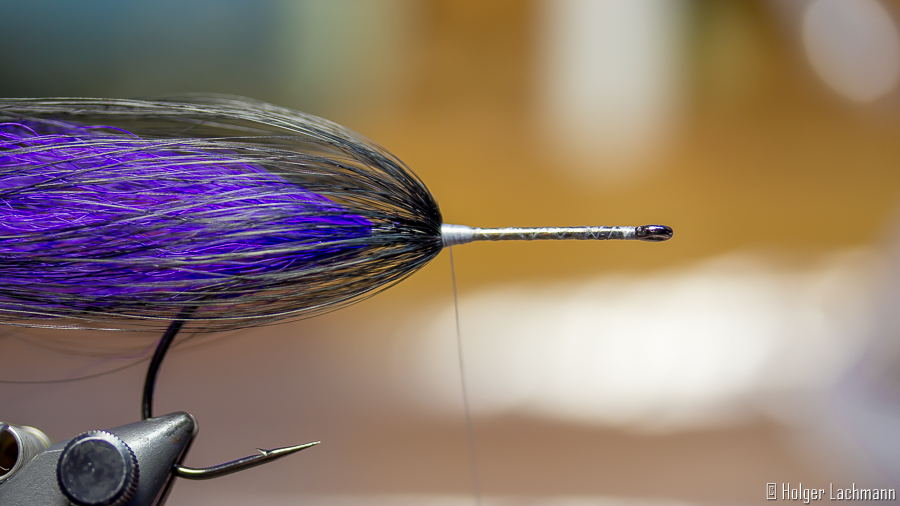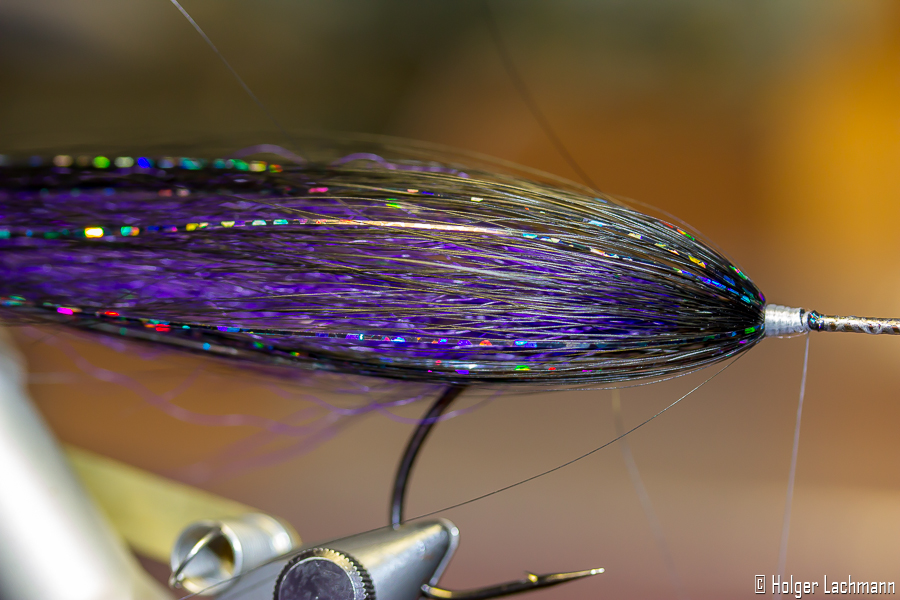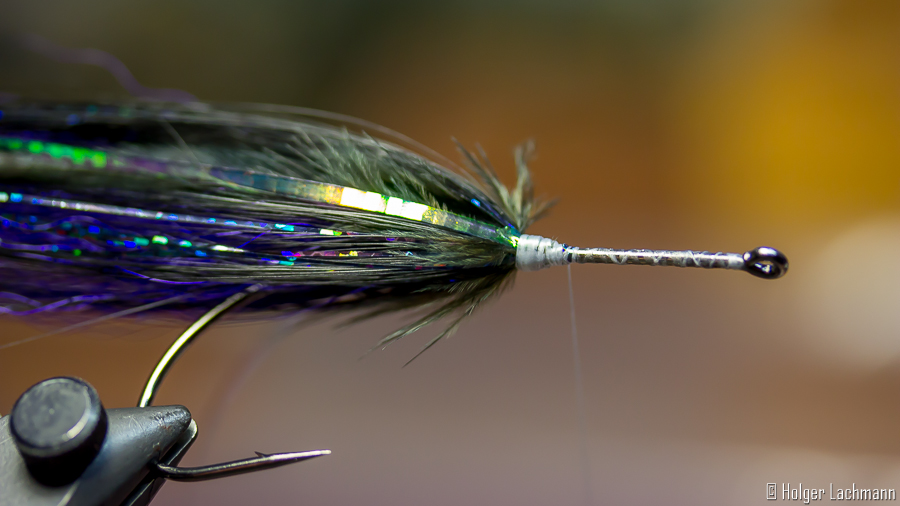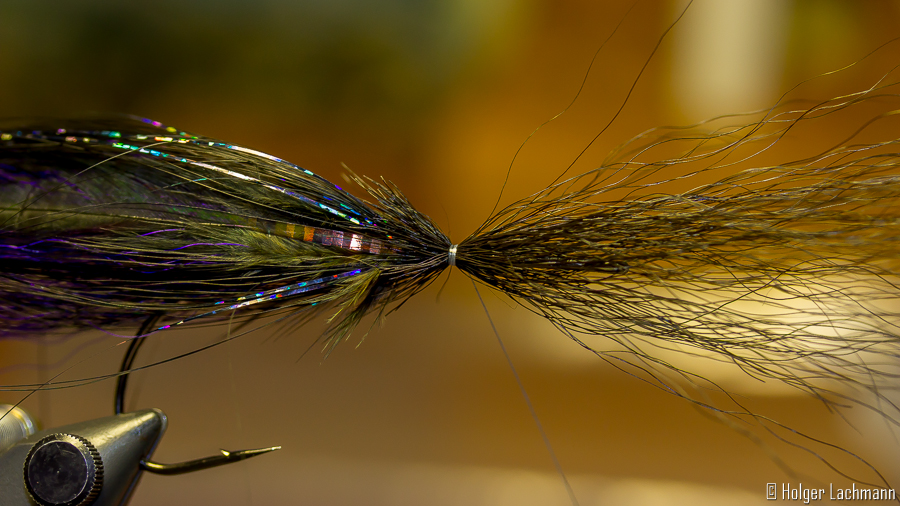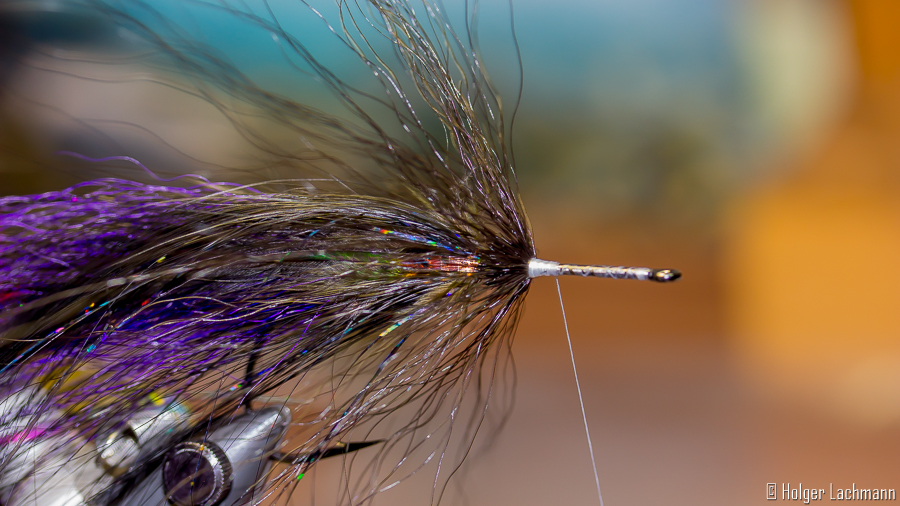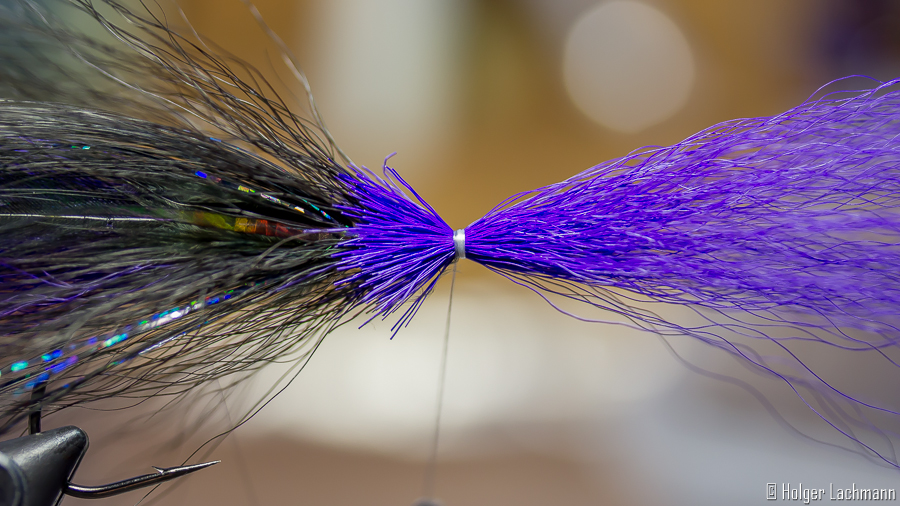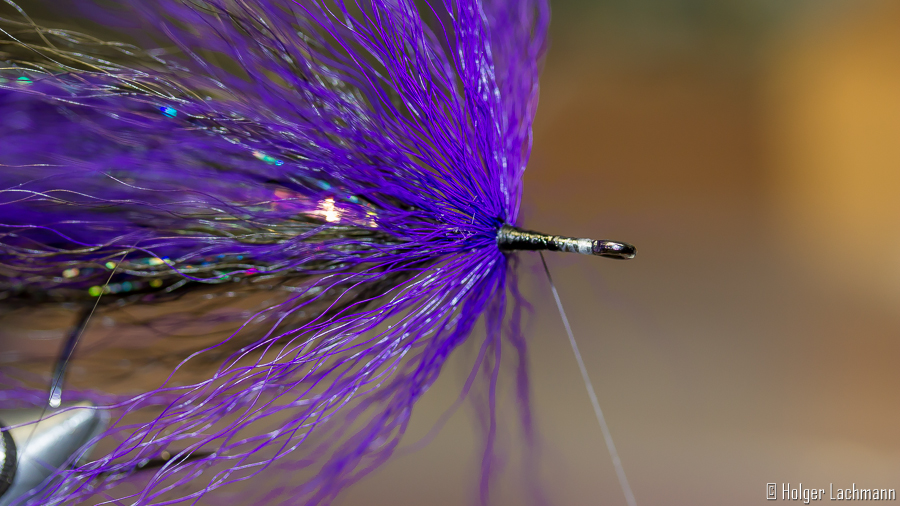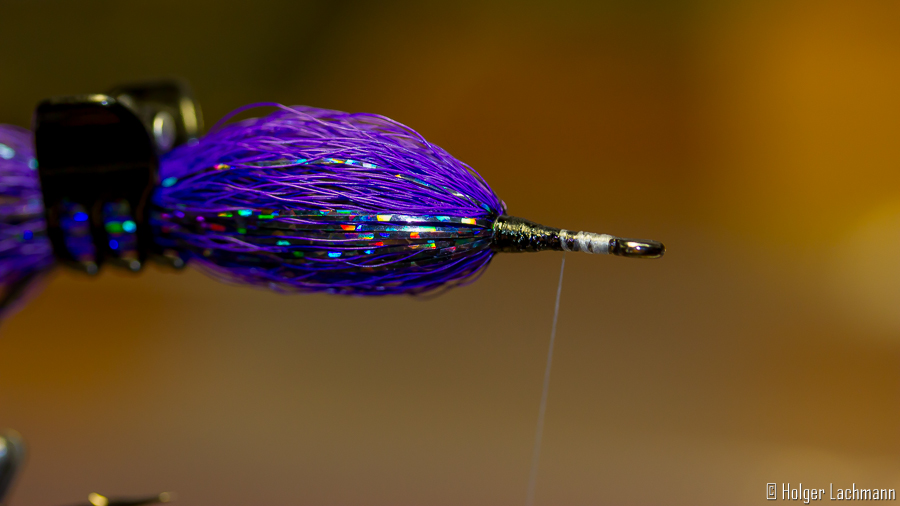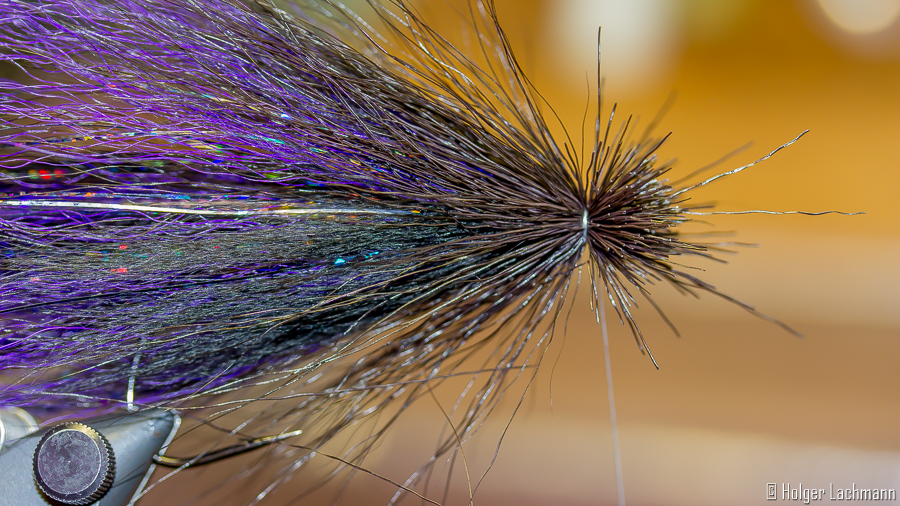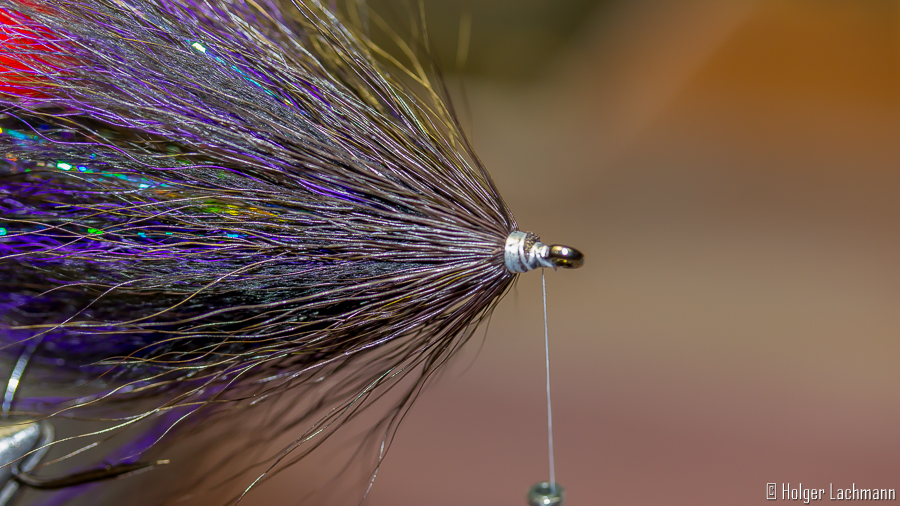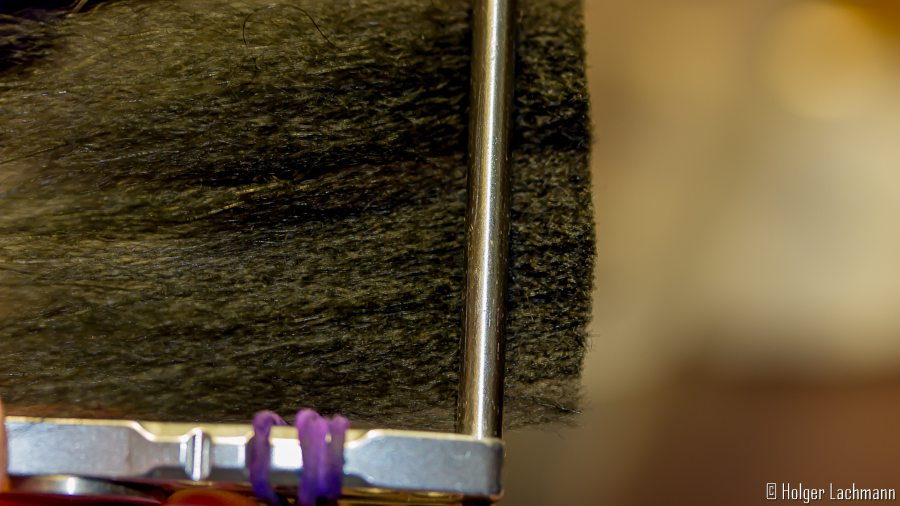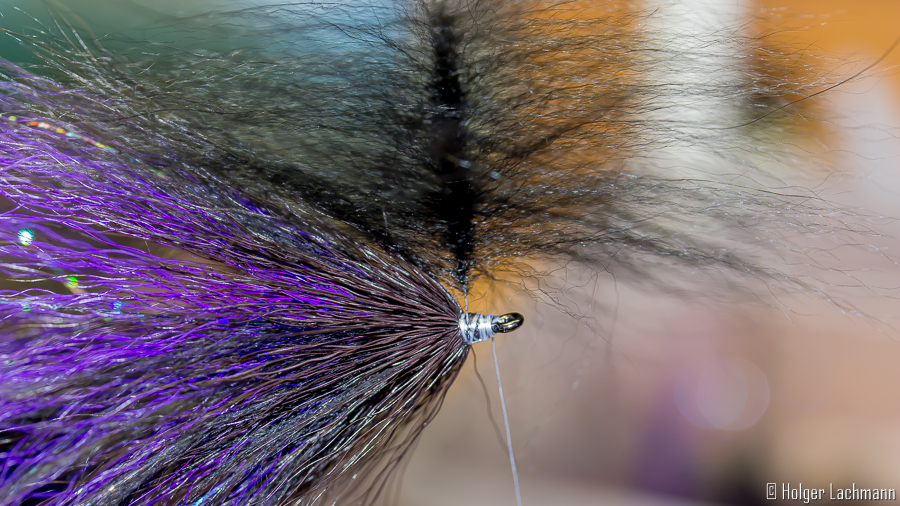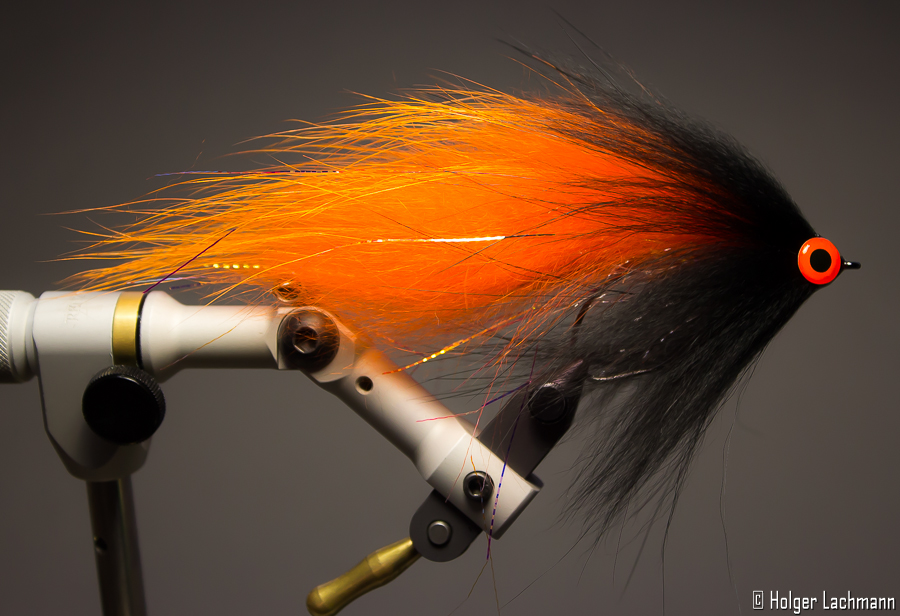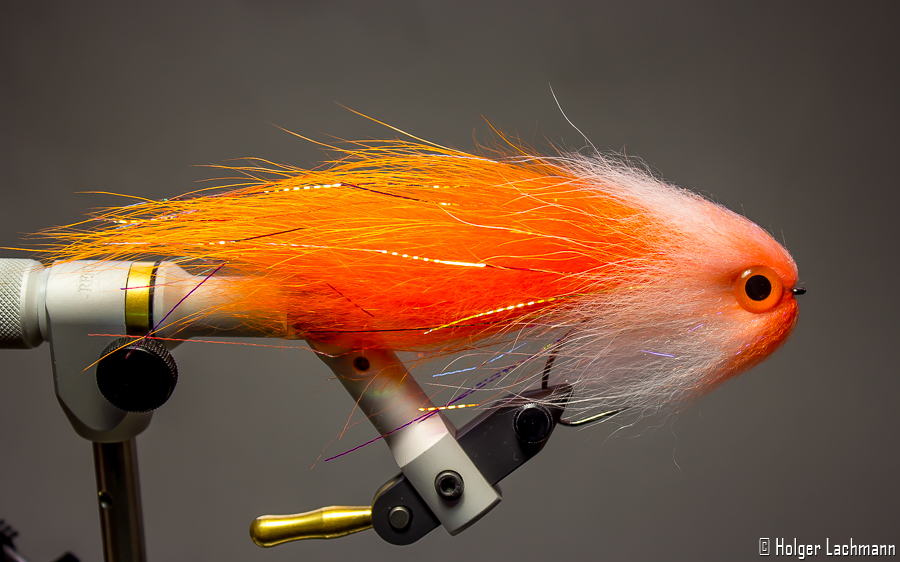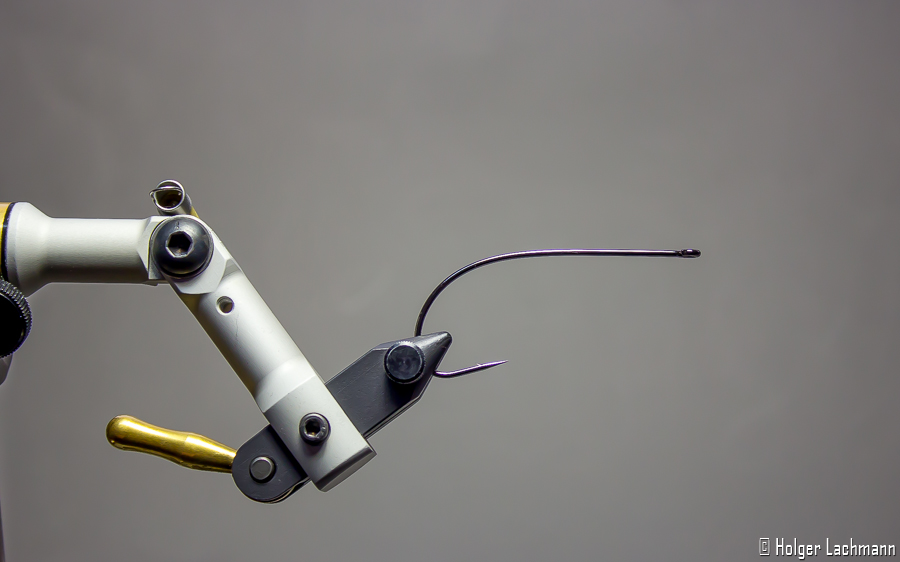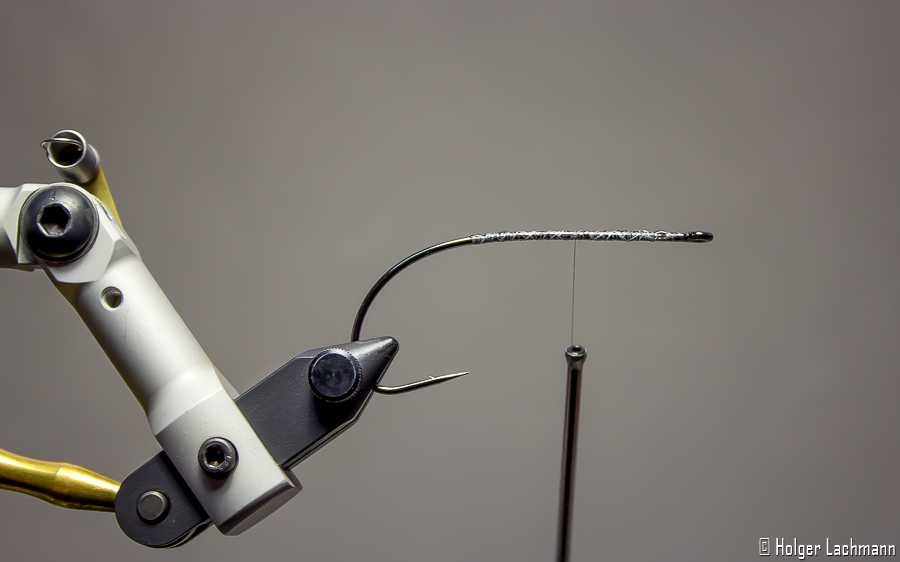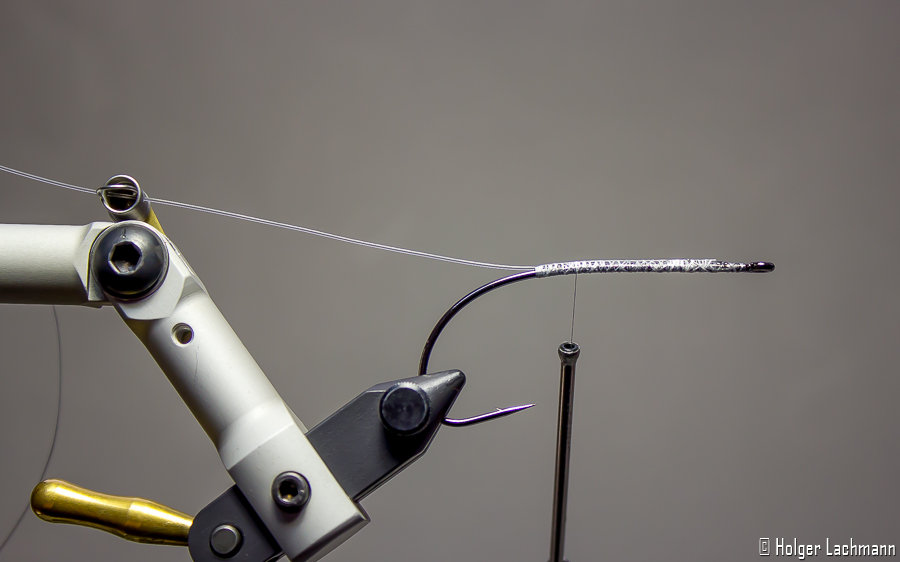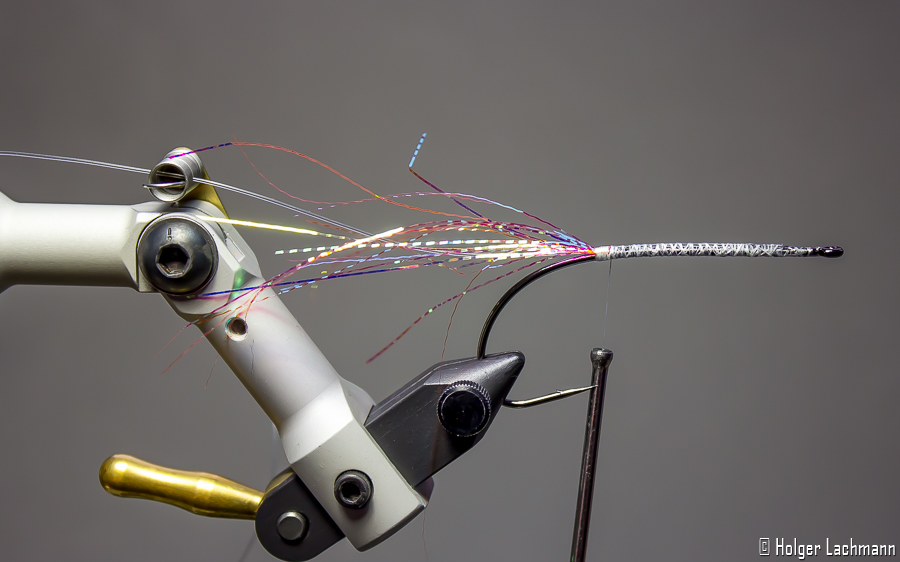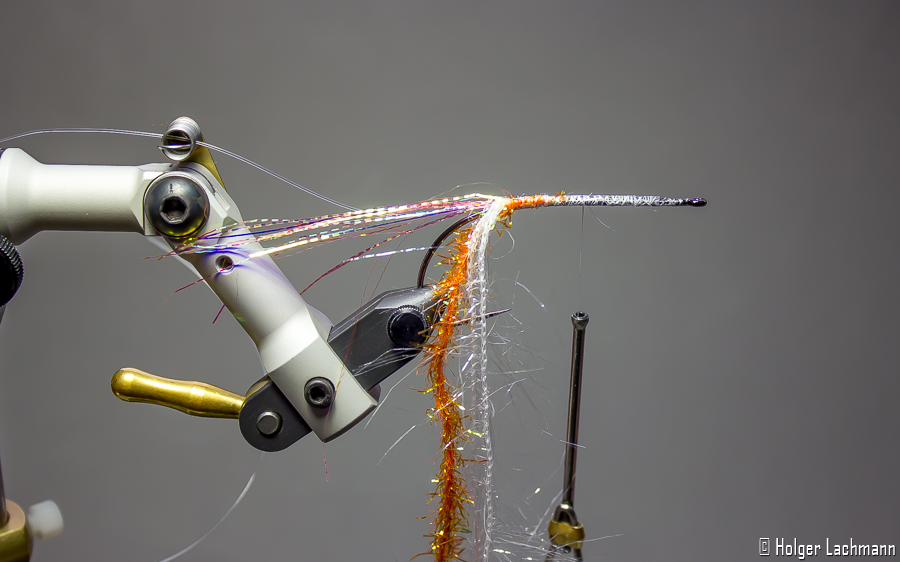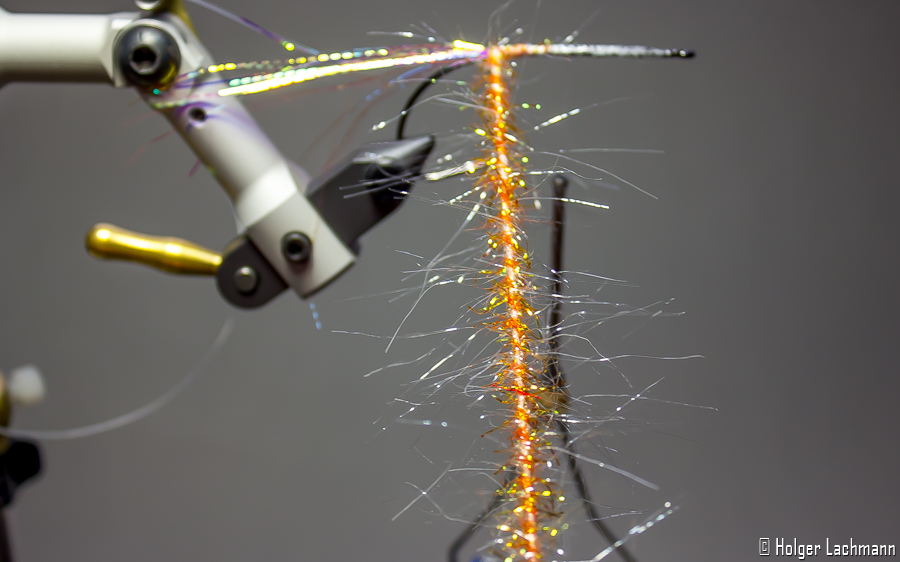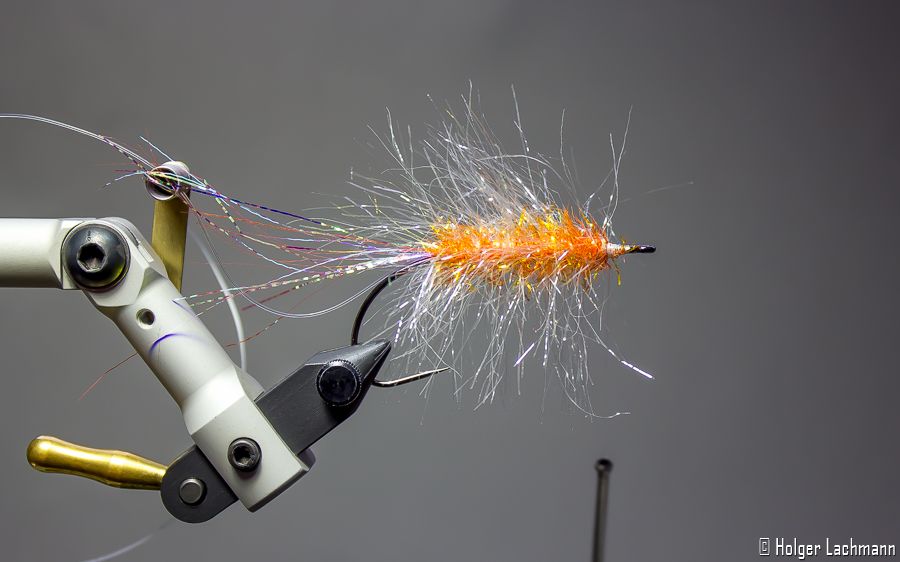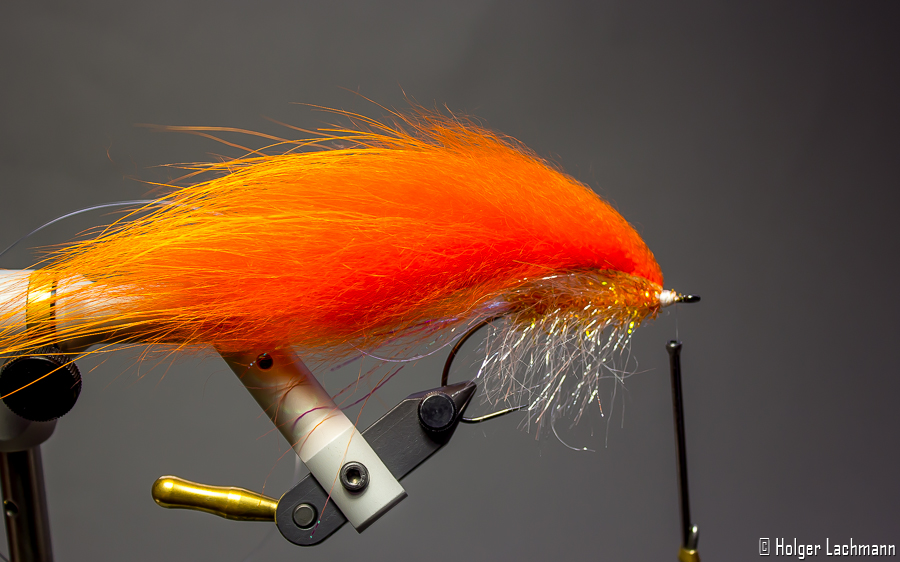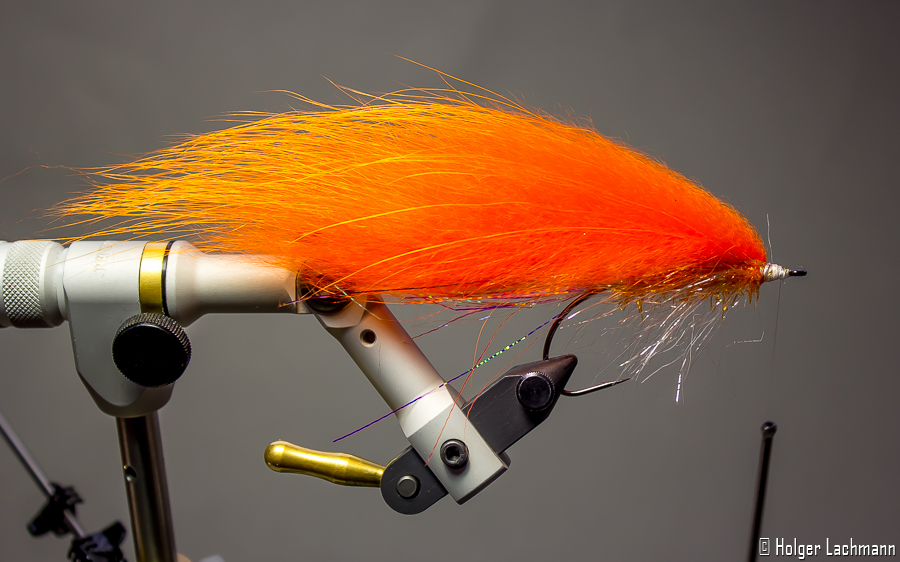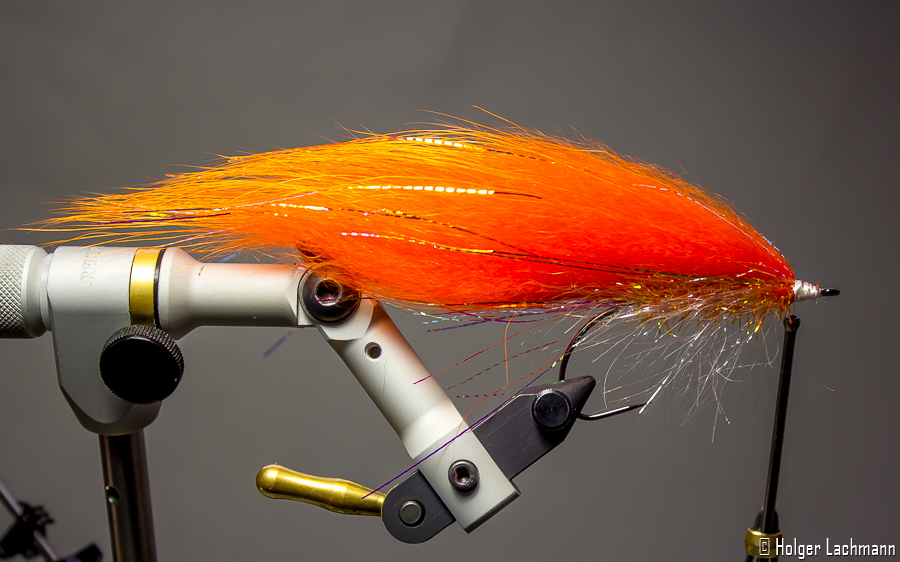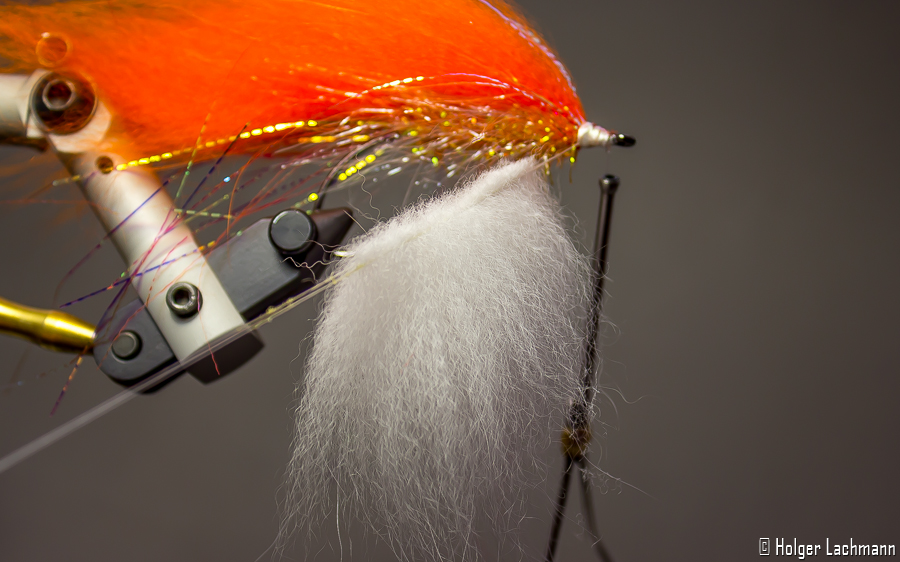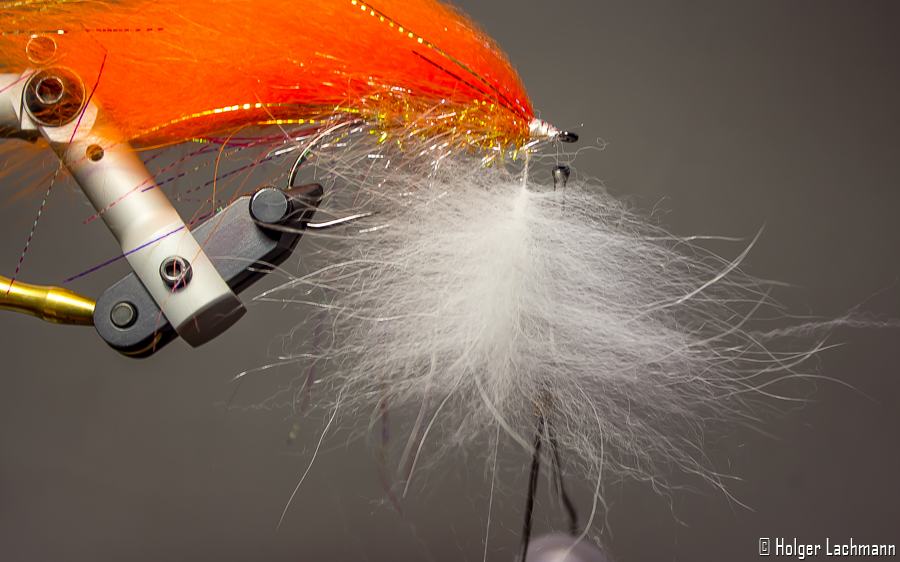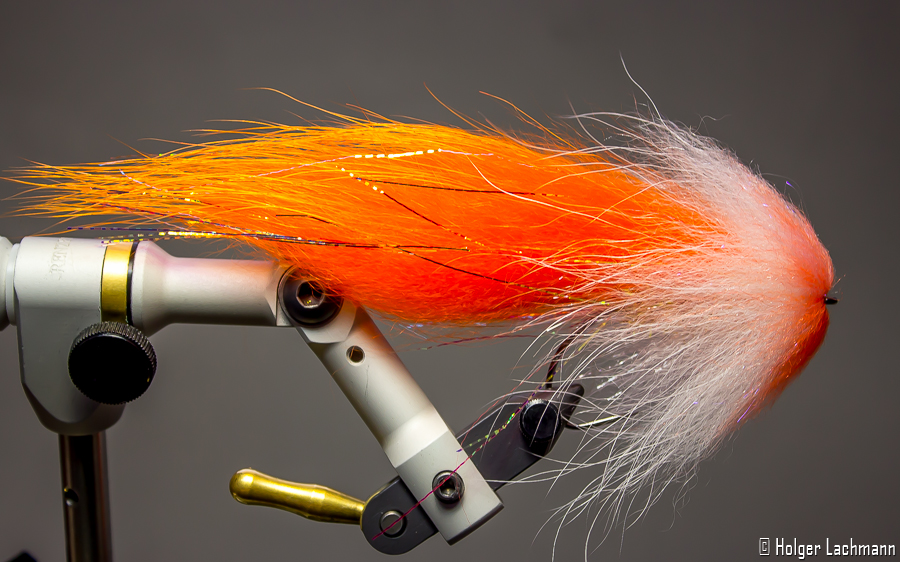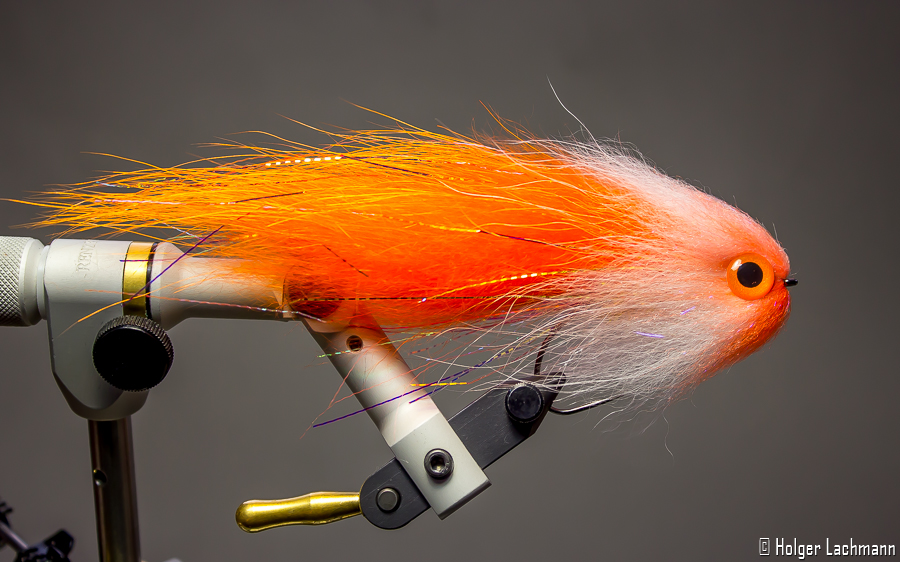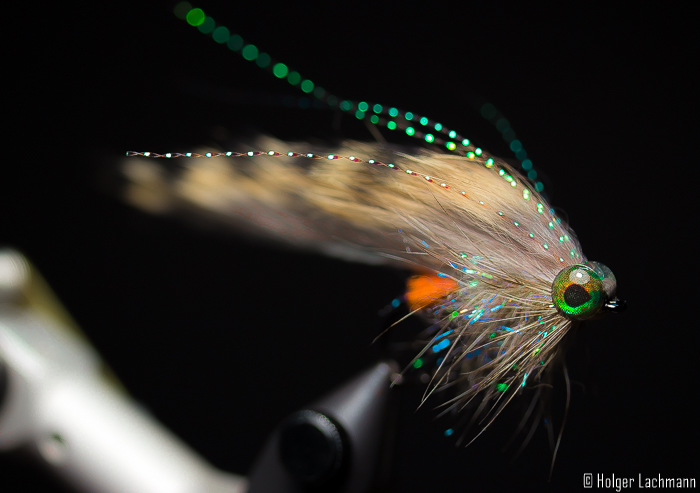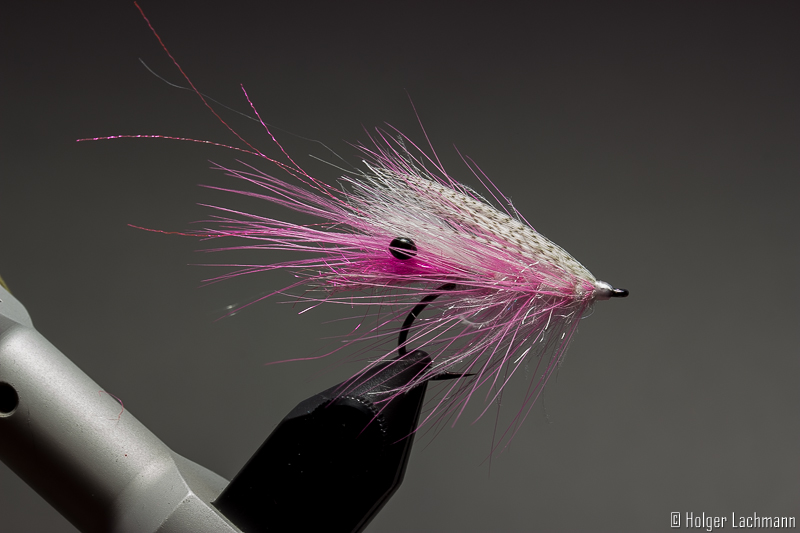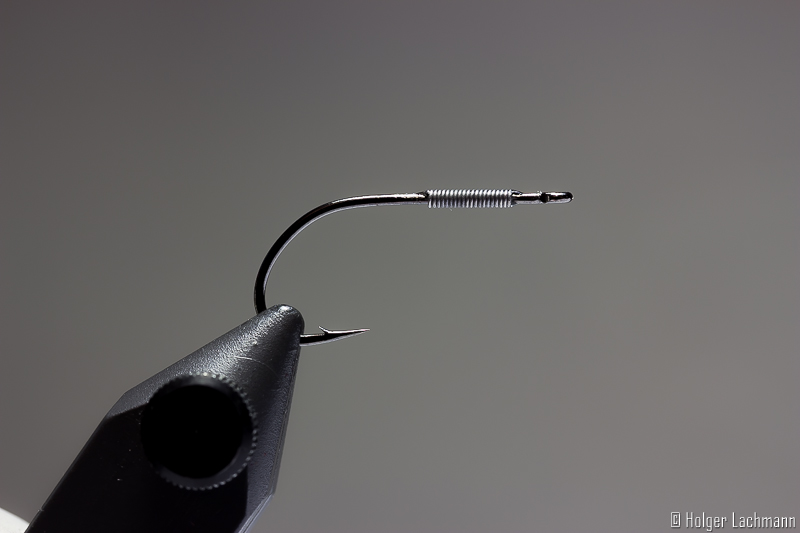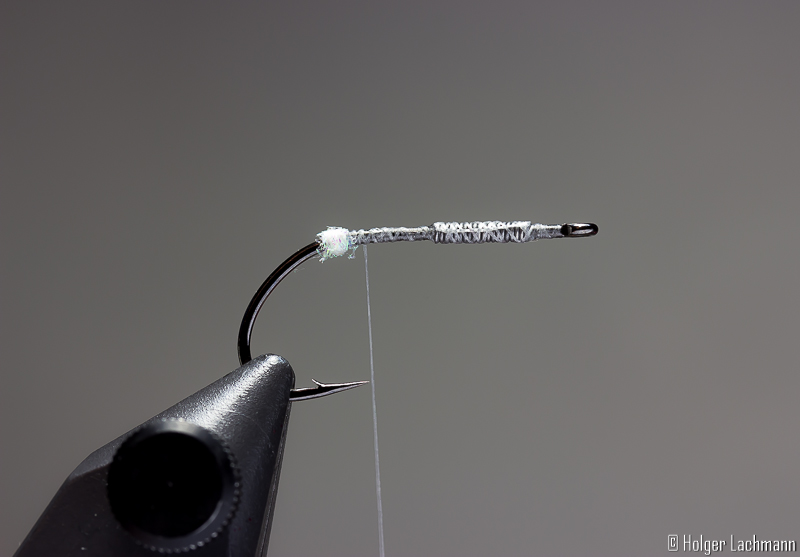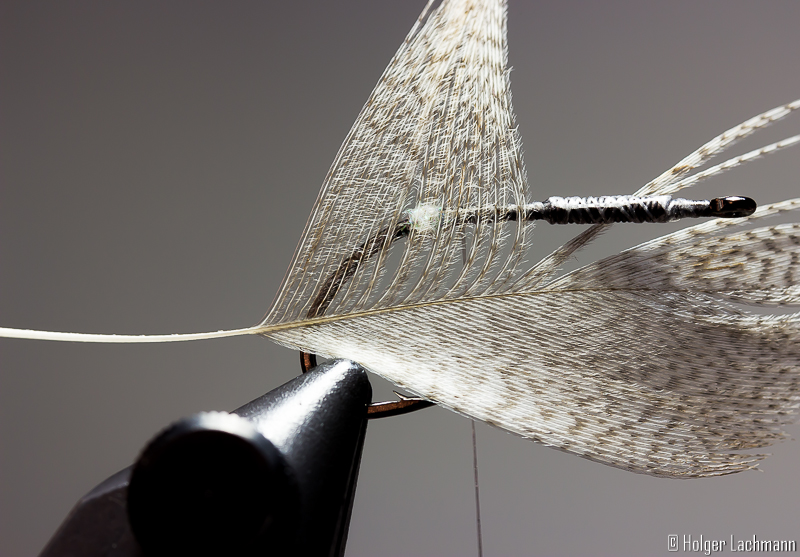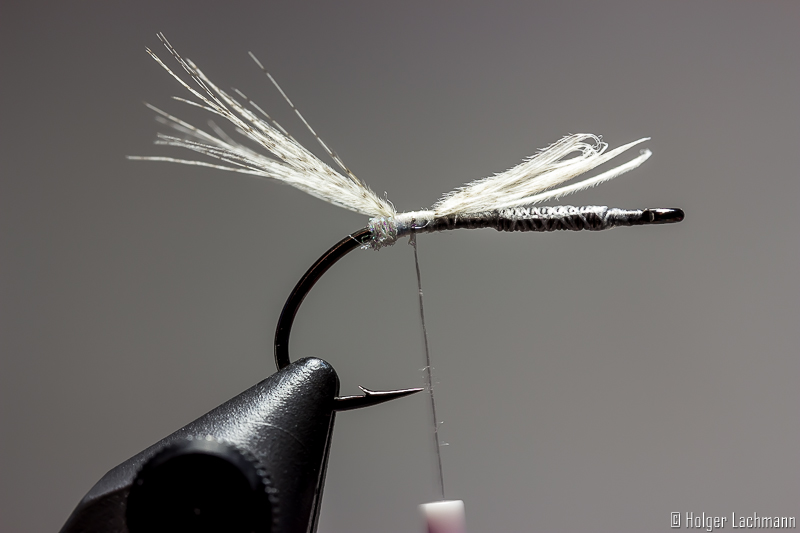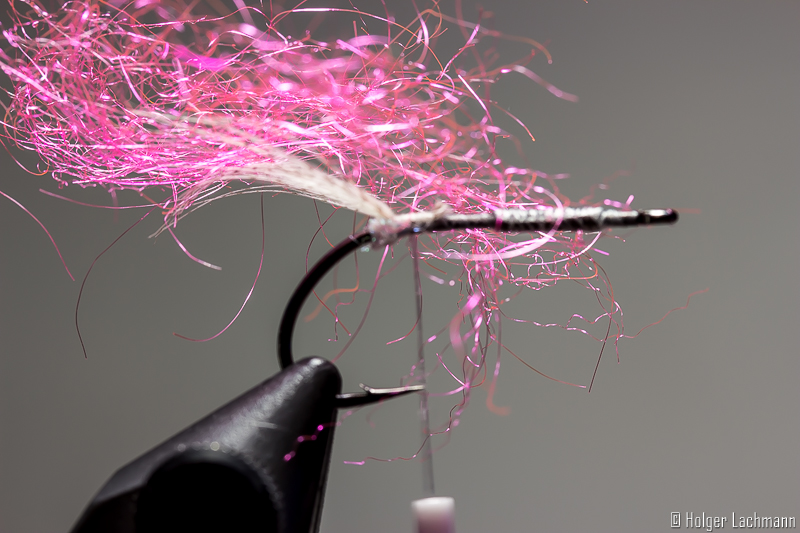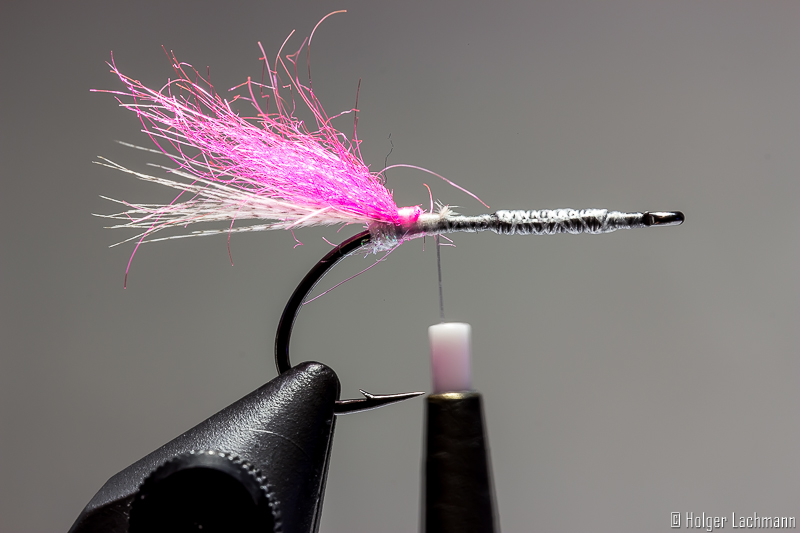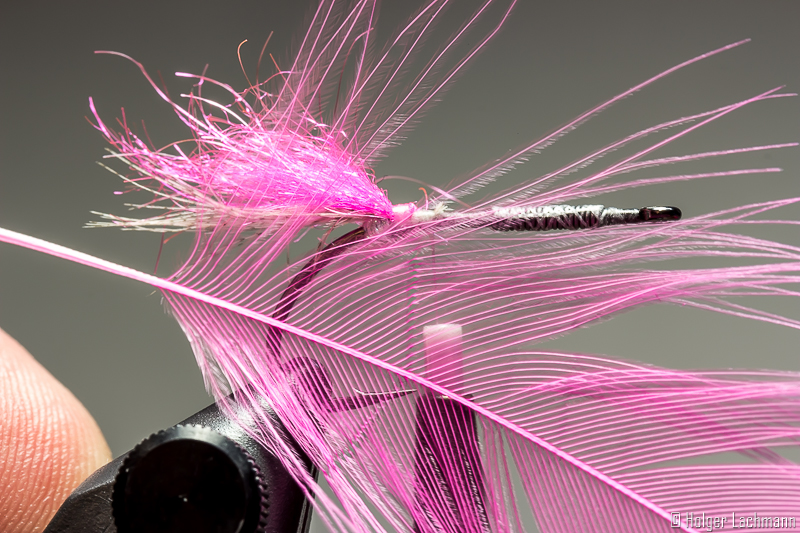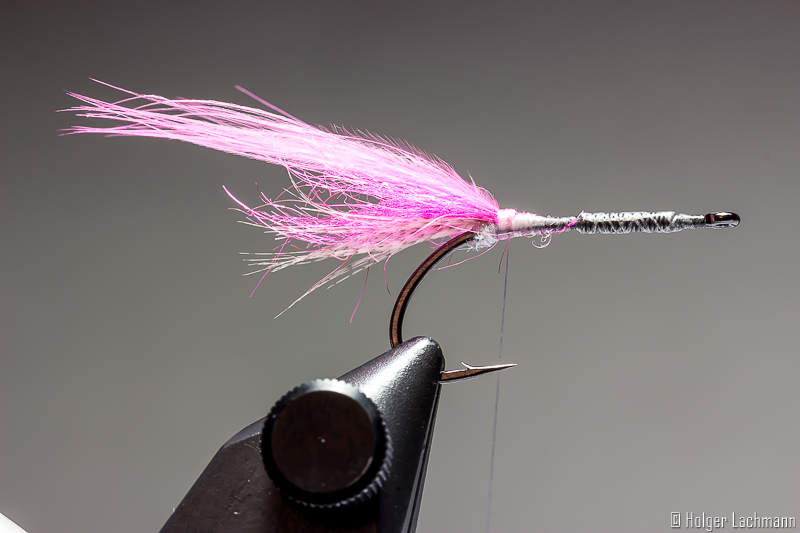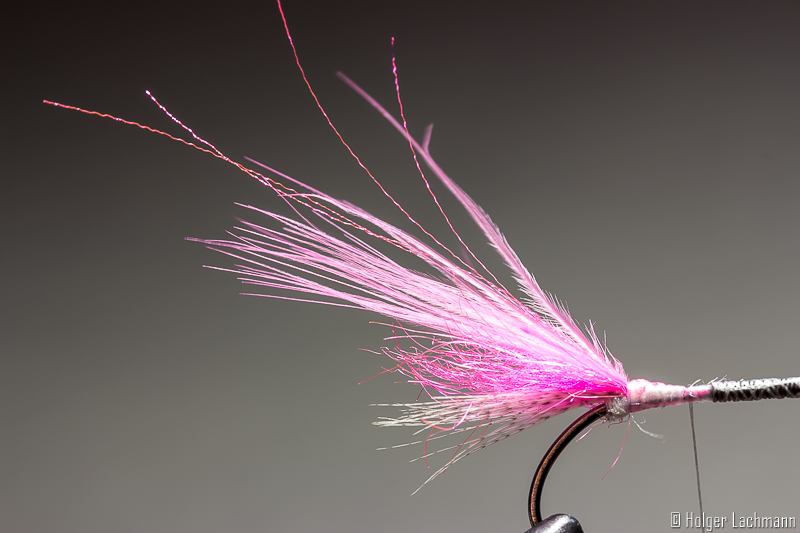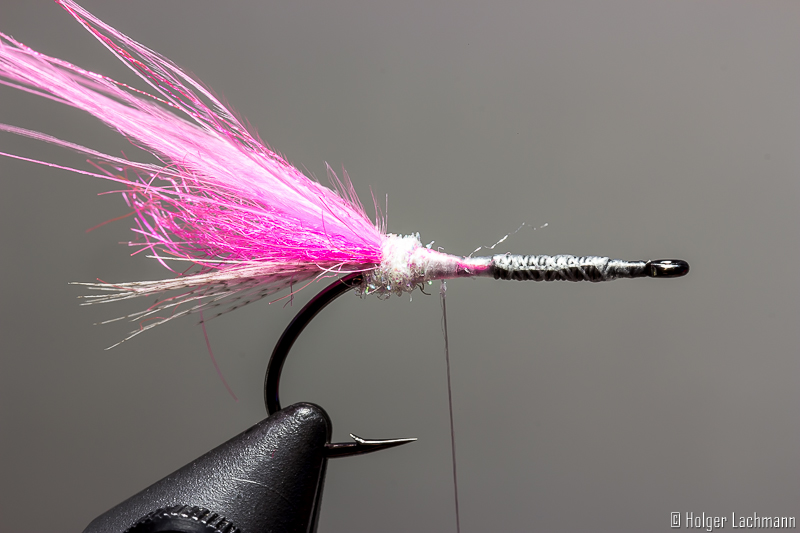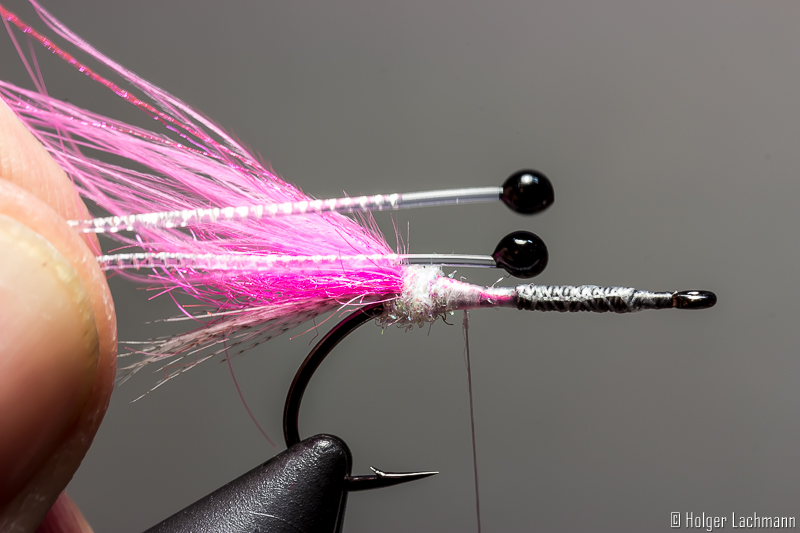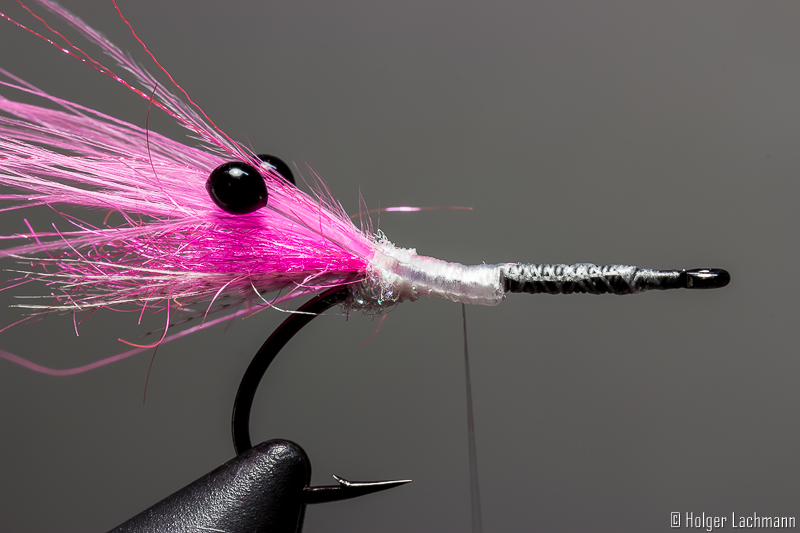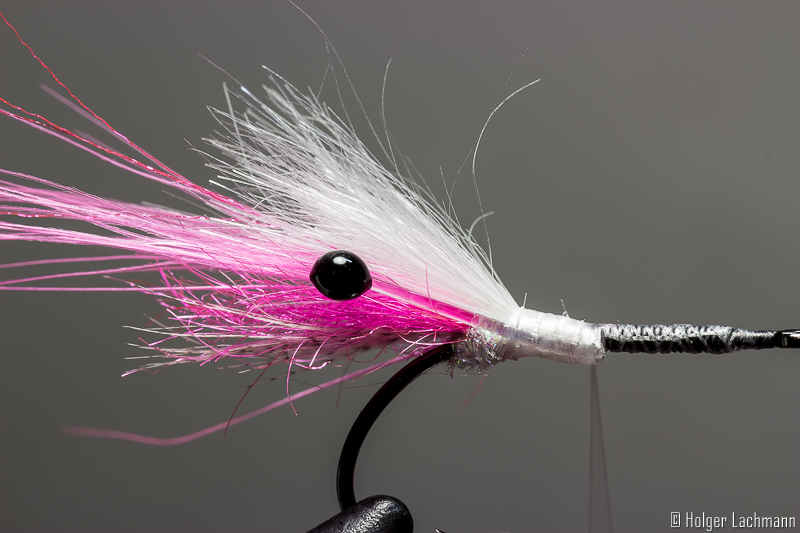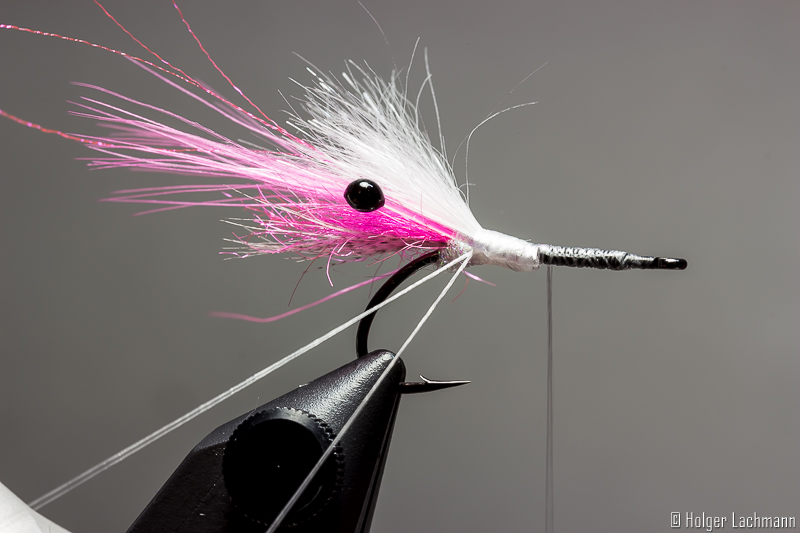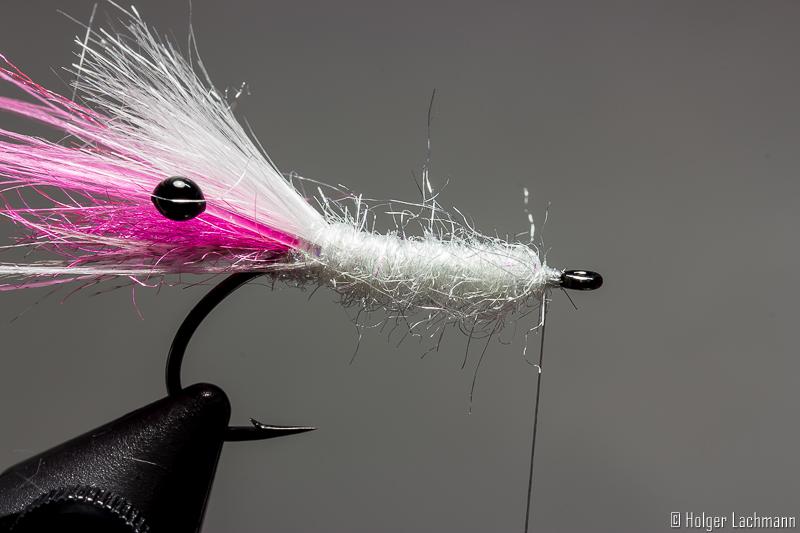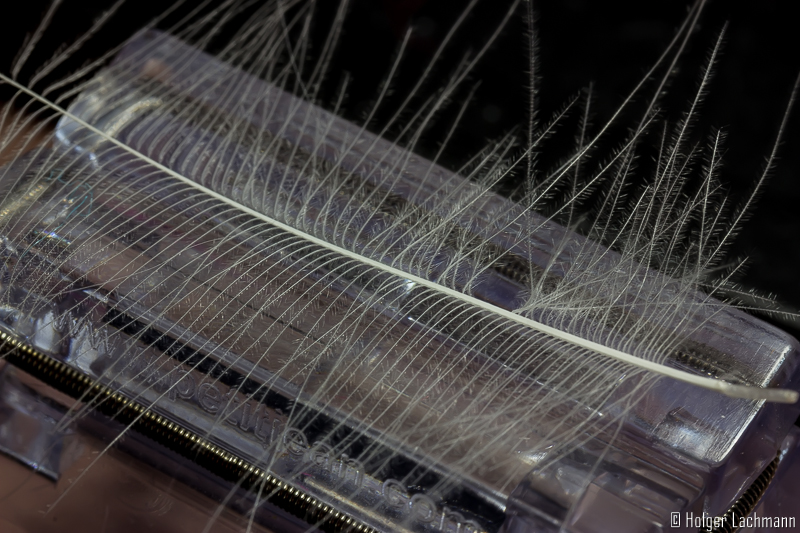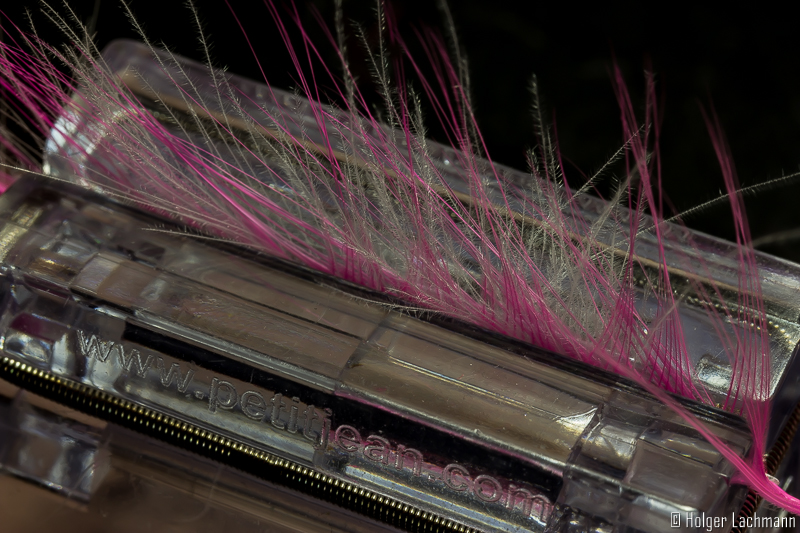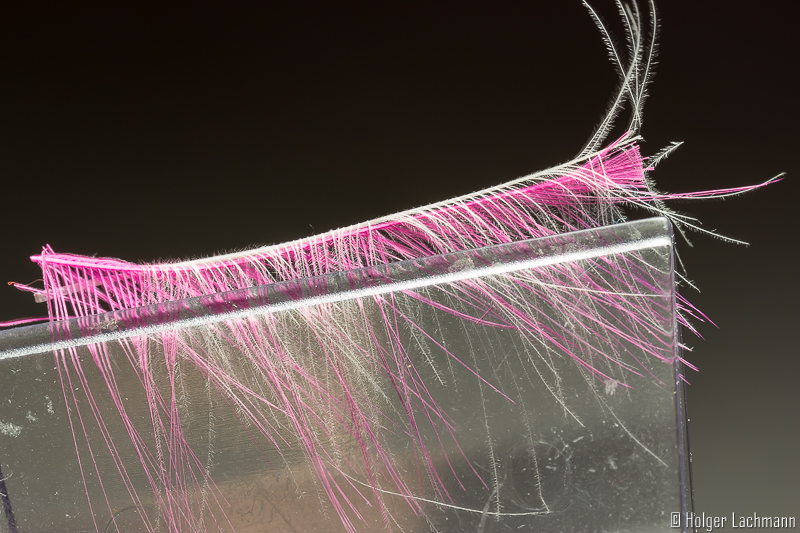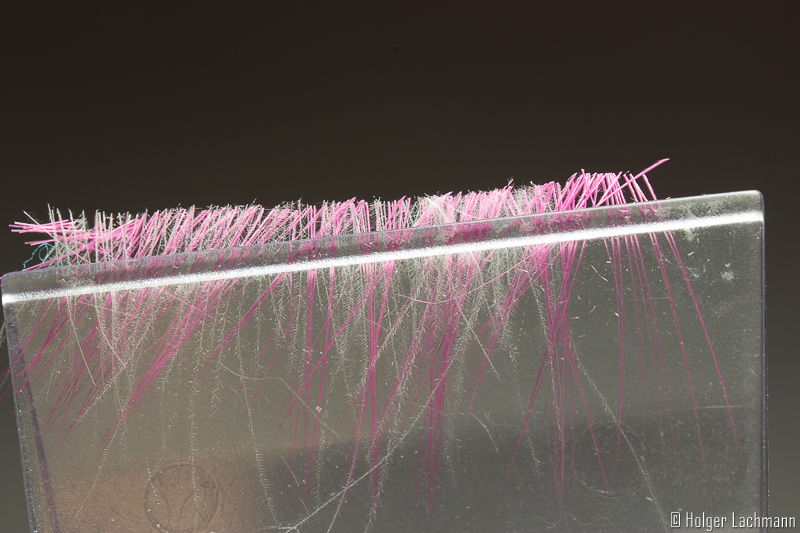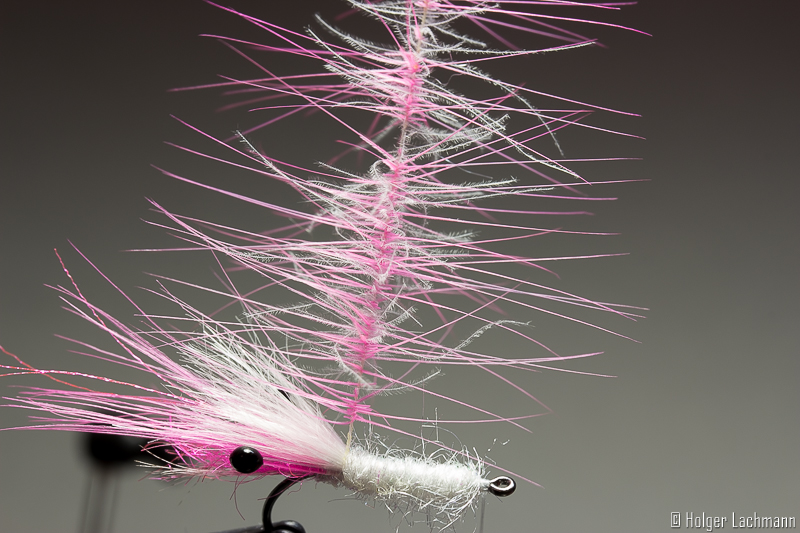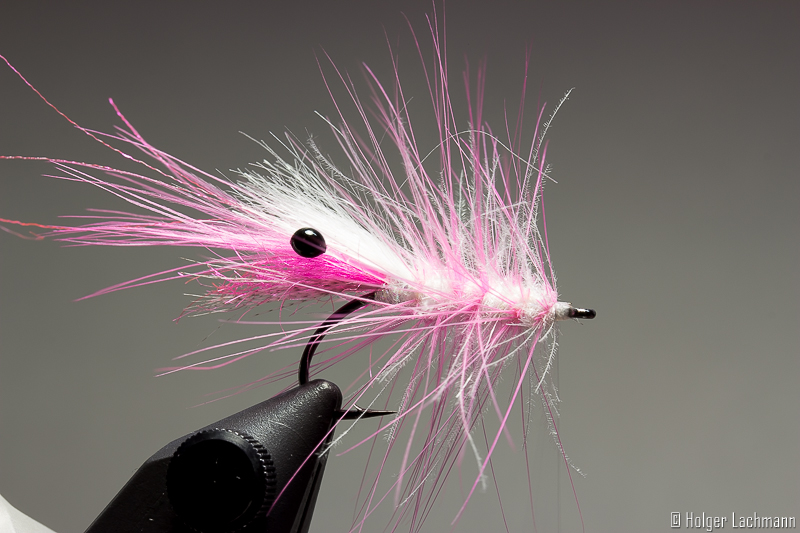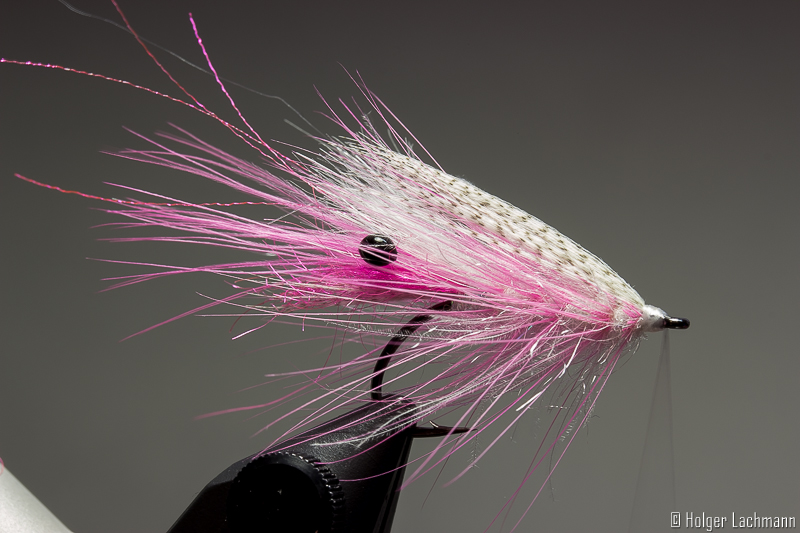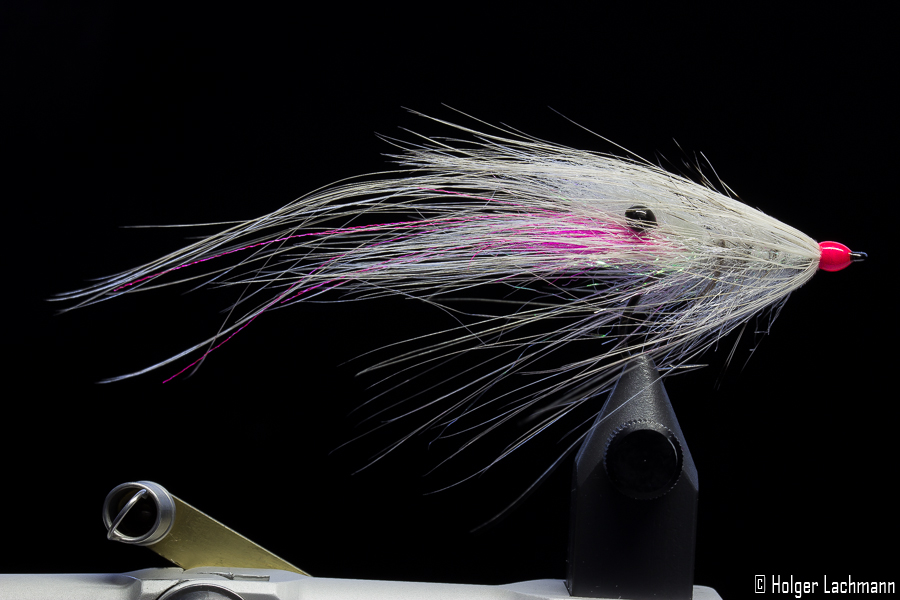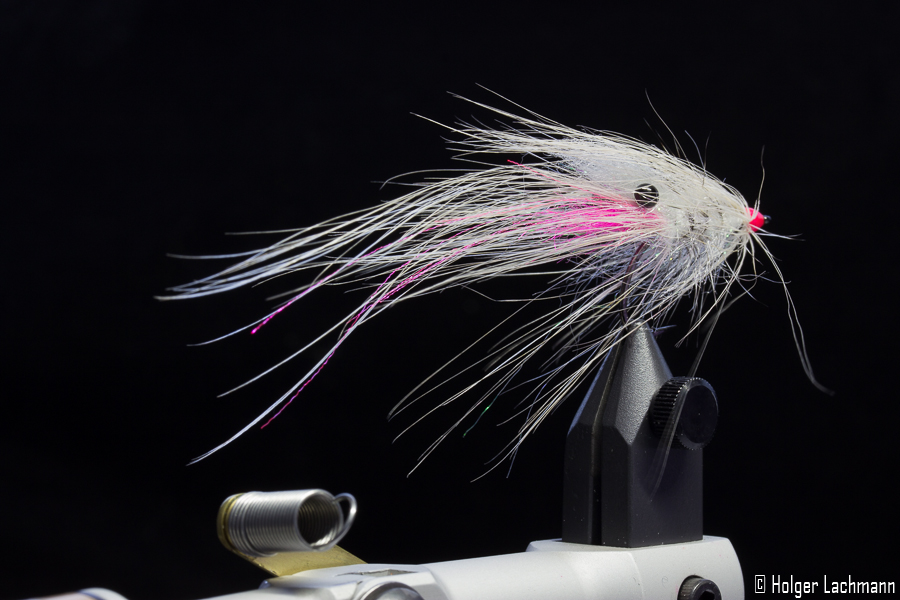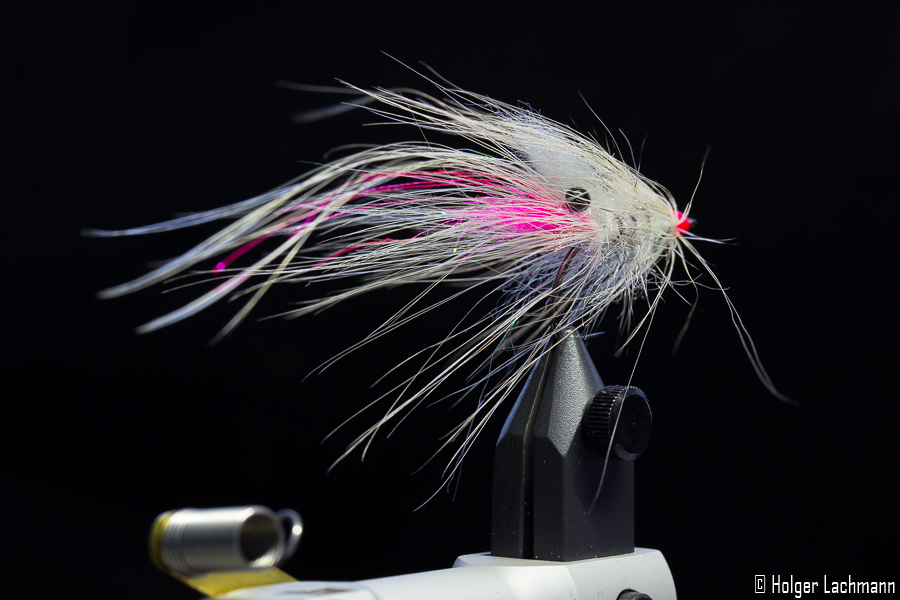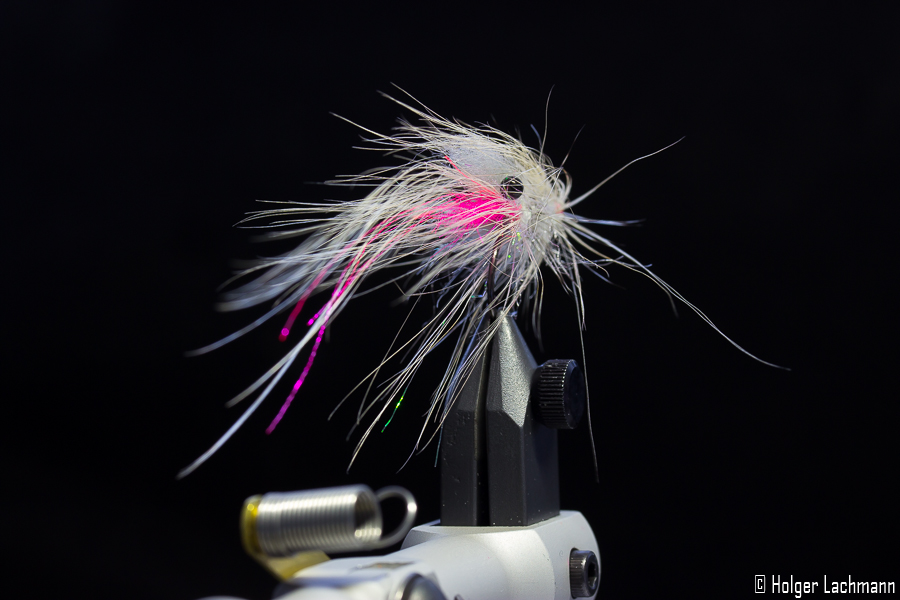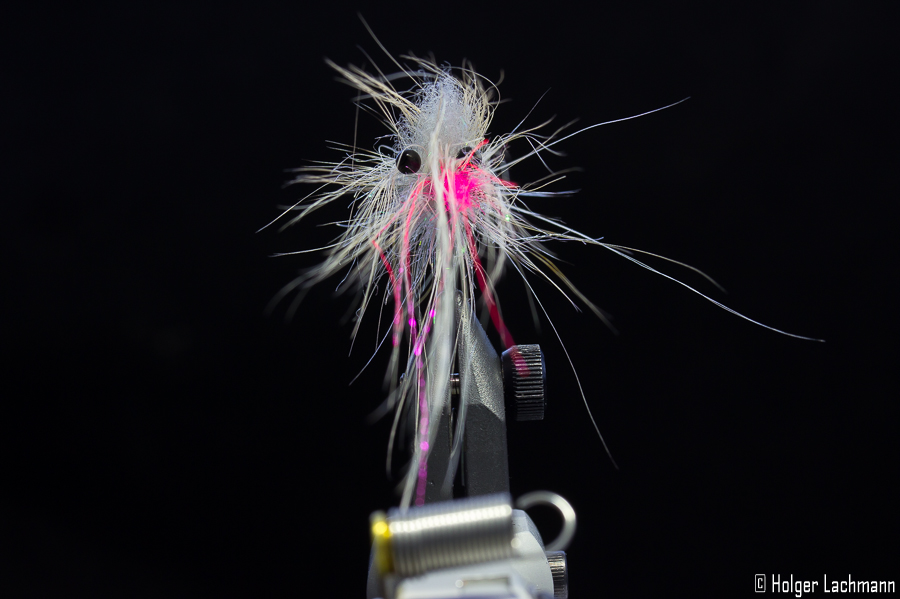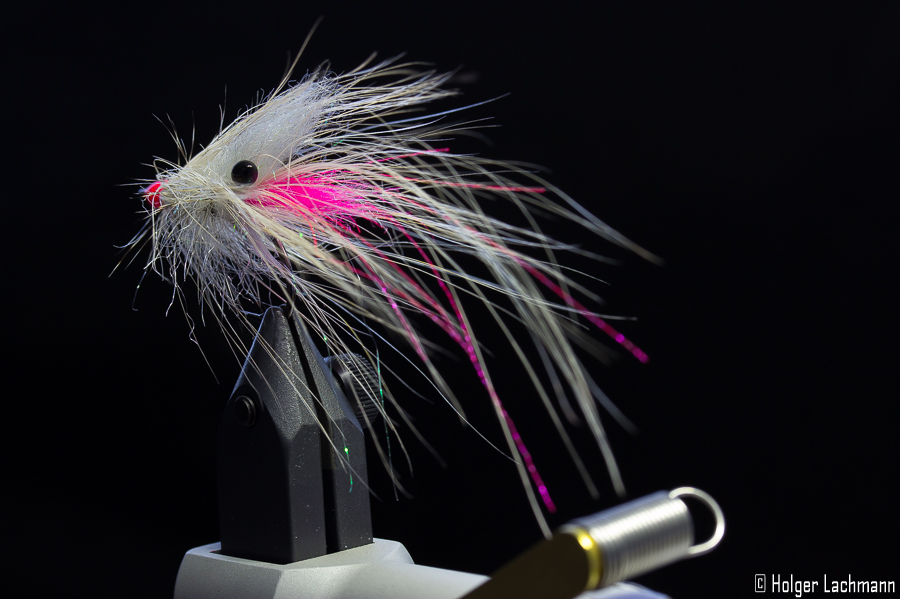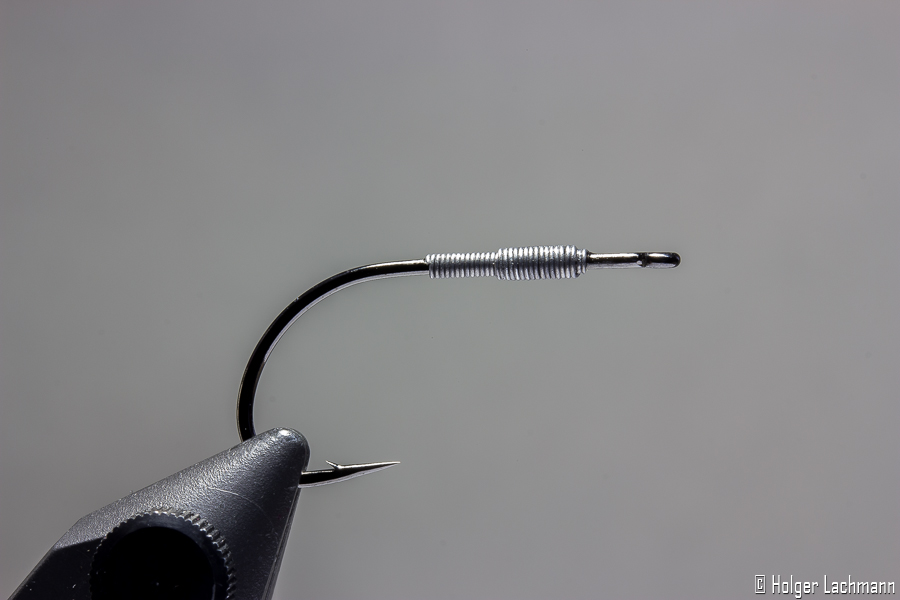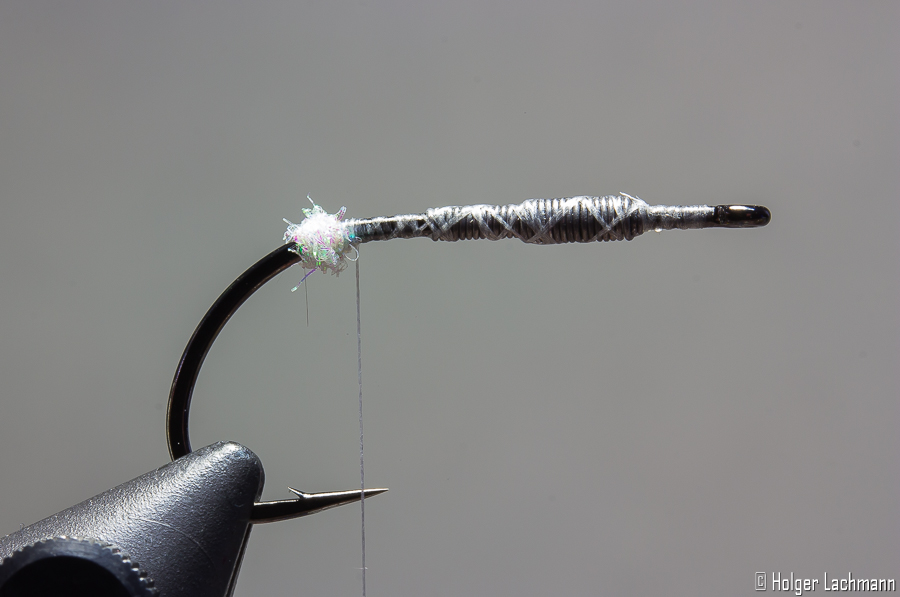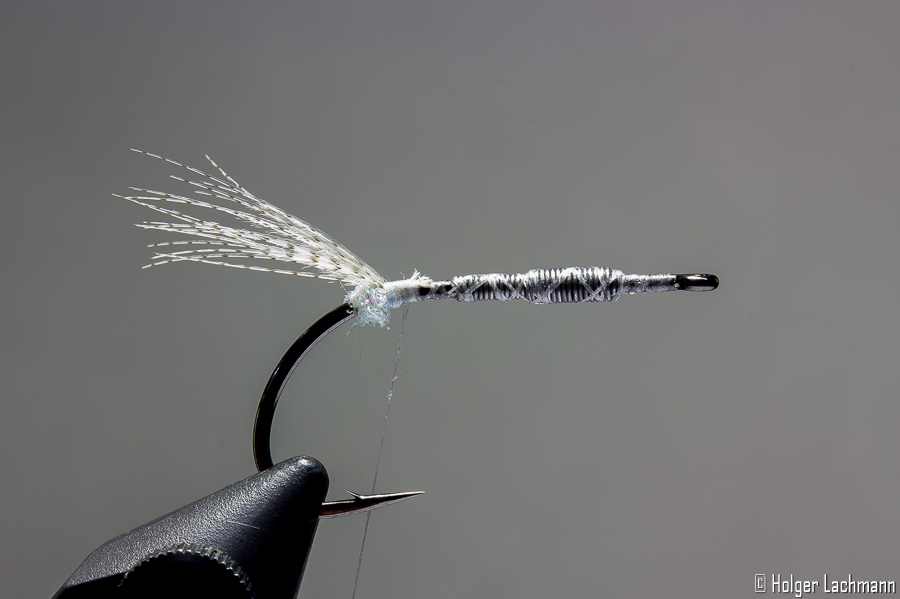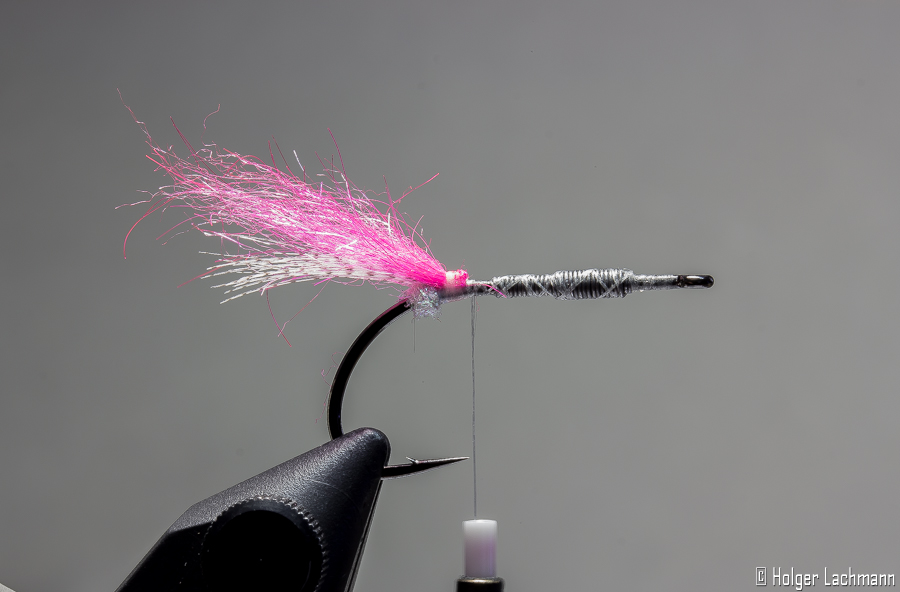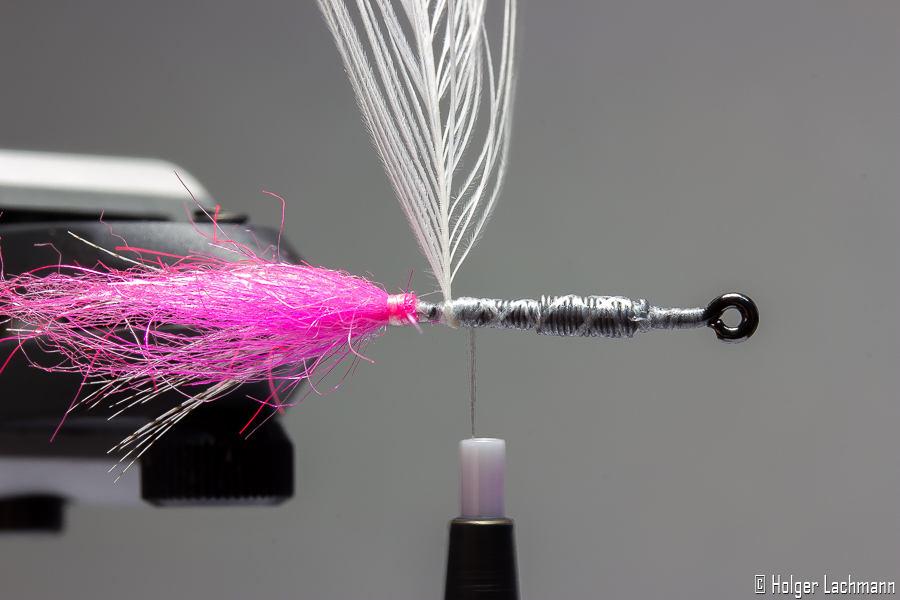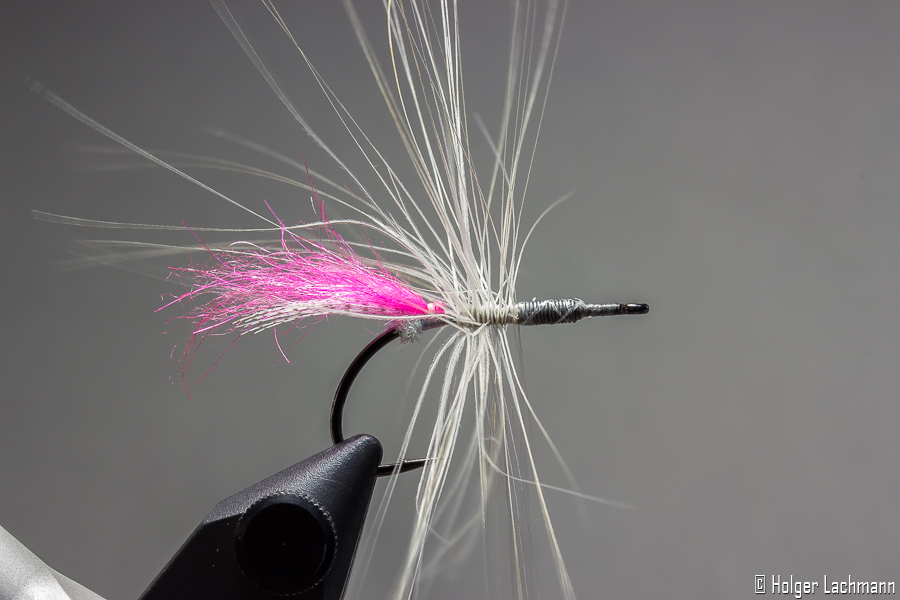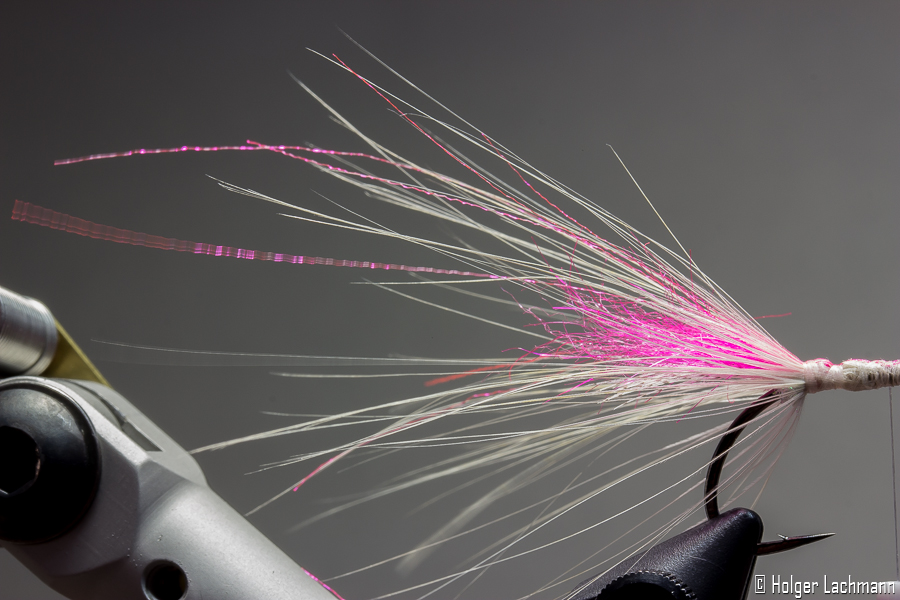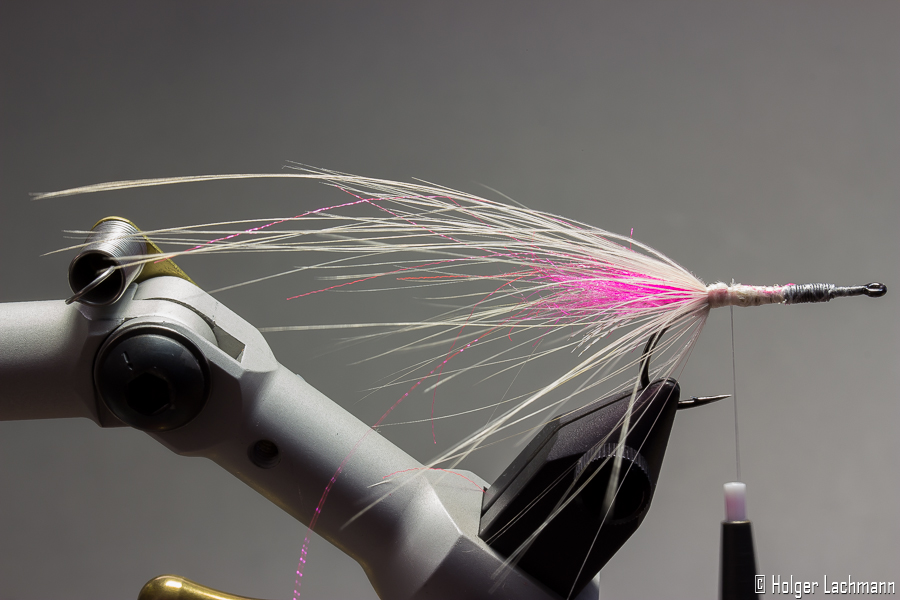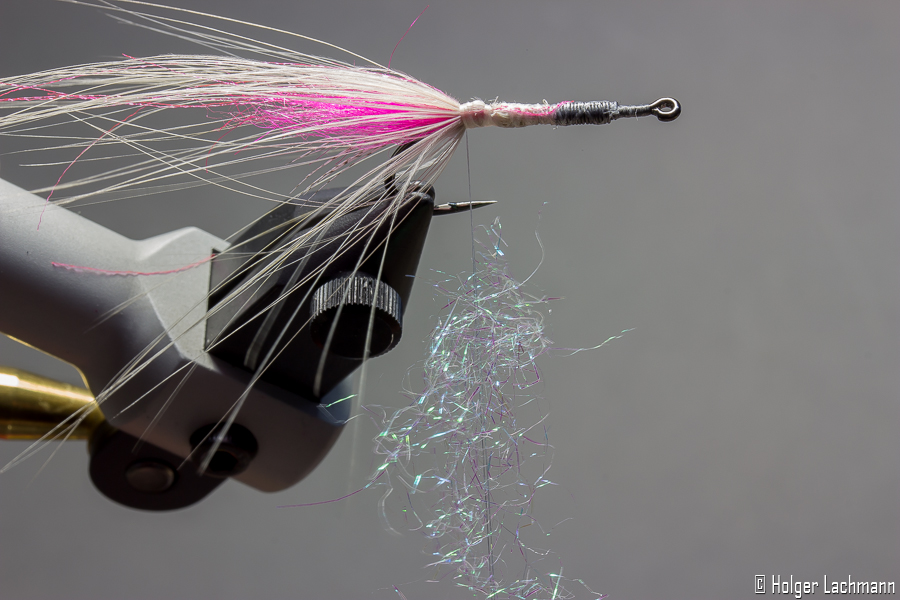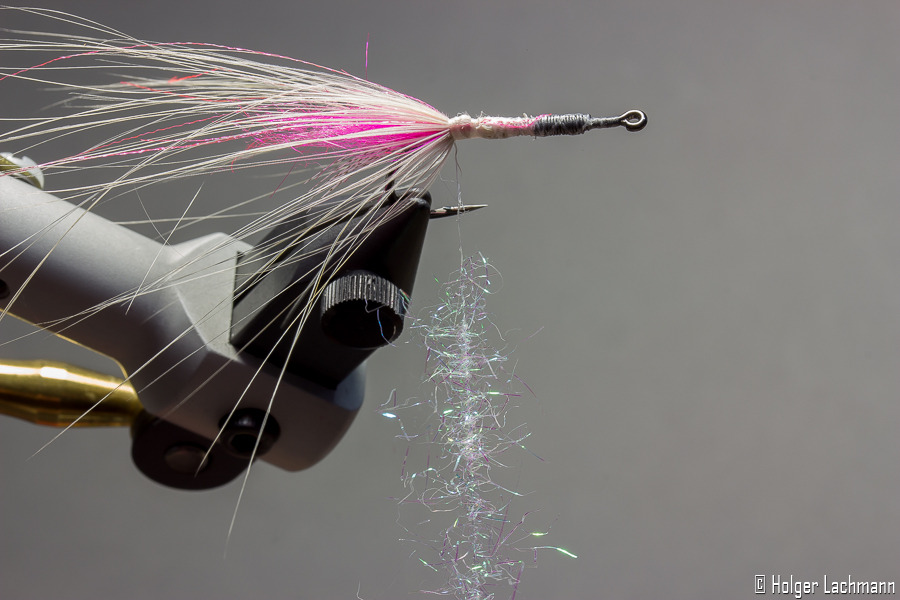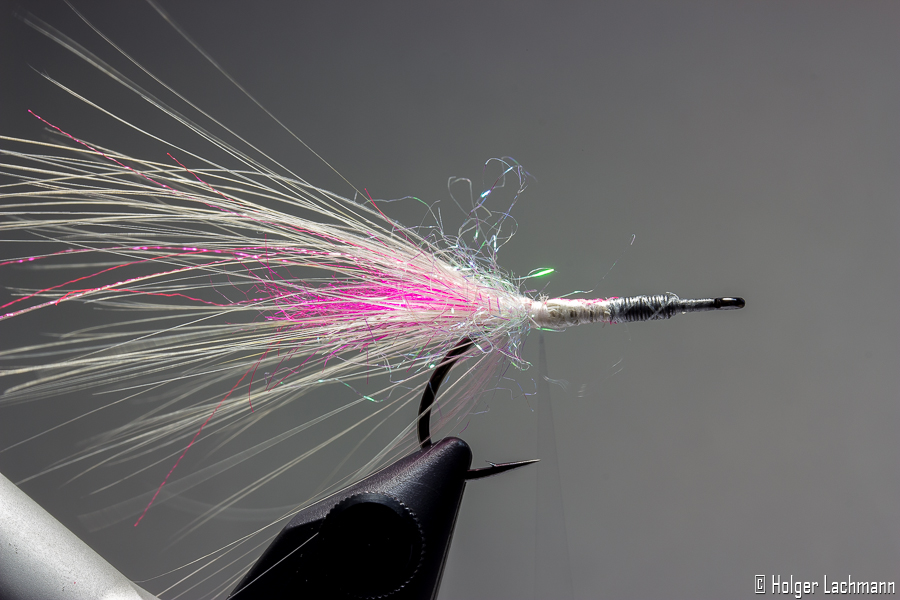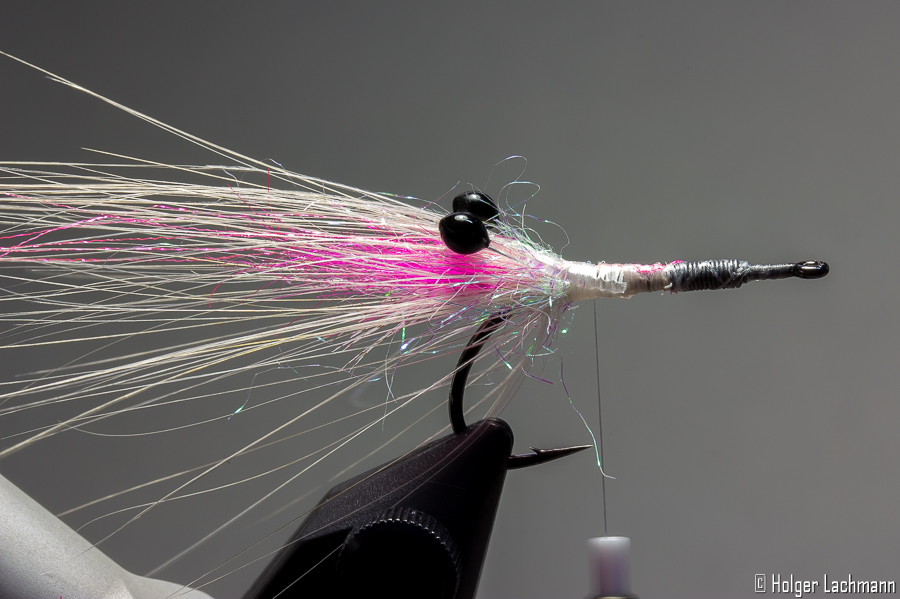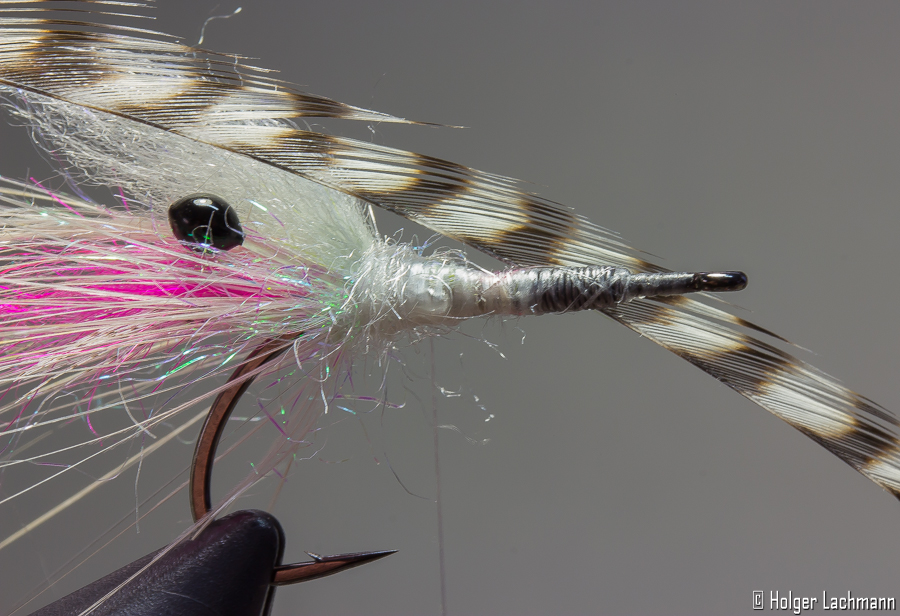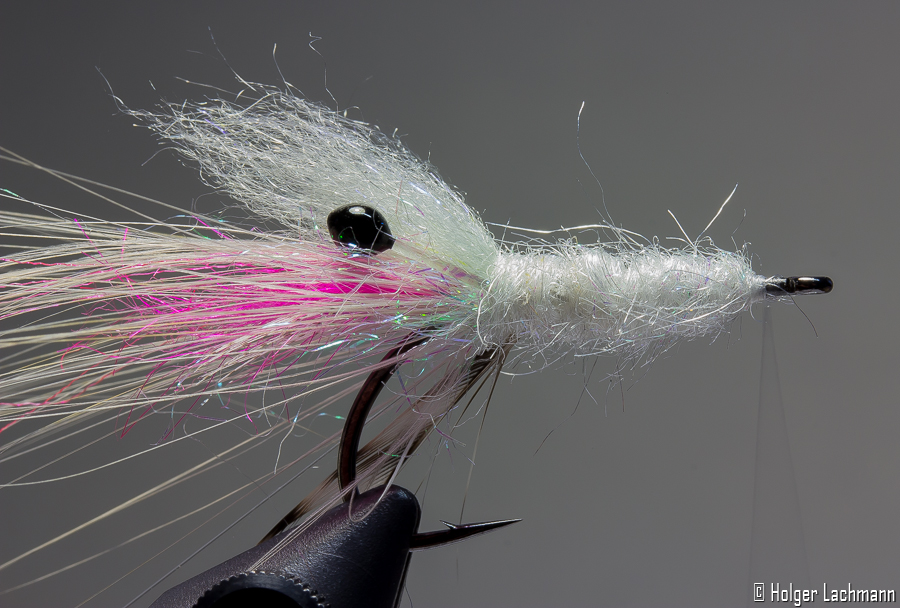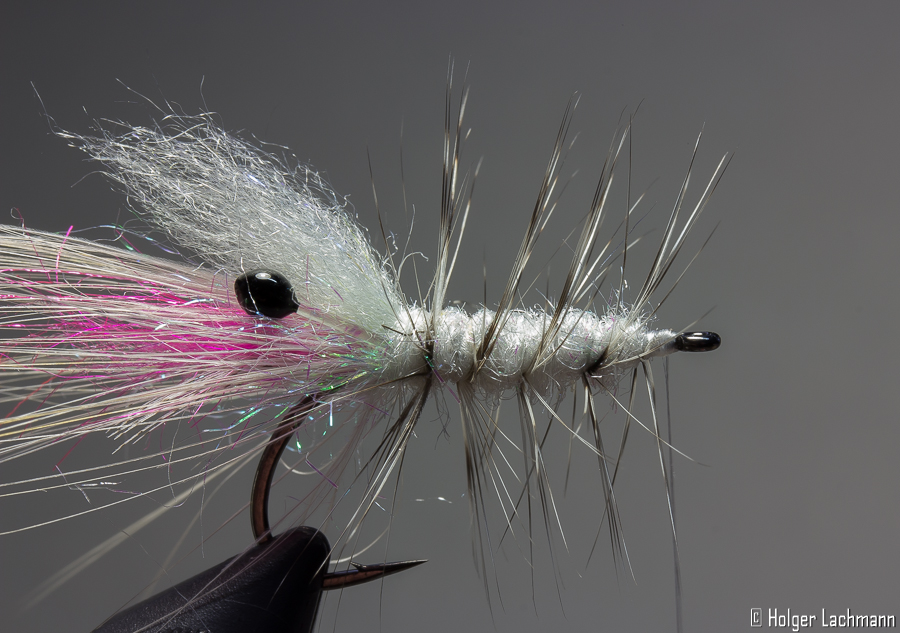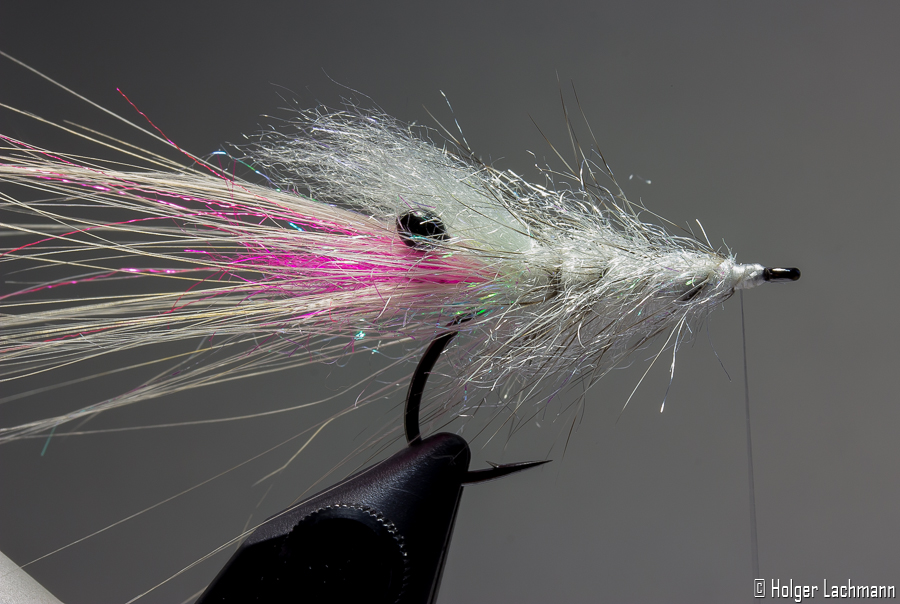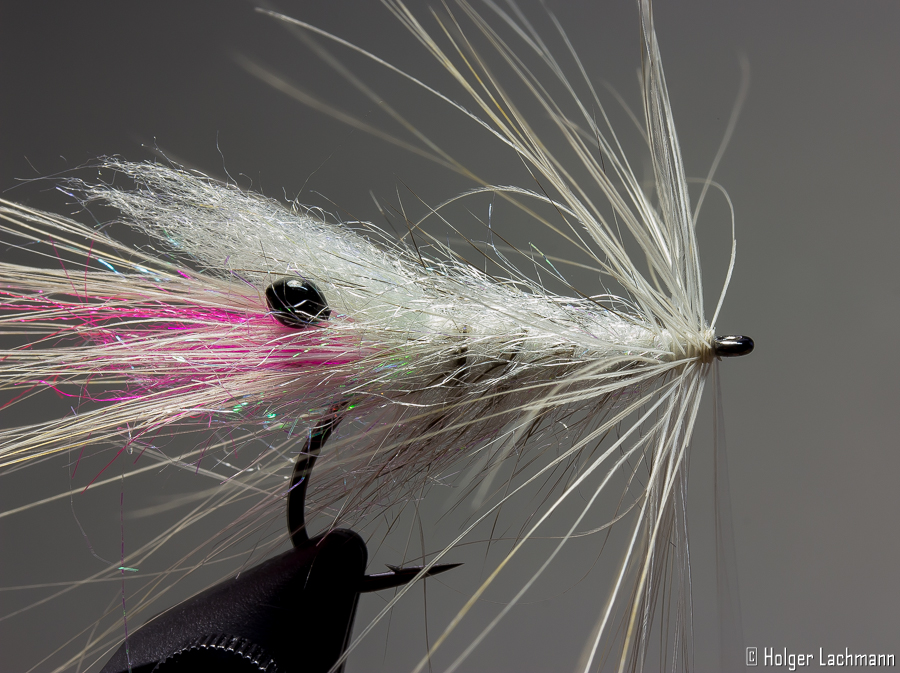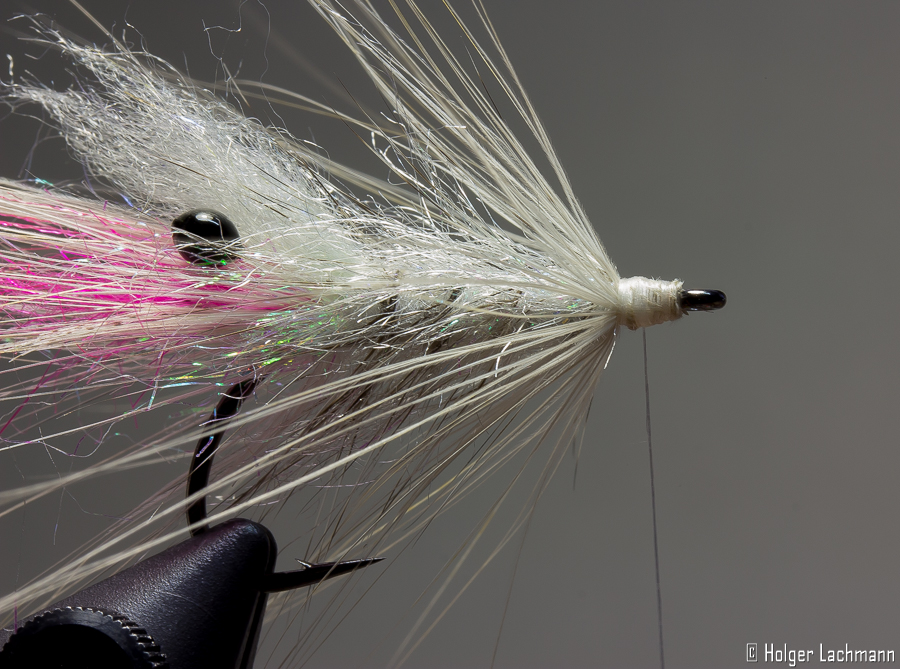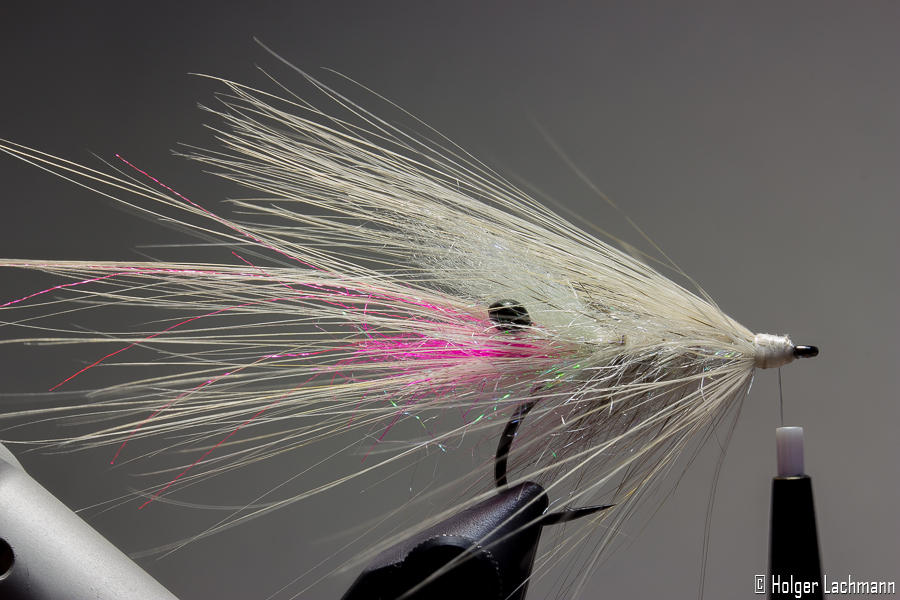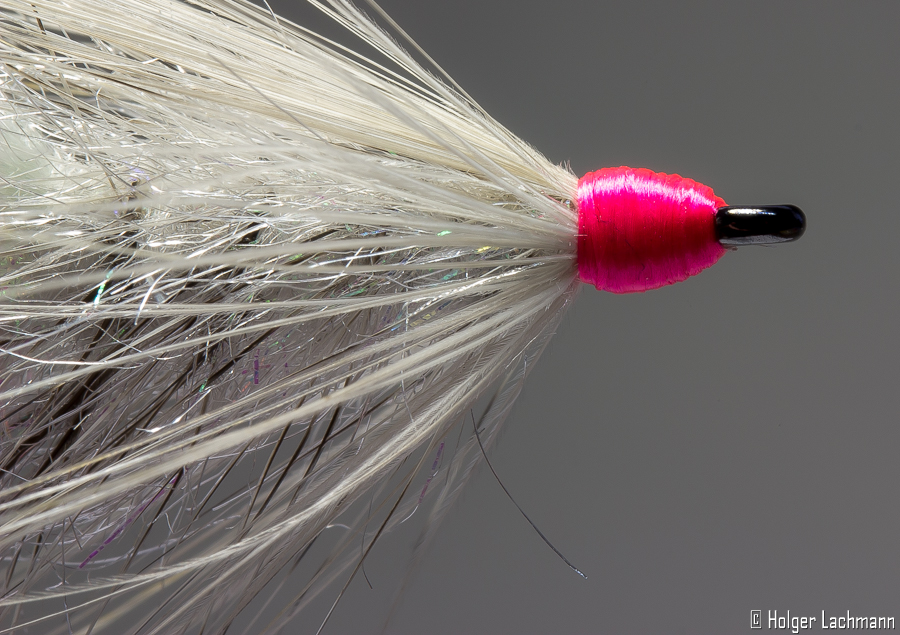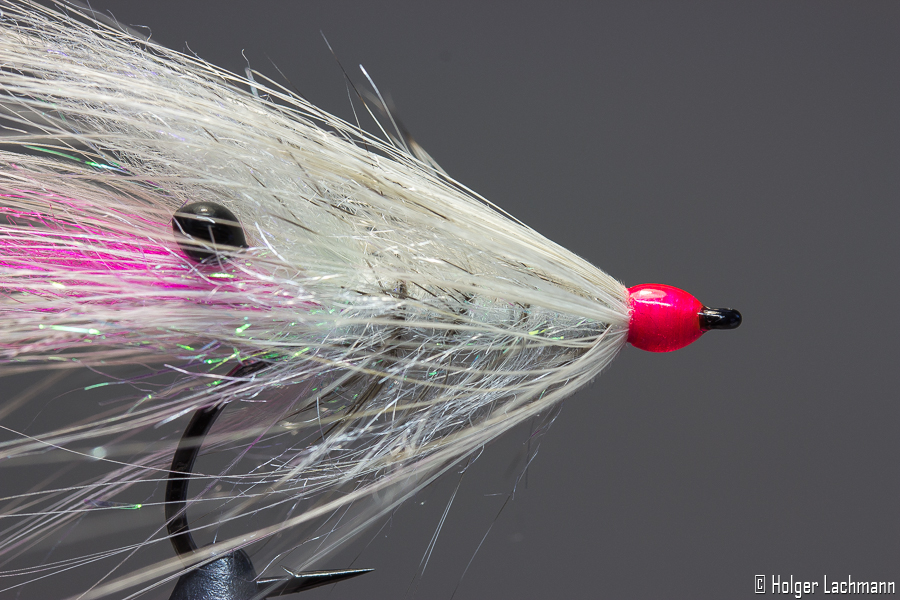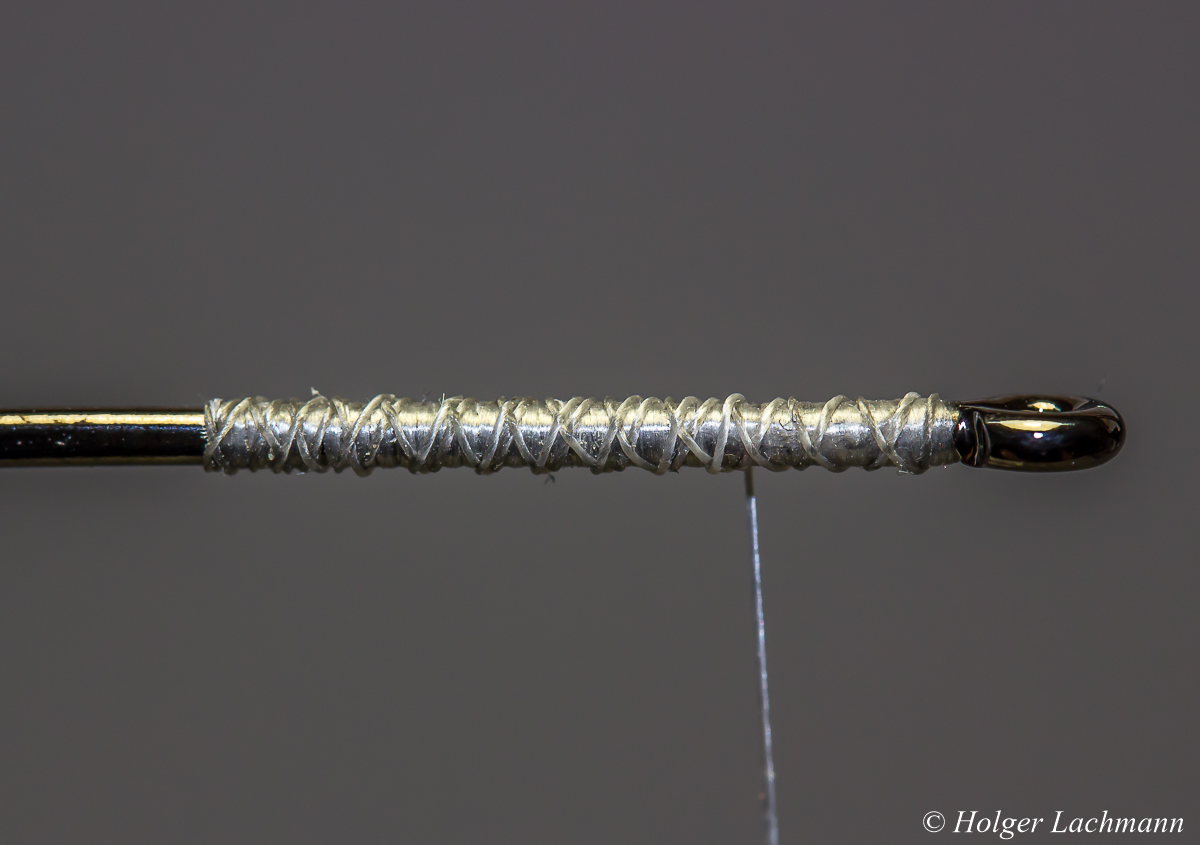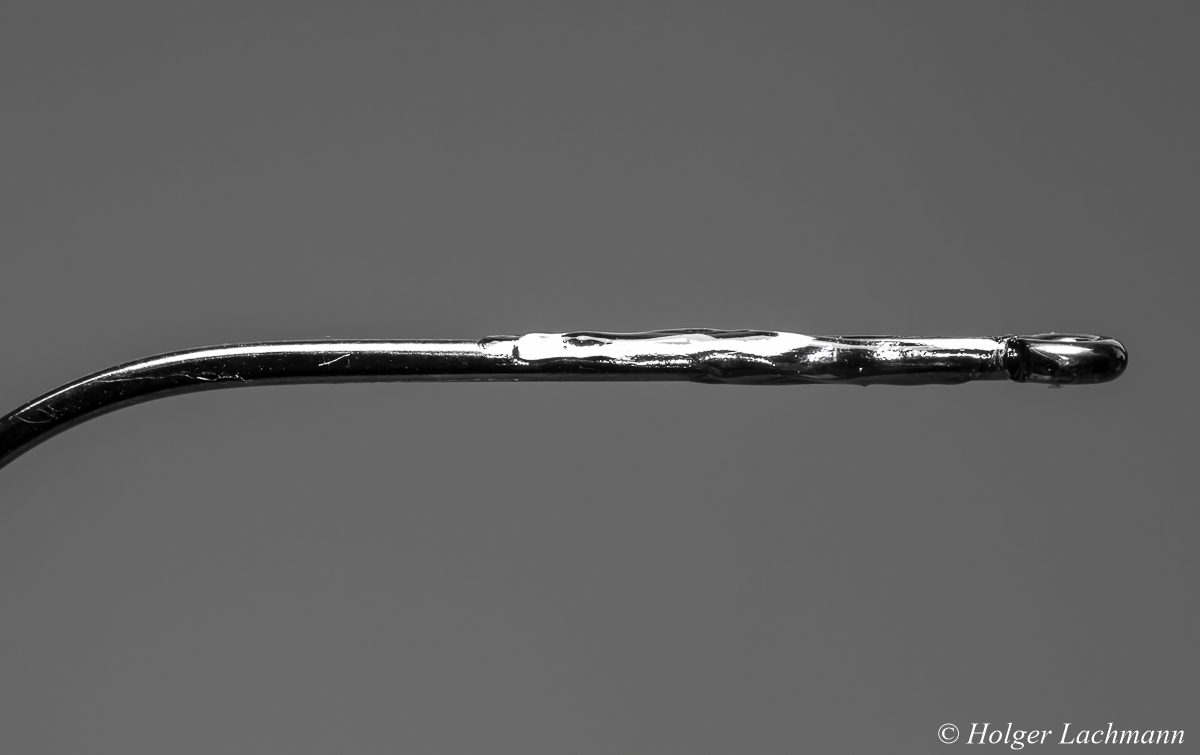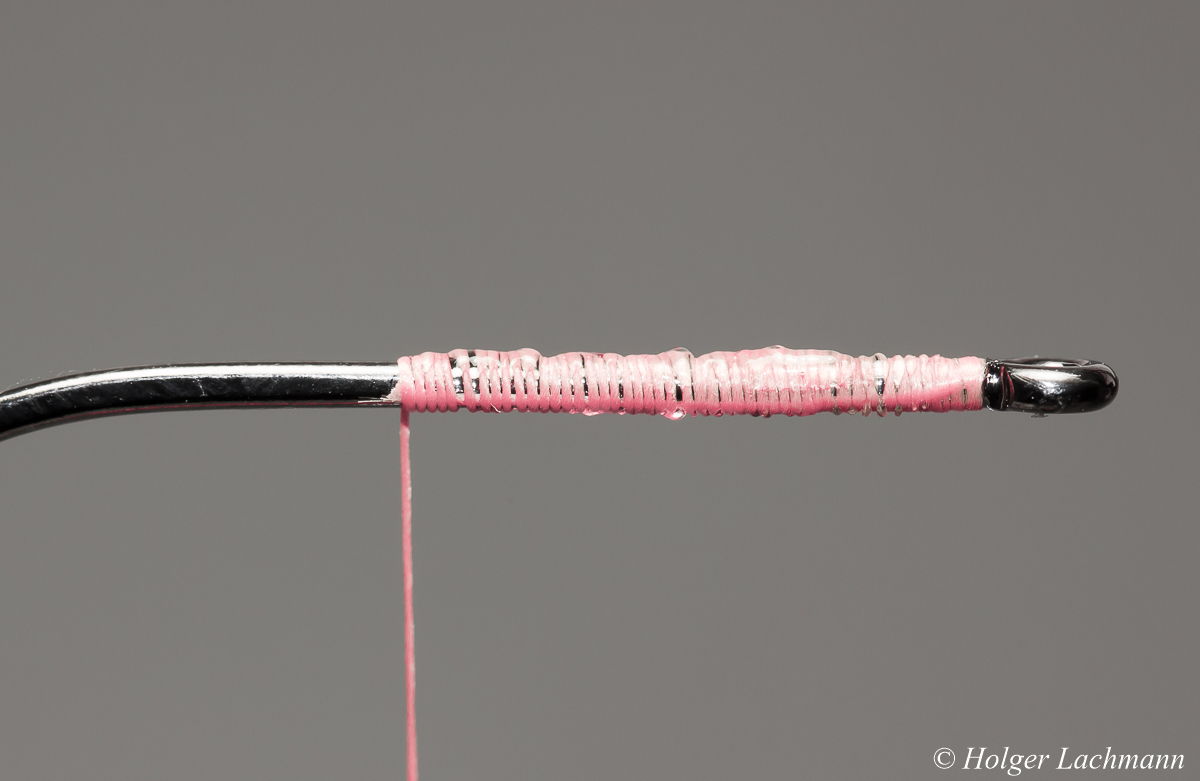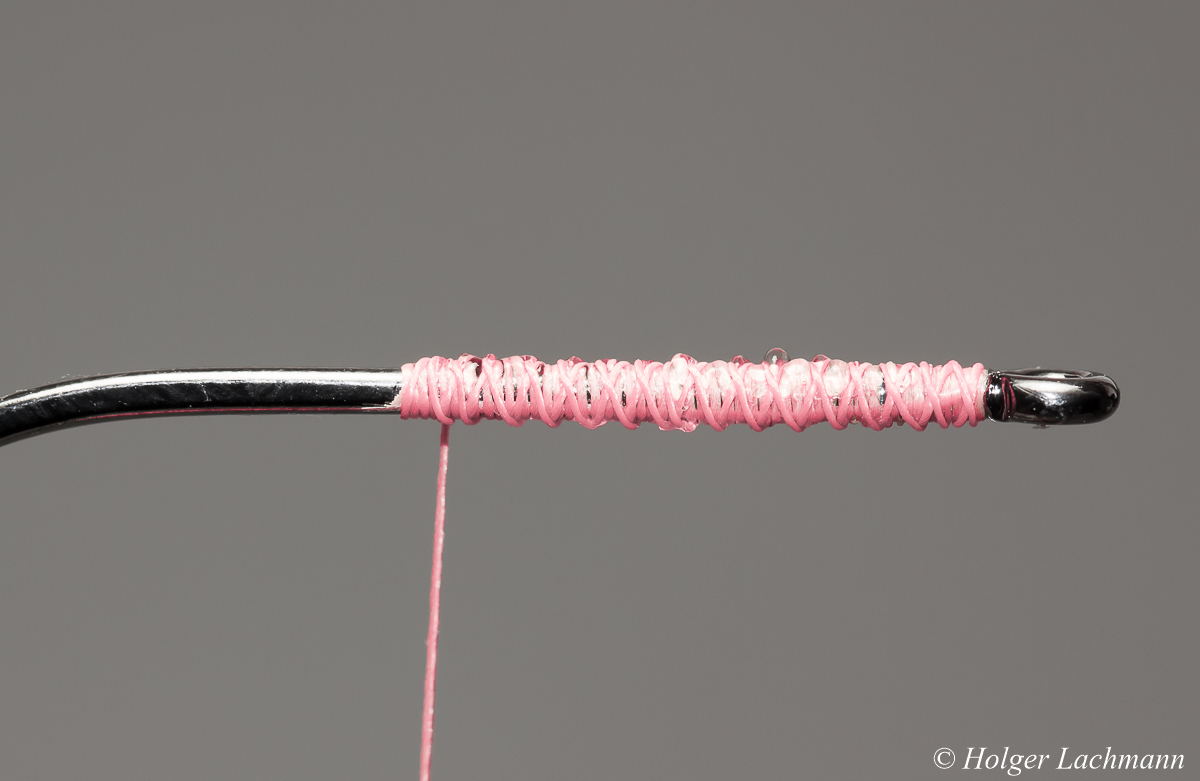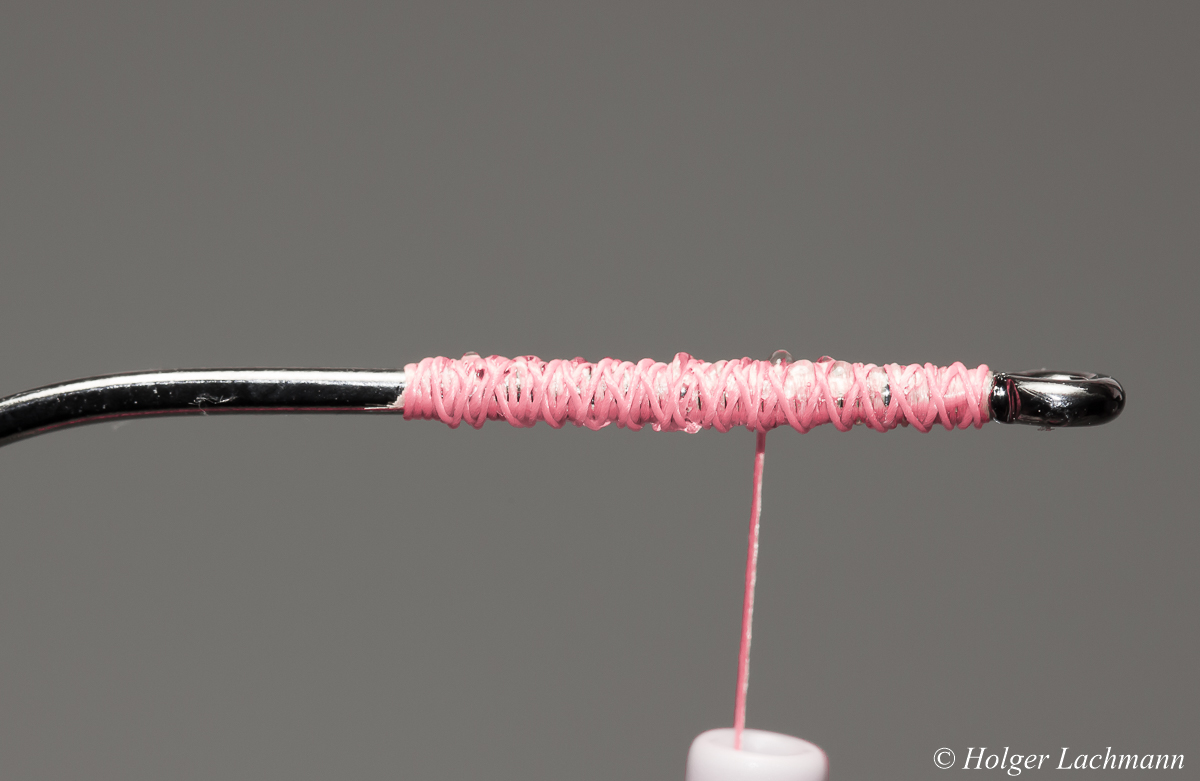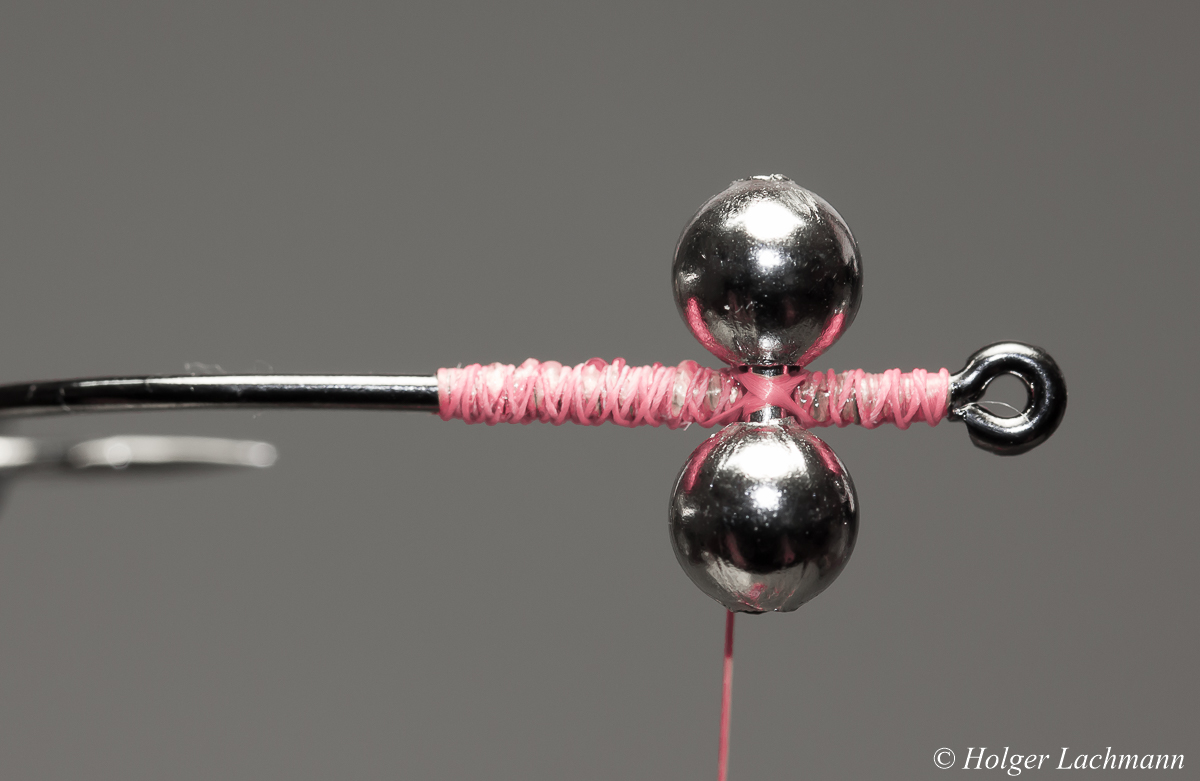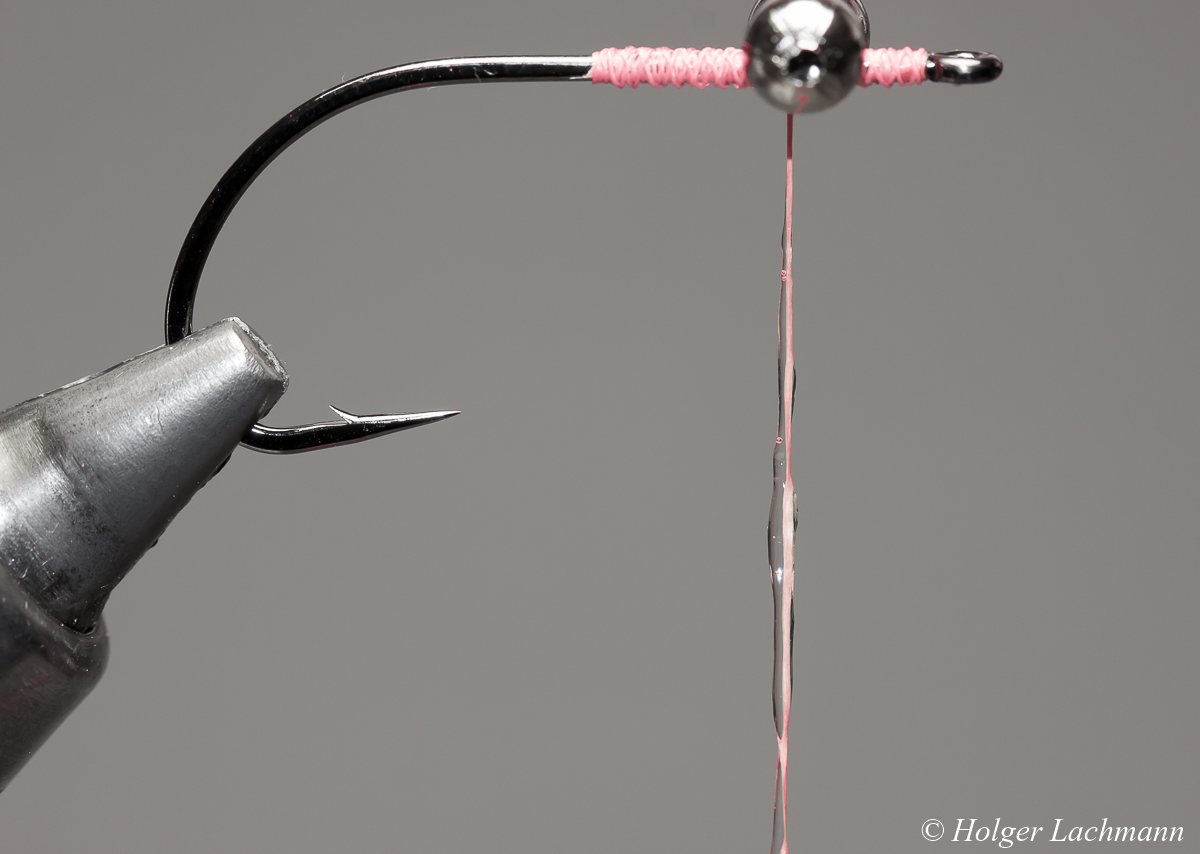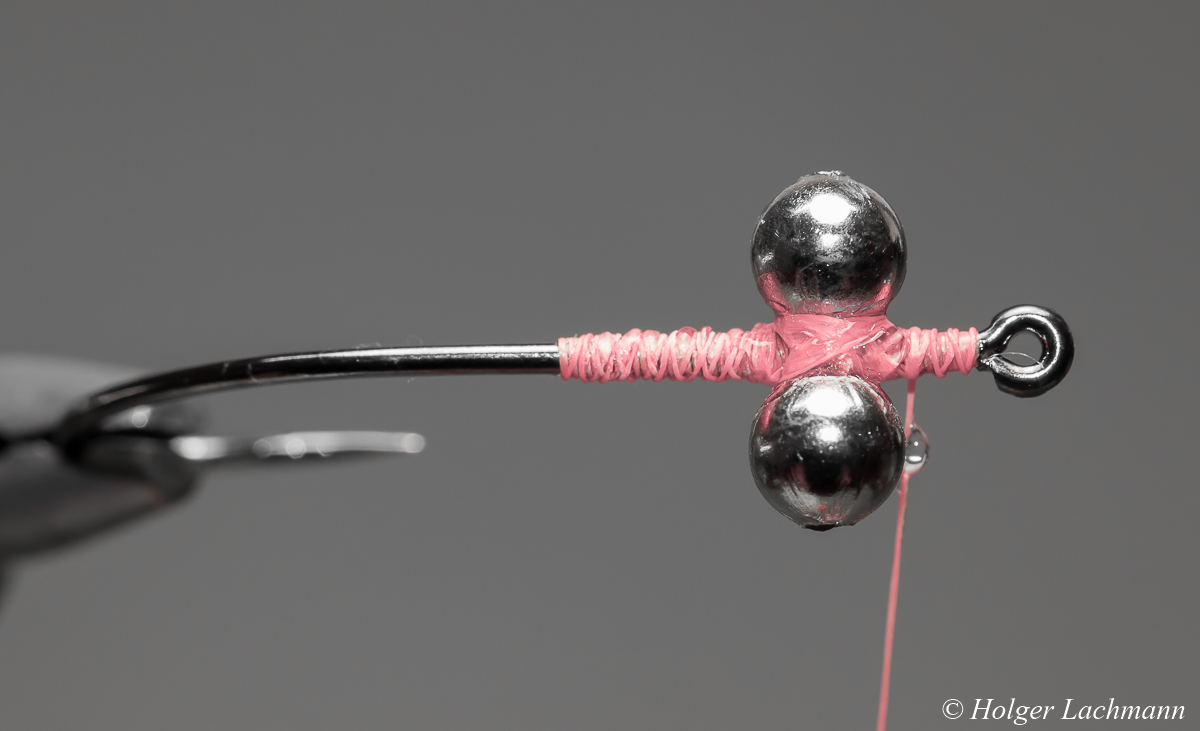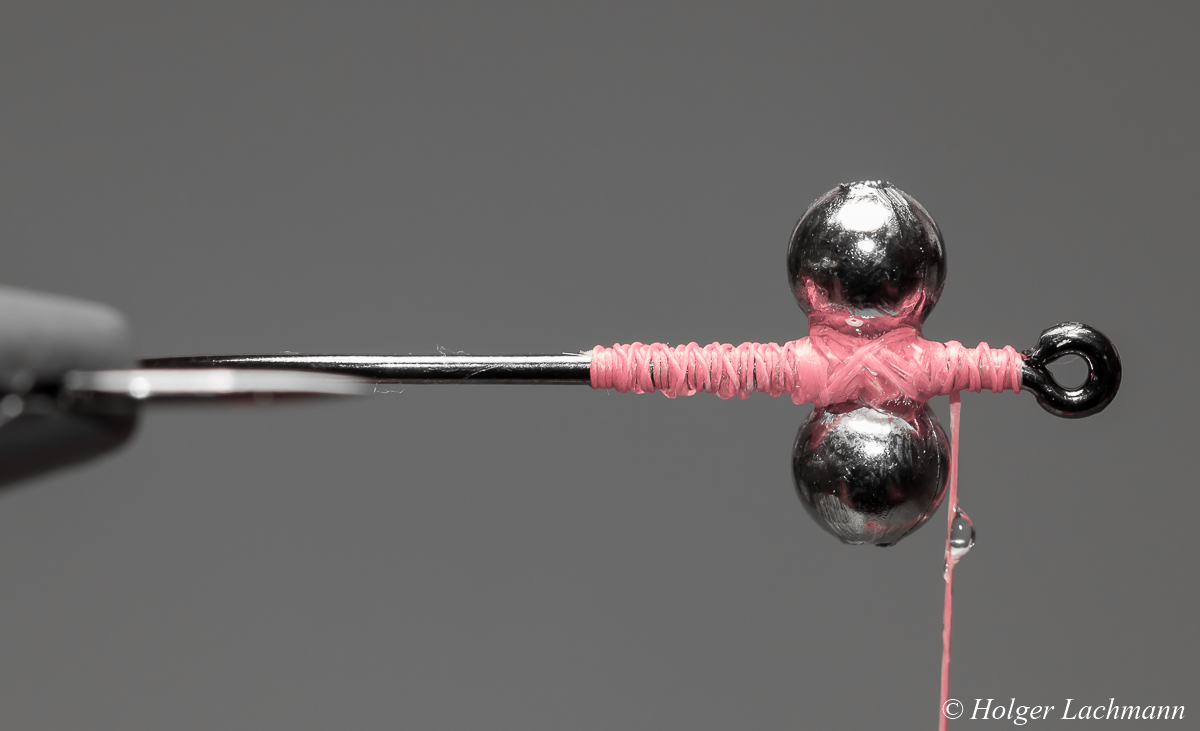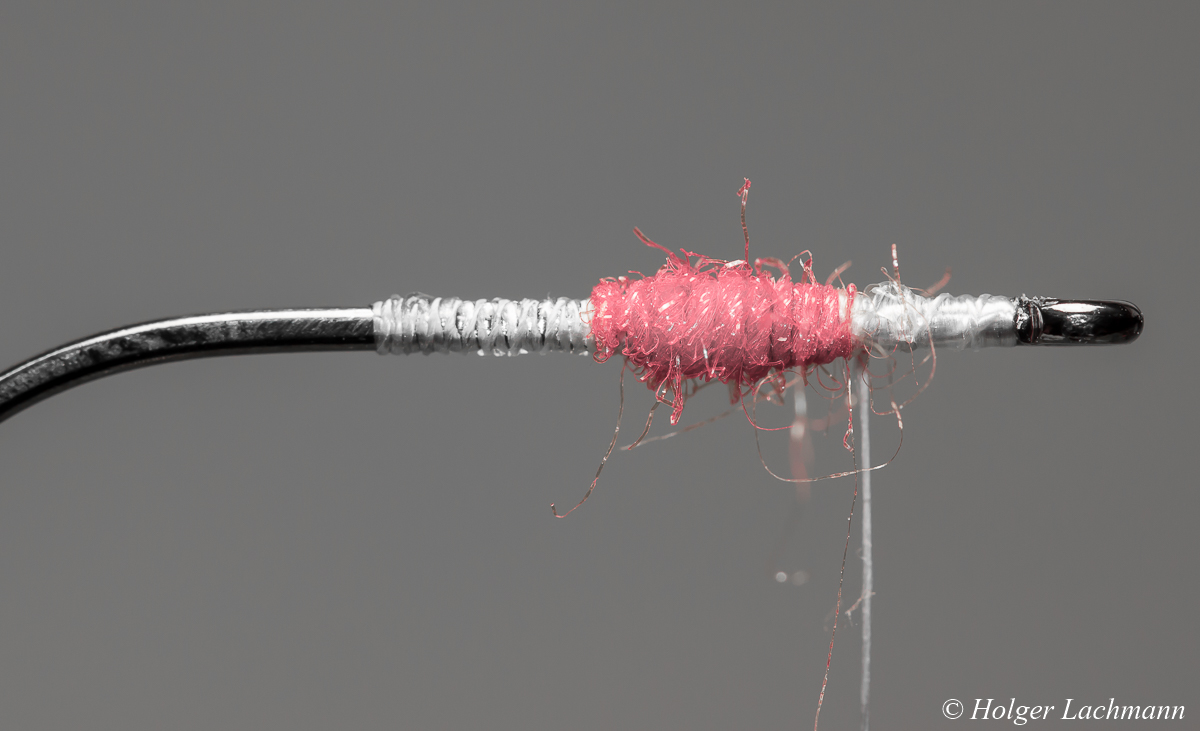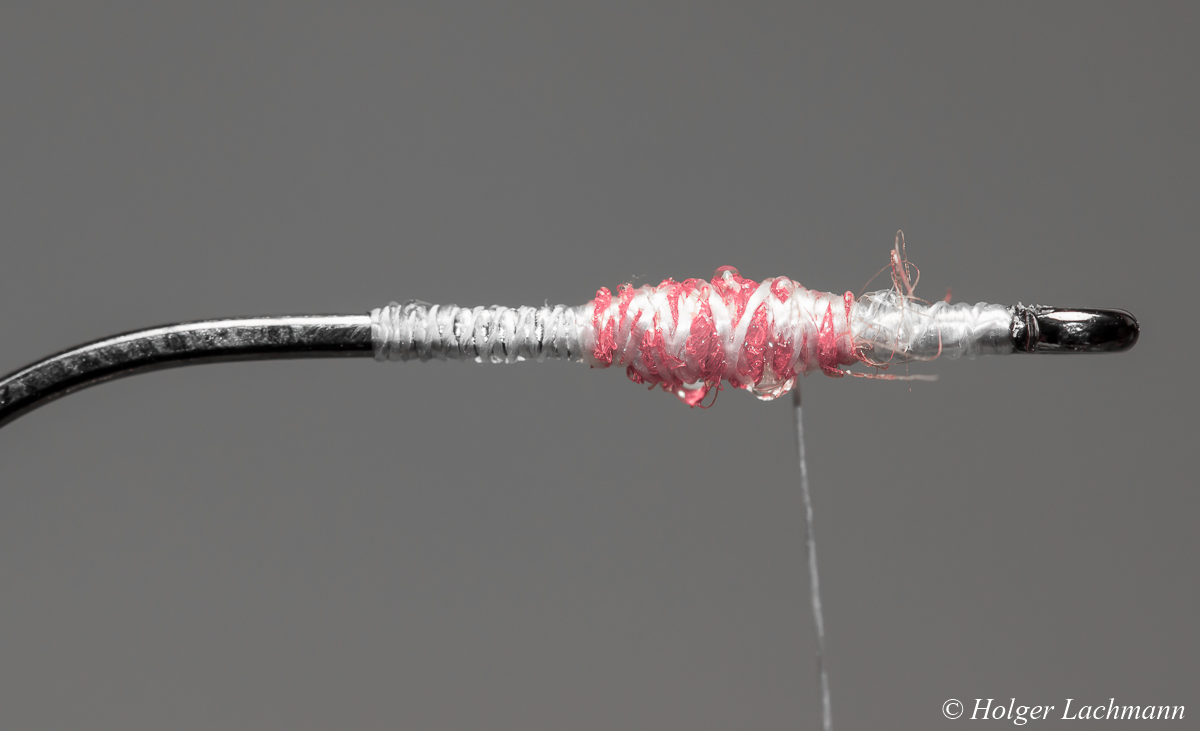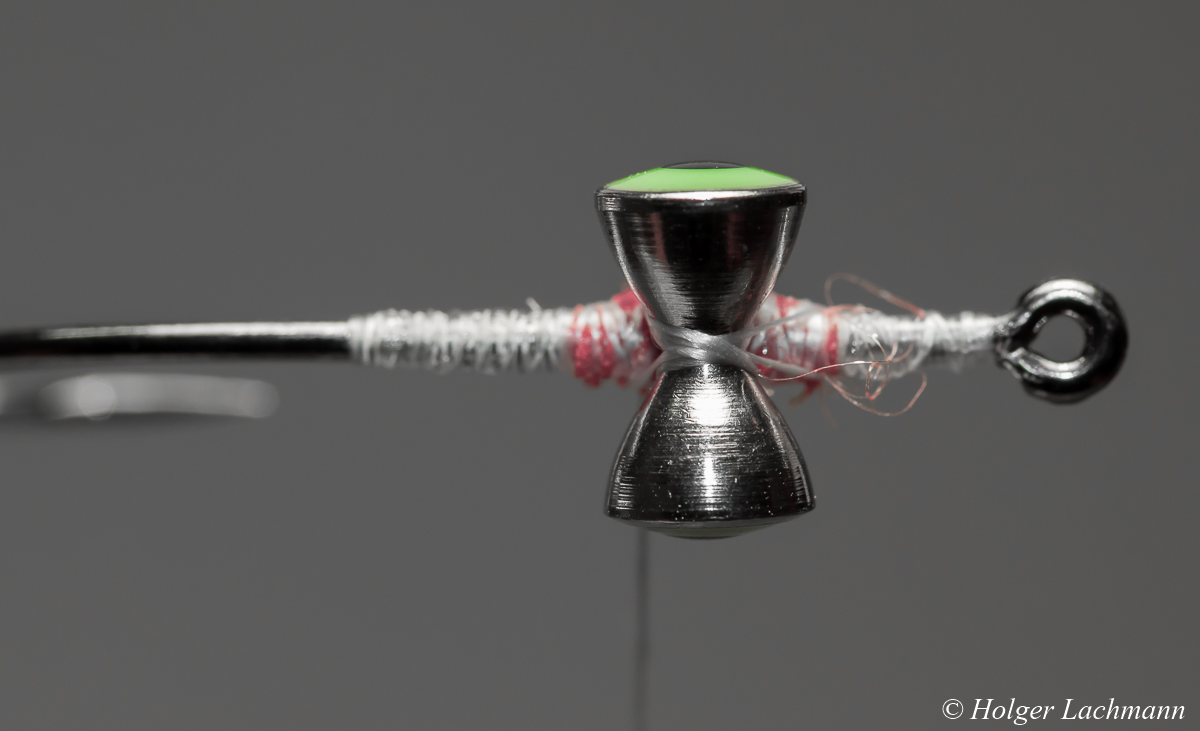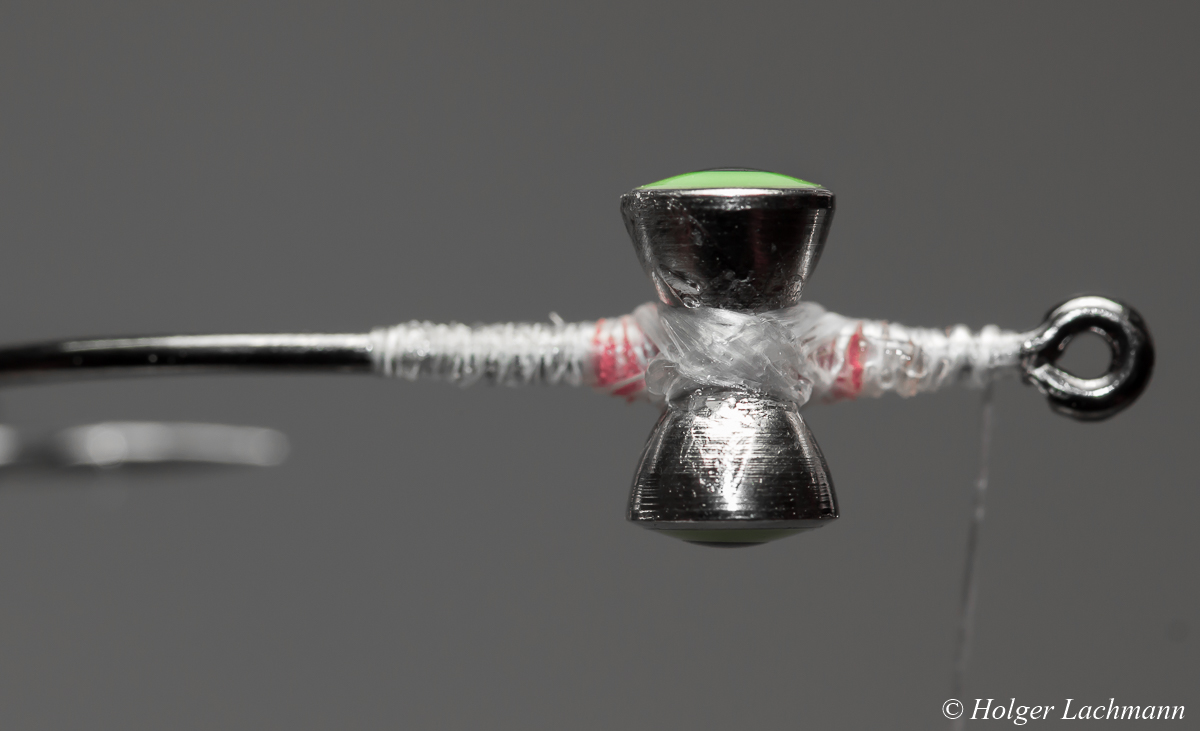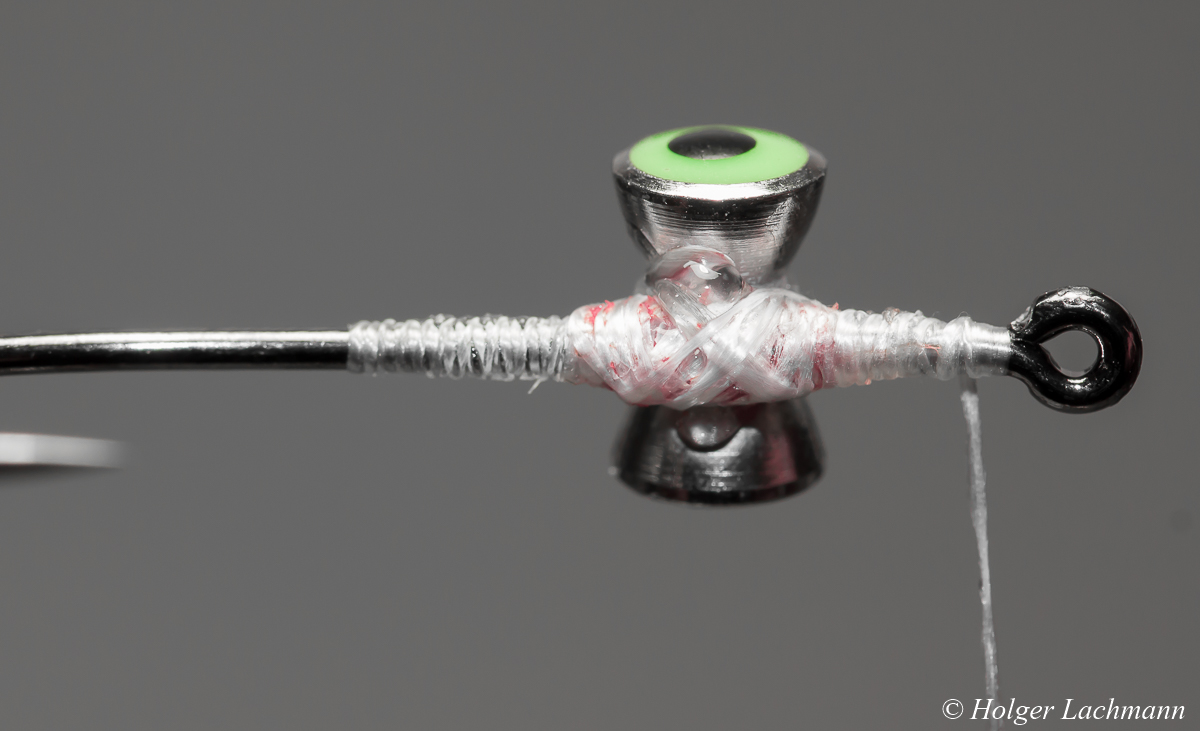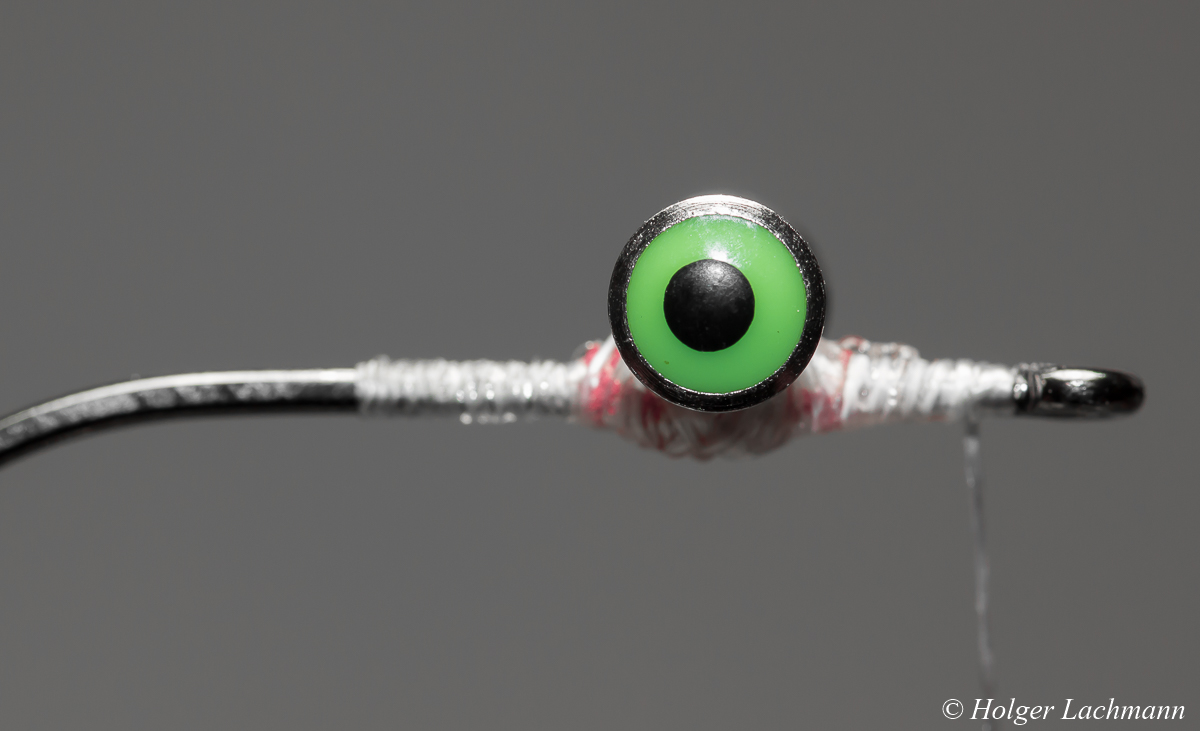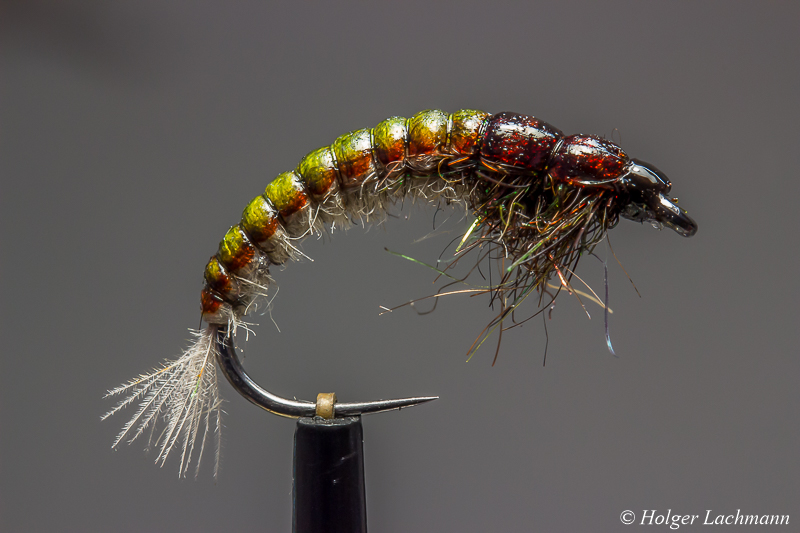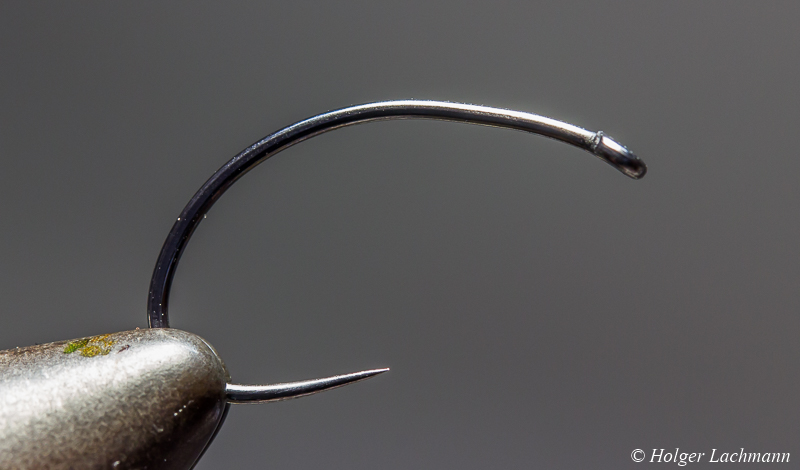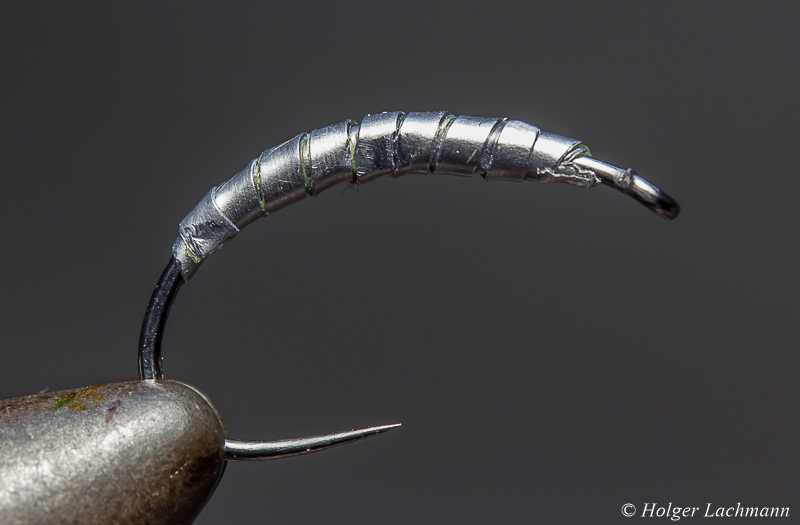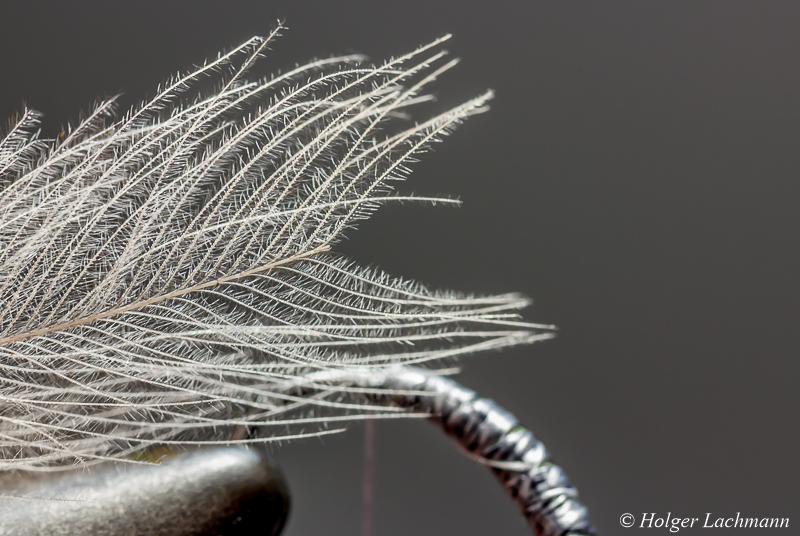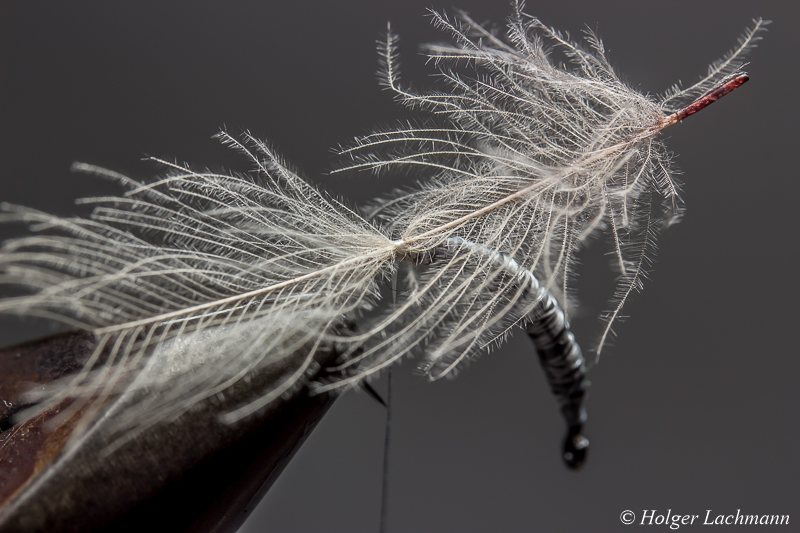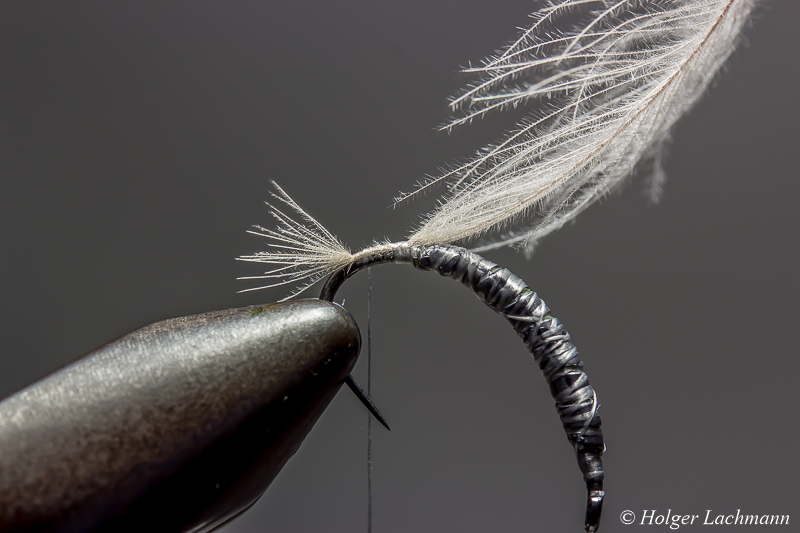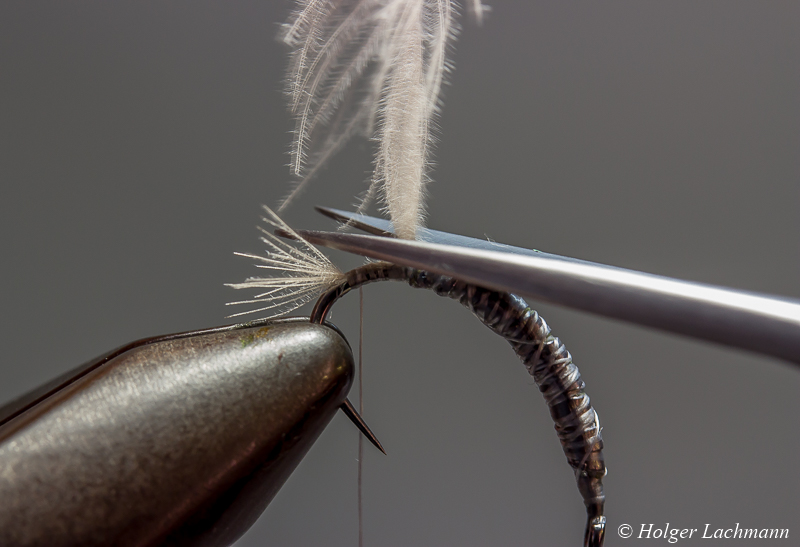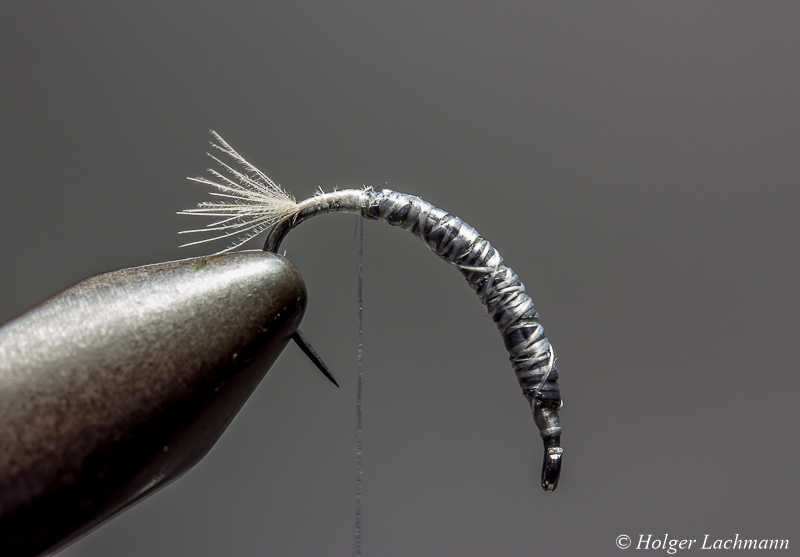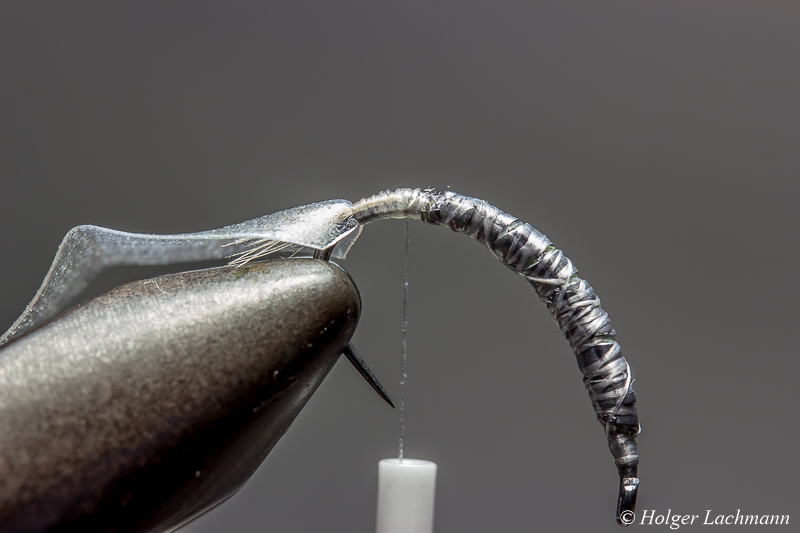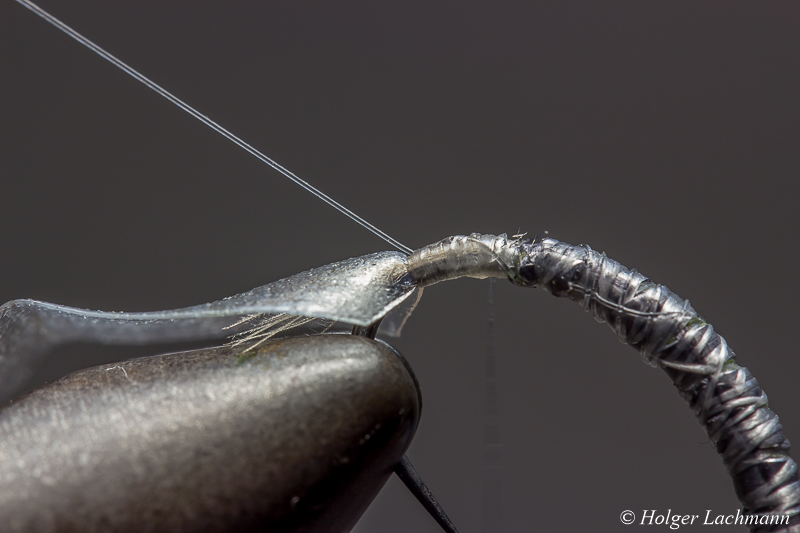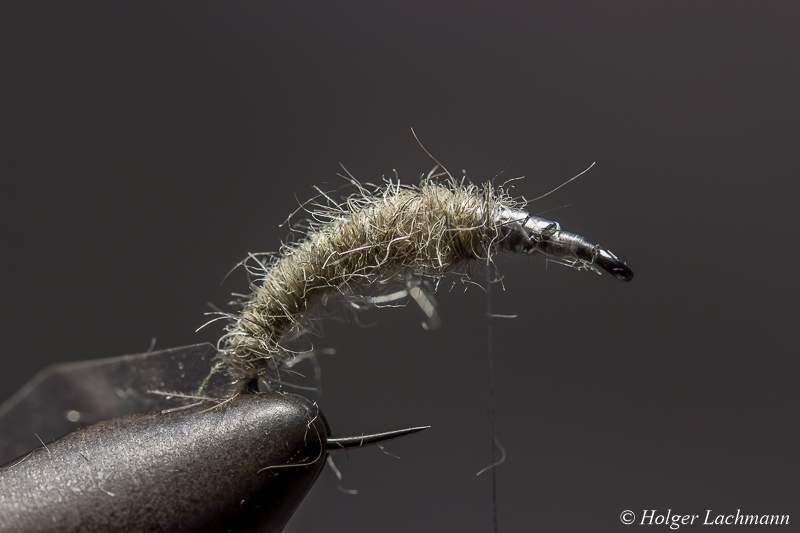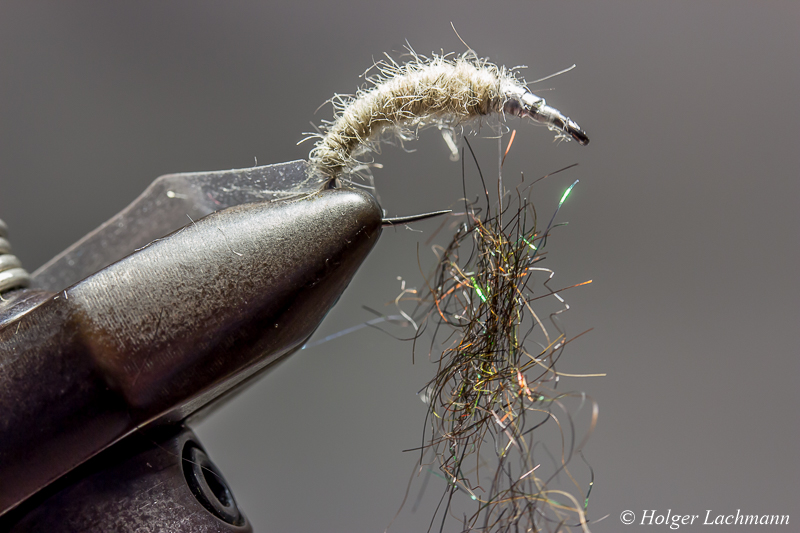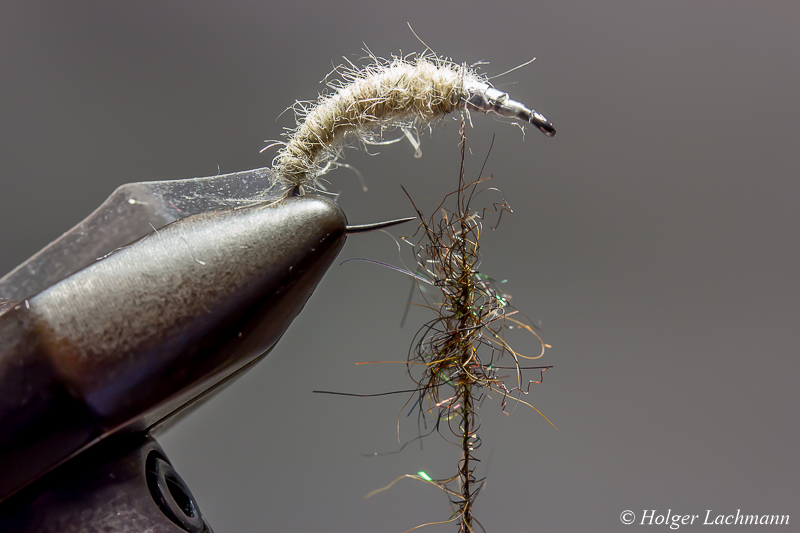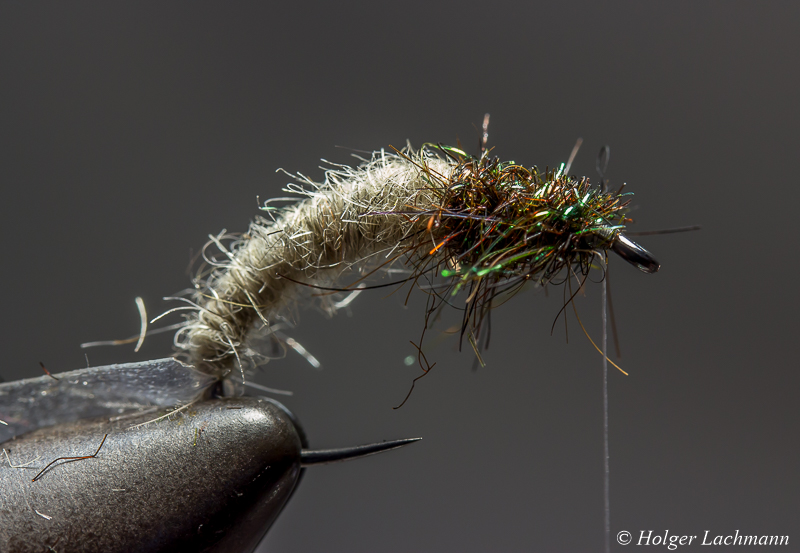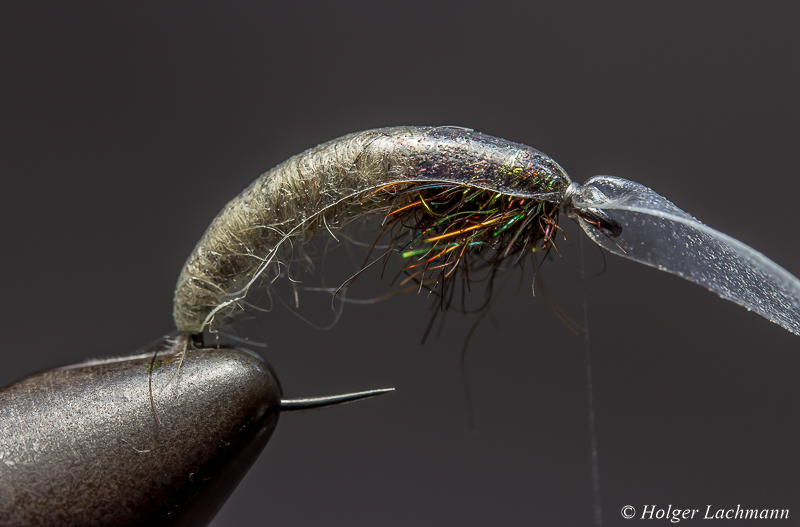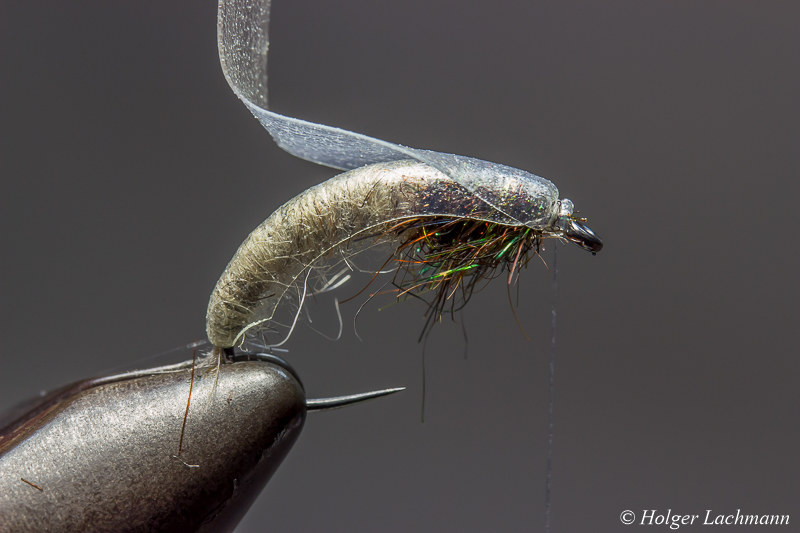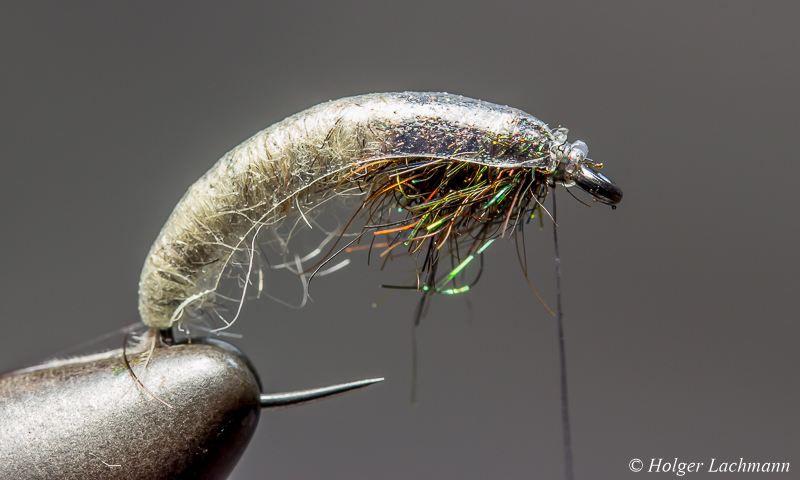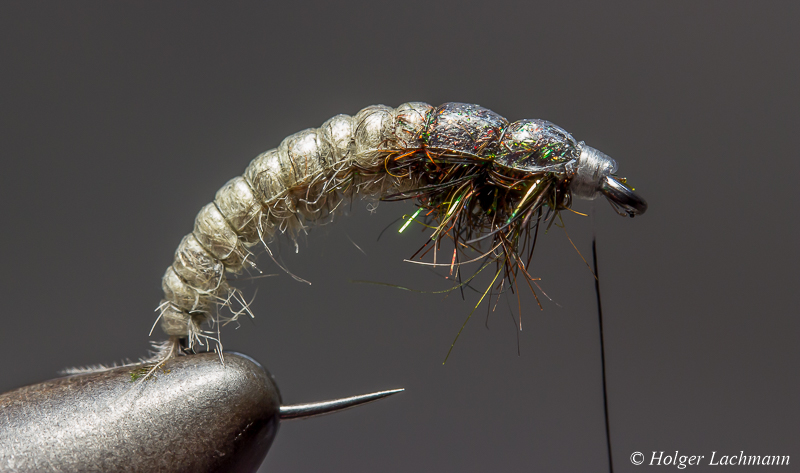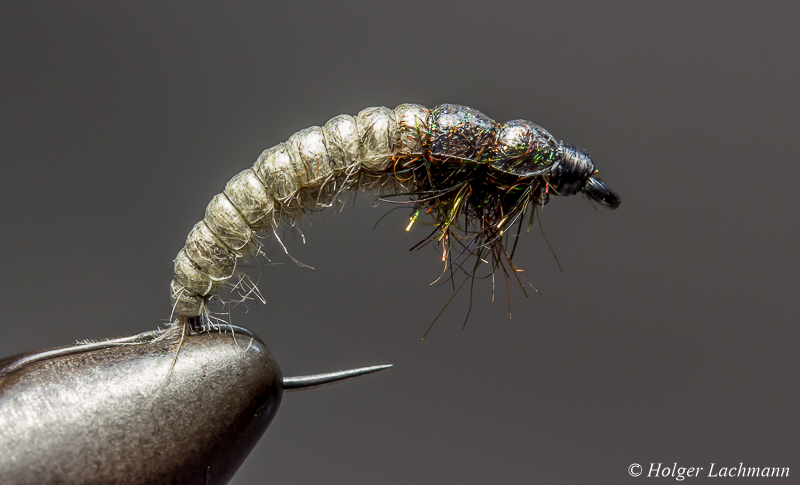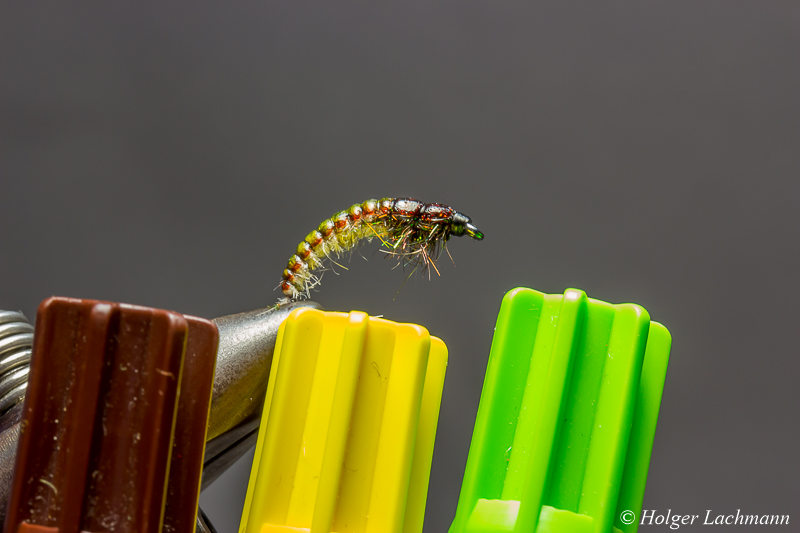Schlagwort-Archive: Step By Step
Black and Purple – a picture story
Finn Raccoon Pike Streamer SBS
Finn Raccoon is an awesome material for big pike flies. The long, soft hair moves really well in the water. It’s also very durable. If you don’t use too much of the leather it’s also not so difficult to cast, because the hair will not soak as much as water as rabbit fur for example does. You can cast it with your 8weight and a pike taper line with no problems.
The color combination ist just an example. To be totally honest, for this fly, I used the materials from another old fly with a damaged hook. Recycling the fly tiers way! ;-)
The hook is a good topic! I got some samples from the danish company AHREX hooks. They got my attention, because they brought some really nice hooks for streamer and especially for sea trout fishing on the market. Now, they also got a Predator line with big sized hooks for predators like pike. The hook I’ve used is really nice. A white gap, a not too heavy wire and a small fine barb. You can also get it as a barbless version. That’s a pretty cool thing!
For this SBS, I tied the fly with a head of Senyos Laser Dub to give it more volume. It pushes a lot more water. On the other hand, it’s a bit harder to cast. There’s another way to tie it. Just some eyes with uv resin between them to secure everything like shown on the first picture with the black collar.
- Hook: AHREX PR 350 Light Predator # 4/0
- Flash: Krinkle Mirror Flash orange
- Ribbing: Mono 0,50 mm
- Main Body: Finn Racoon Zonker orange
- Body: Kaktus Chenille and Polar Chenille twisted
- Front Collar: Finn Racoon white
- Head: Senyos Laser Dub white mixed with orange
- Eyes: 3D Eyes orange
- Thread: Veevus GSP 100 D white
- Bug Bond UV Resin, if you don’t want to tie it with a big head
Put a drop of super glue along the hook shank and do a spiral wrap back and forth, back and forth, back and…. to create a solid basement for the other materials.
Tie in some mono for the ribbing. I’ve used 0,50 mm.
As „tail flash“, tie in some krinkle mirror flash in different lengths.
For the body, I’ve used one strand of orange cactus chenille and two strands of white polar chenille.
Twist the strands like shown and wind it around the hook shank and catch it with your tying thread.
Take the Finn Raccoon strip and tie it in at the front.
With the mono, rib the fur strip from the back to the front with very high tension, so it won’t be destroyed by the pikes teeth.
Put some white Finn Raccoon in a material clamp or like I prefer in the Vosseler Clip Tool. Cut off the leather strip.
Make a thread loop and put some wax on it. Then put the Finn Raccoon hair into the loop.
Twist the loop with your dubbing twister. Don’t do it too fast and clear the hair from tangling from time to time with your dubbing needle. Wind it around the hook shank and stroke the hair back after every single turn.
Tie in some Senyos Laser Dub in the color of your liking. How you work with the Laser Dub is shown in several step by step tutorials in this blog. Just type „Senyos Laser Dub“ in the search field.
The finished Finn Raccoon Streamer for pike. Easy to tie, very durable and awesome in the water. I wish you a lot of fun tying and fishing it!
Translucent Shrimp Tying Video
[vimeo width=“600″ height=“500″]https://vimeo.com/175105808?ref=fb-share&1[/vimeo]
How to tie a Zonker Streamer – Video
„DETLEF“ Step By Step – aka TFFKAPF
The step by step tutorial about the PINK FLUFFY is destroyed. It don’t know why, but it was not shown right on the blog. So I did it again and I gave the fly a new name, because I didn’t like Pink Fluffy anymore.
So I called the fly „DETLEF“ – also known as the fly formerly known as PINK FLUFFY. Why? Don’t know , it just fits.
[vimeo]https://vimeo.com/150781439[/vimeo]
You can fish for sea trout even in the winter time. It’s a very hard kind of fishing with temperatures sometimes under 0°C, but there is a chance to catch an awesome „Silberbarren“. It’s common knowledge, that sea trouts like the color pink, especially in the cold season. It’s also common knowledge, that sometimes, the sea trouts like a very slow retrieve. For that situations, the DETLEF is a really good choise. The soft materials move very nice in the water, even if you strip the fly in very slowly. On the other hand, it’s not very complicated to tie and when you use other colors like beige, tan and brown, you got a very nice shrimp pattern for the rest of the year.
One very important point: Don’t use too much material! Less is more!
Materials used for this fly:
- Hook: Gamakatsu F314 # 6
- Weight: Lead Wire fine
- Dubbing: Ice Dub Pearl, SLF Saltwater Dubbing Pink and SLF Saltwater Dubbing White/ Pearl
- Front: Mallard, Pink Hackle Fibres
- Antennas: Fluoro Fibre Pink
- Eyes: Selfmade Shrimp Eyes
- Horn: Polar Dub White Transparent
- Loop-Hackle: White CDC and Pink Hackle
- Back: Mallard
- Thread: Veevus GSP 50D White
Do a little drop of superglue on the shank and wind on some fine lead wire.
Form a little dubbing ball with the ice dub at the end and tie in some fibres of Mallard.
Take a bit of pink SLF and tie it in.
Take some long soft fibres from a pink hackle and tie them in as shown. Add some strands of pink Fluoro Fibre antennas.
Dub a little ball with Ice Dub and tie in the shrimp eyes. The dubbing ball will seperate the eyes in a nice way.
Take some Polar Dub in white and tie it in as a horn.
Form a thread loop and then dub the body with the SLF.
Put a big white CDC feather on the Petitjean Magic Tool and push it in by using a pink hackle.
Grab the fibres with the clamp of the Magic Tool and and cut off the stems. Then put the fibres in the waxed thread loop and twist the loop.
Wind the hackle fibres-CDC-Mix around the body and catch it with your thread.
Some fibres from a Mallard feather will be used for the back of the fly. So, the fly swims in the right position and the black/white gives a great extra contrast. Do one or two whip finish and use some varnish to secure the knot. That’s it! Detlef is ready!
„Der Loppo“ Step By Step Tutorial
I was asked so often in the last time for a step by step tutorial for the Sea Trout fly „Der Loppo“, that I finally made one.
This fly isn’t something „brand new“, „the next revolution“, „the game changer“ or anything like this. It’s just a mix of some ingredients of good flies mixed together to a fly, which I personally like and in which I put my faith when fishing. I made flies for my fishing in the past, which looked quite similar, but this is the final outcome.
Its got a nice semi translucency, it’s not too bright and not too unimpressive. You can tie it in different colors. I also like tan/white and orange as a color combination very much.
This example fly is tied on a hook size 4, but you can also tie it in size 6 with shorter fibres, when you want to fish it slower and the Sea Trouts just nibble on the longer fibres.
I even got a variation with black hackles and hot orange trigger points for murky water… looks very cool, too!
Ok, let’s start the step by step with a list of the materials:
- Hook: Gamakatsu F314 #4
- Weight: Lead Wire or substitute
- Dubbing: Ice Dub Pearl, SLF Saltwater Dub White/Pearl
- Mouth Part: Mallard and SLF Dub Pink
- Hackles: Whiting Spey Hackle and a Grizzly Hackle stripped on one side
- Horn: Senyos Laser Dub Gray
- Antennas: Fluoro Fibre Pink
- Eyes: Mono Eyes selfmade
- Ribbing: Mono
- Thread: 50D GSP white and 70D Uni Fluo Pink
Put the hook into the vise and wind the lead wire arounf the shank. To secure the lead, you could use a little drop of super glue. Attach the thread and form with the Ice Dub a little tight dubbing ball at the end of the shank.
Tie in the Mallard and the pink SLF as „mouth parts“.
The first spey hackle should be tied in like shown. It’s easier to wind it around this way. Go back with your tying thread to the little bump and secure so the thin fragile stem of the spey hackle. For a little extra color, tie in some Fluoro Fibres in pink.
I like to tie in some extra long hackle fibres for the extra movement. If you think they are too long, just skip this tying step.
Split the thread and put some Ice Dub in the gap, then twist the bobbin and wind the dubbing around. After that, give the dubbing a brush with your velcro.
Now the eyes and the mono for ribbing should be tied in.
For the horn section, tie in the Laser dub and do a first turn with the white/pearl SLF Saltwater Dub.
Tie in the grizzly hackle which was stripped on one side and dub the body using the SLF Saltwater Dub. Wind the grizzly hackle to the eye and leave enough space for the final hackle. Secure the hackle by ribbing the body incl. the hackle with the mono and catch it with the tying thread. Don’t forget the ribbing! ;) At the end, give the body and the hackle a strong brush with your velcro. The mix of hackle and SLF looks really cool in the water.
Wind around the second spey hackle and again secure the stem with your thread. It doesn’t matter, when in looks a bit bulky.
Take some extra spey fibres and tie them on top as a back. Looks in the water like the shrimp shell and makes sure the fly will always swim straight.
Do a whip finish with the GSP thread and cut it of. Then do a nice head using the fluo pink thread as a trigger point. Varnish the head or use Bug Bond uv resin to get a nice, shiny head.
That’s it!
Der Loppo ist fertig! :) I wish you a lot of fun tying and fishing this fly!
Worm Fly Step By Step
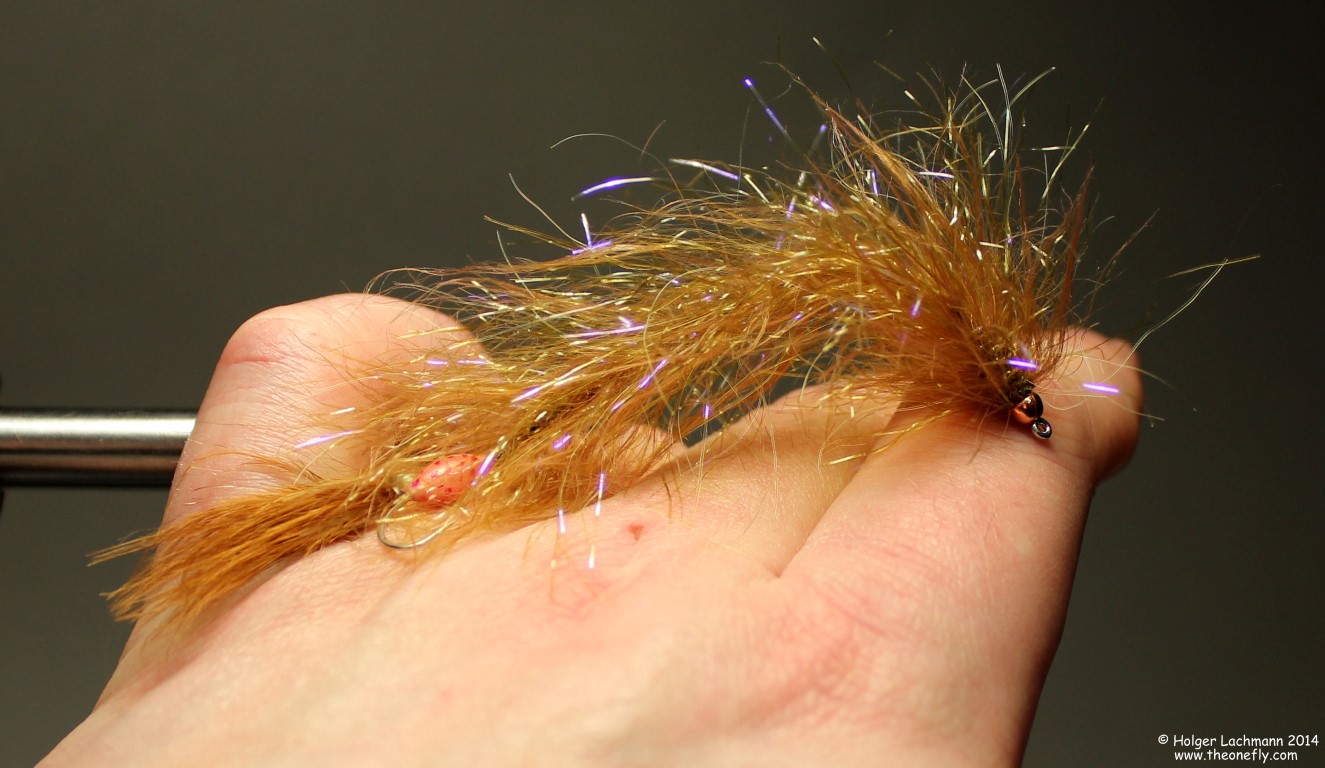
Every spring, the bristle worms (kind of a annelid) swarming in the Baltic Sea and the sea trouts are feeding like crazy on these worms and you really should have a worm pattern in your fly box, because you’ll never now, when the swarming will start. This worm pattern moves fantastic in the water and it’s worth the effort, even if a normal wooly bugger will catch fish. If you have tied one or two, you’ll see, that it’s really easy and fast to tie once you know how.
The first one who showed me this awesome technique to tie these worms was the master fly tyer Andy Weiß, one of the most creative fly tiers in the world and I’m glad to call him my good friend! He showed me a lot of tips and tricks over the years and I had some really cool and funny moments together with him in the last years. Andy, if you read this…what can I say…. cheers my friend!
Ok, back to business!
Here are the materials I’ve used:
- Hook: Gamakatsu SC 15 #2 and #4 in the back
- Thread: Dyneema thread white and UTC Ultra thread 70 fl. shell pink
- UV-Resin: Bug Bond
- Coloration: Marker Pen pink
- Tail: Marabou brown
- Body: Dyneema fishing line, UV Polar Chenille olive brown, Worm Wool brown (knitting wool)
- Weight: Tungsten bead
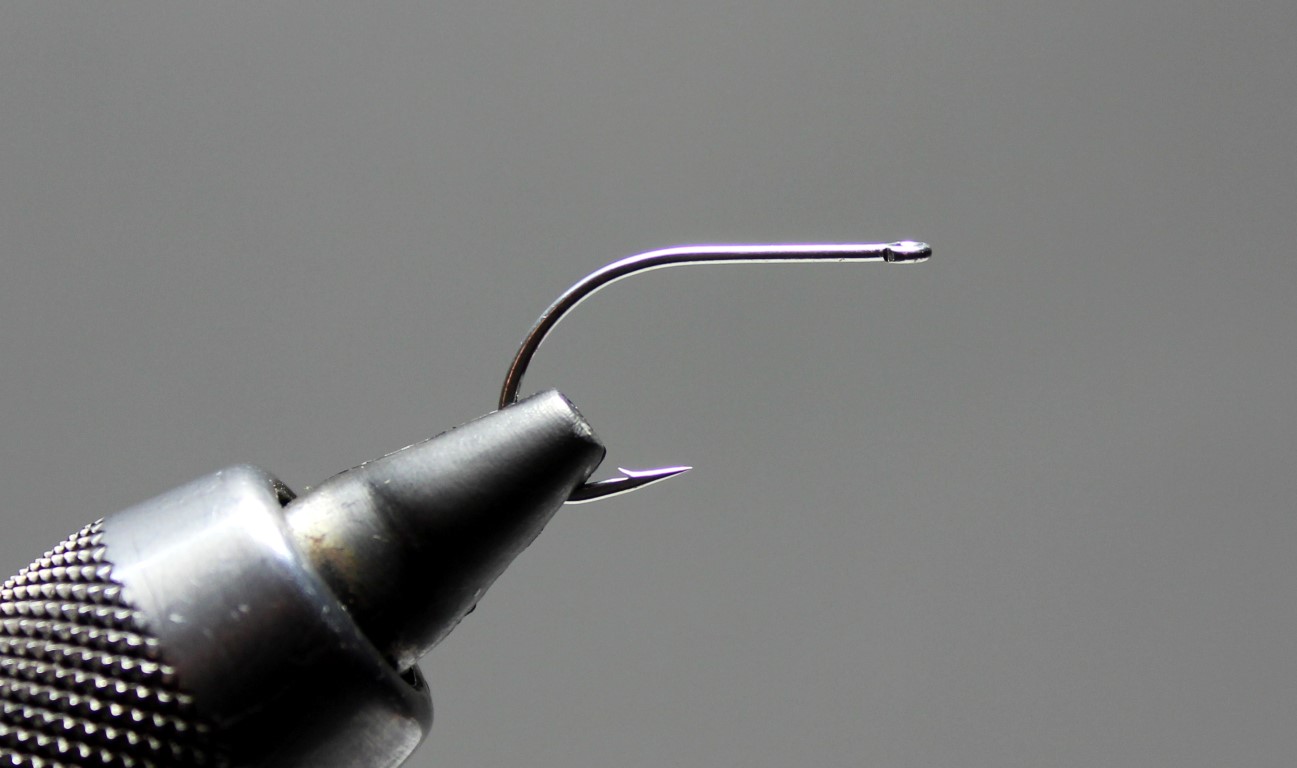
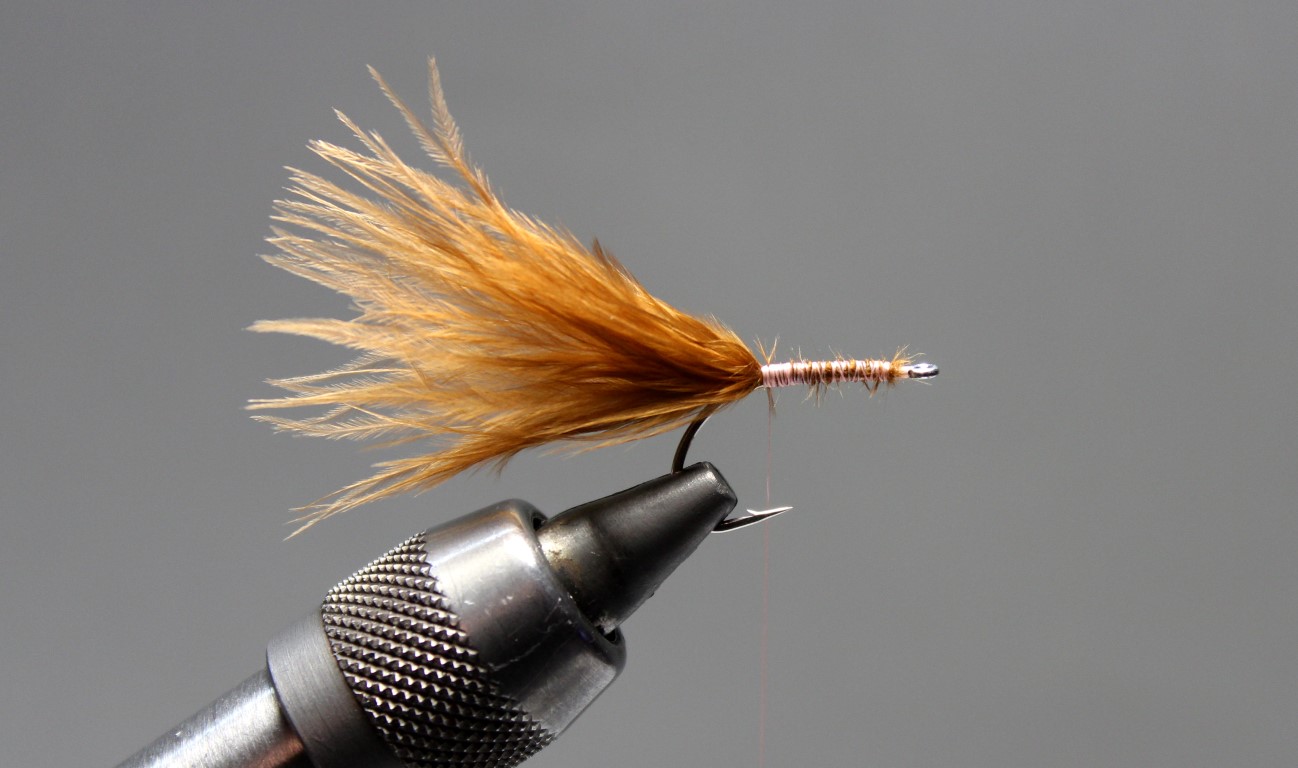
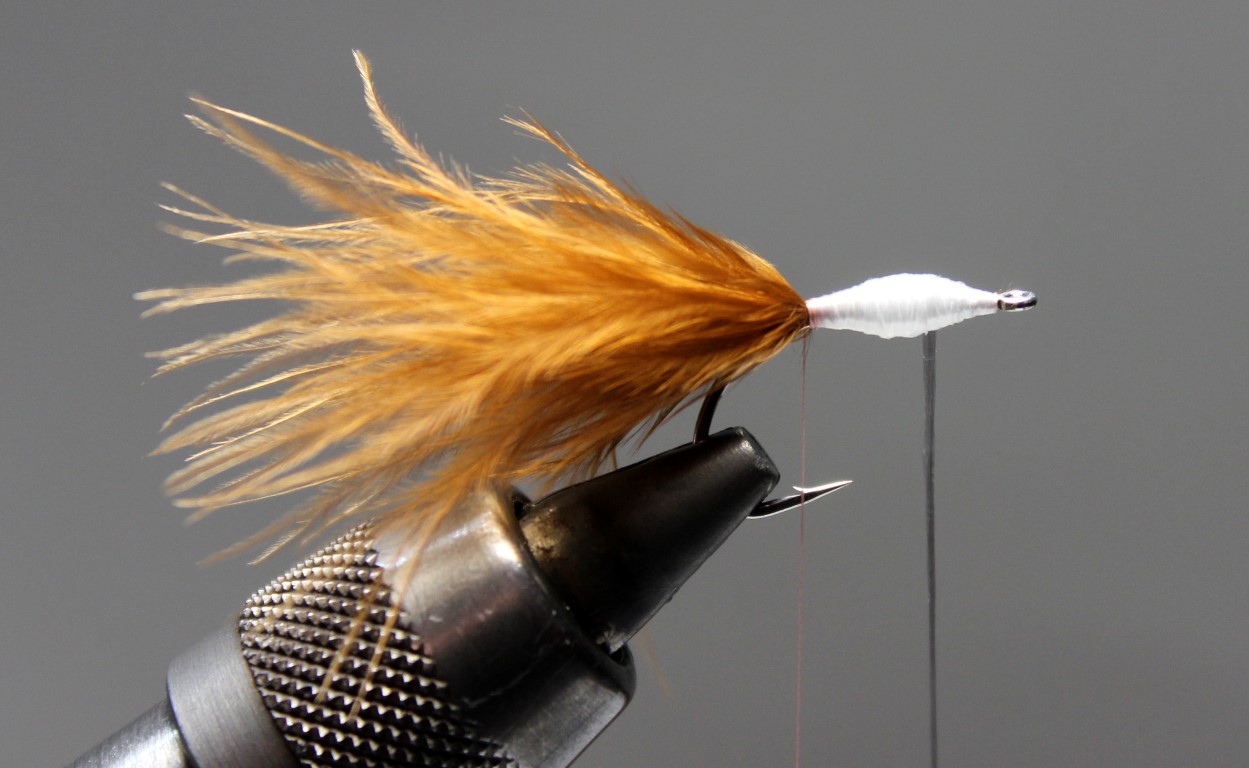
Put the hook into the vise and tie in a bunch of marabou. Build a kind of bubble on the hook shank. It’s easier to do it with a thicker thread instead of your normal tying thread.
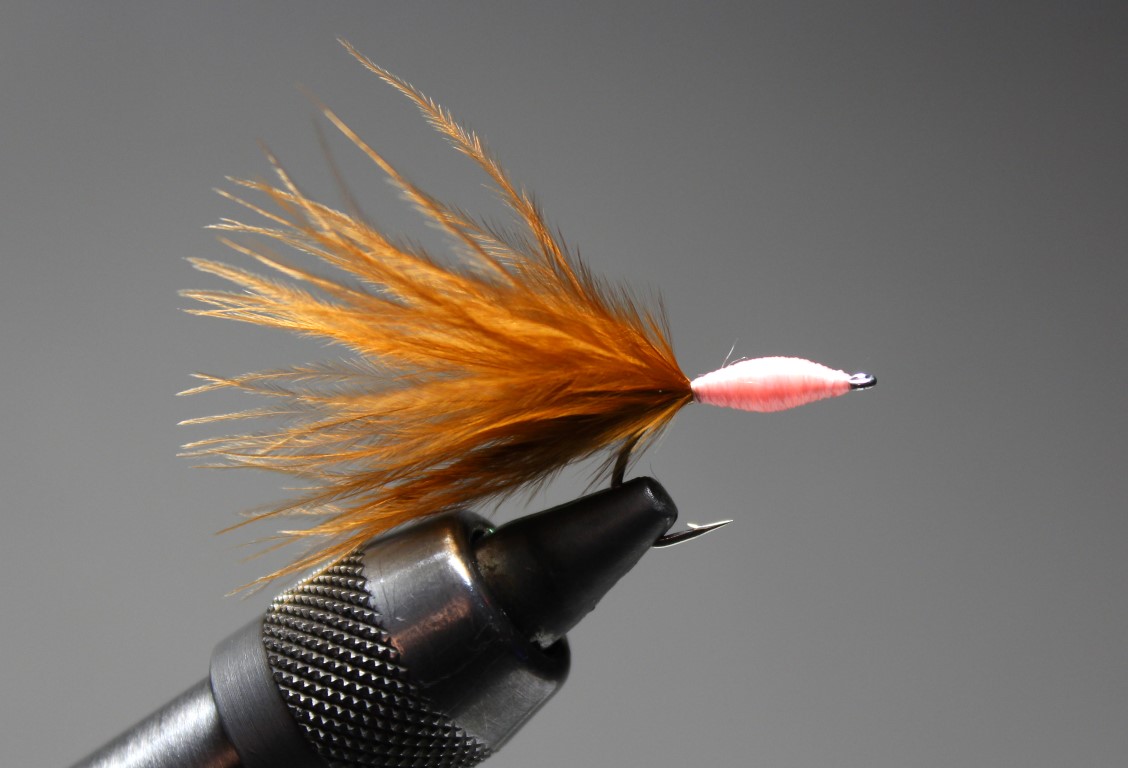
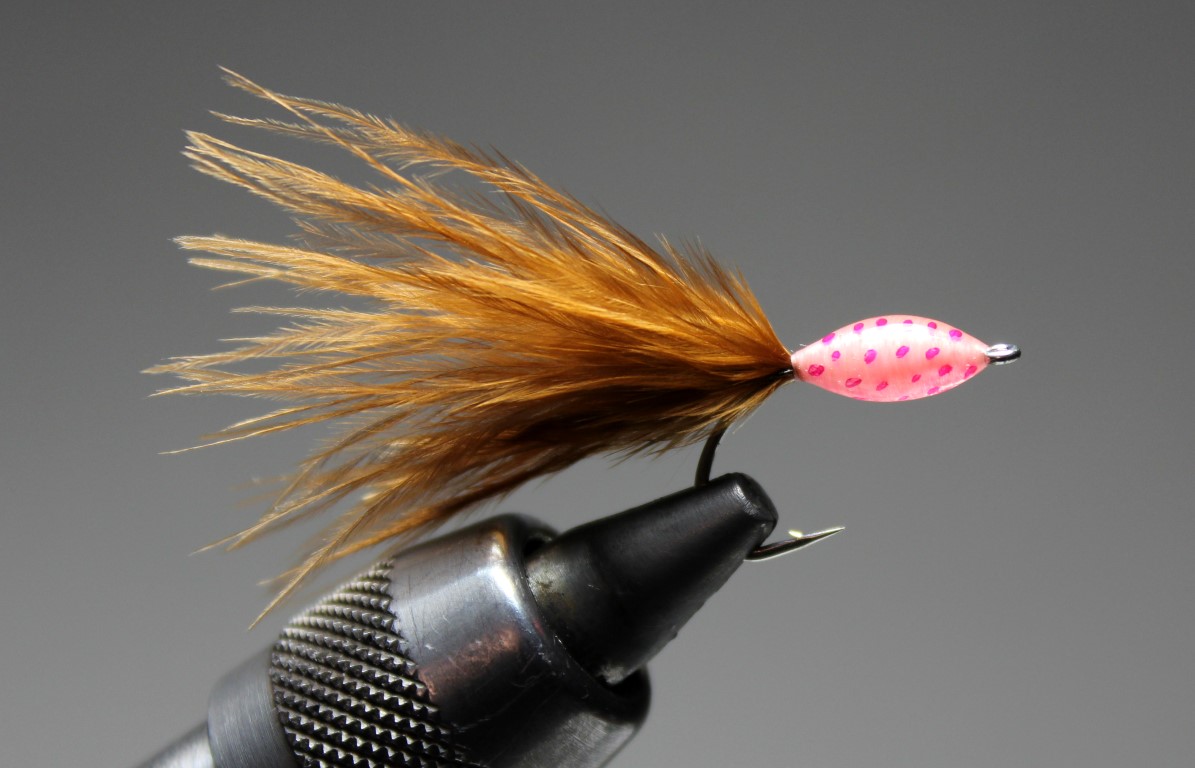
Tie over the white bubble with your tying thread in the color of your choise. Coat it with Bug Bond uv-resin. If you like it a bit fancy, do some small dots with your marker pen on the bubble and secure it with a second thin coating of Bug Bond to get the 3D effect. The bubble should imitate an egg ball and gives the worm a nice bite point.
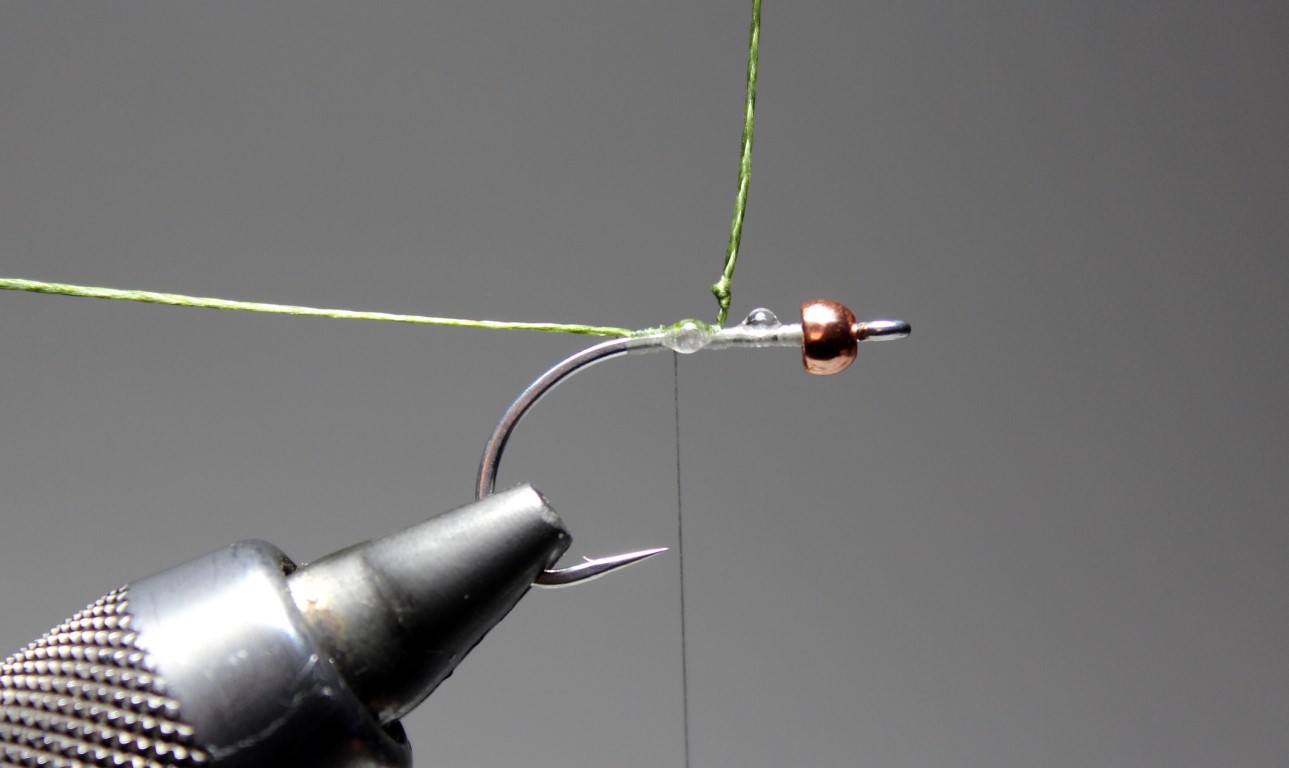
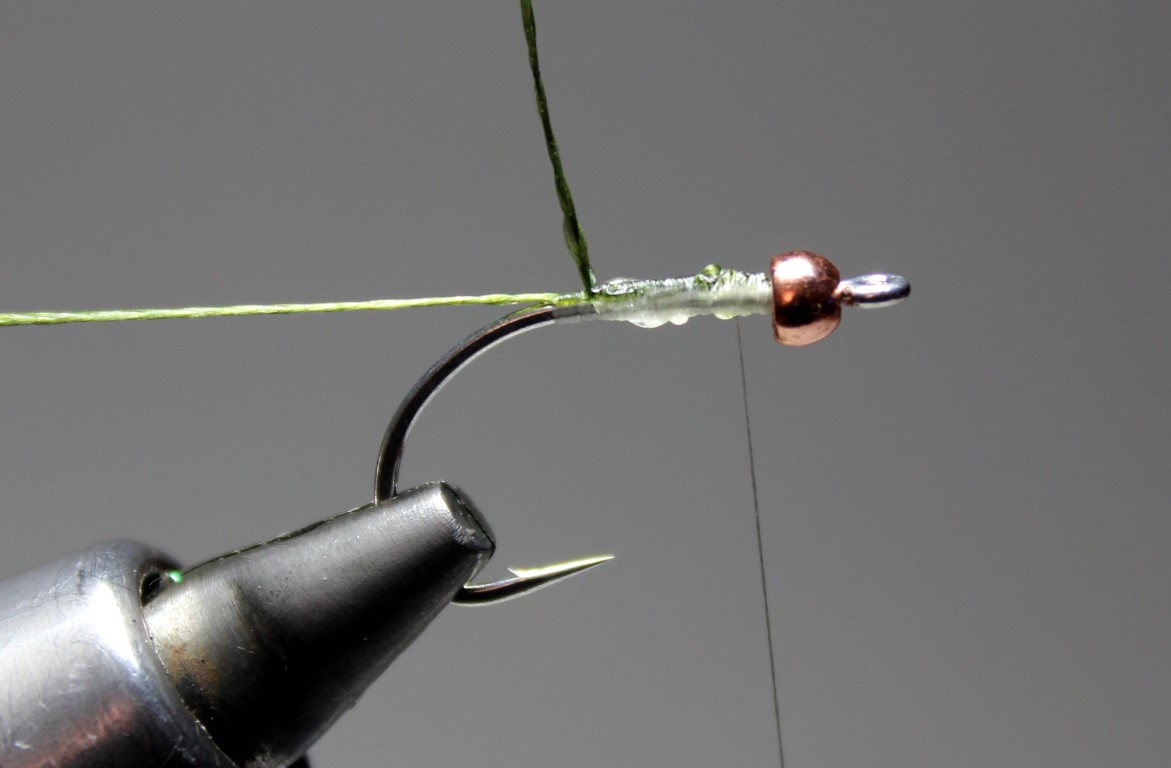
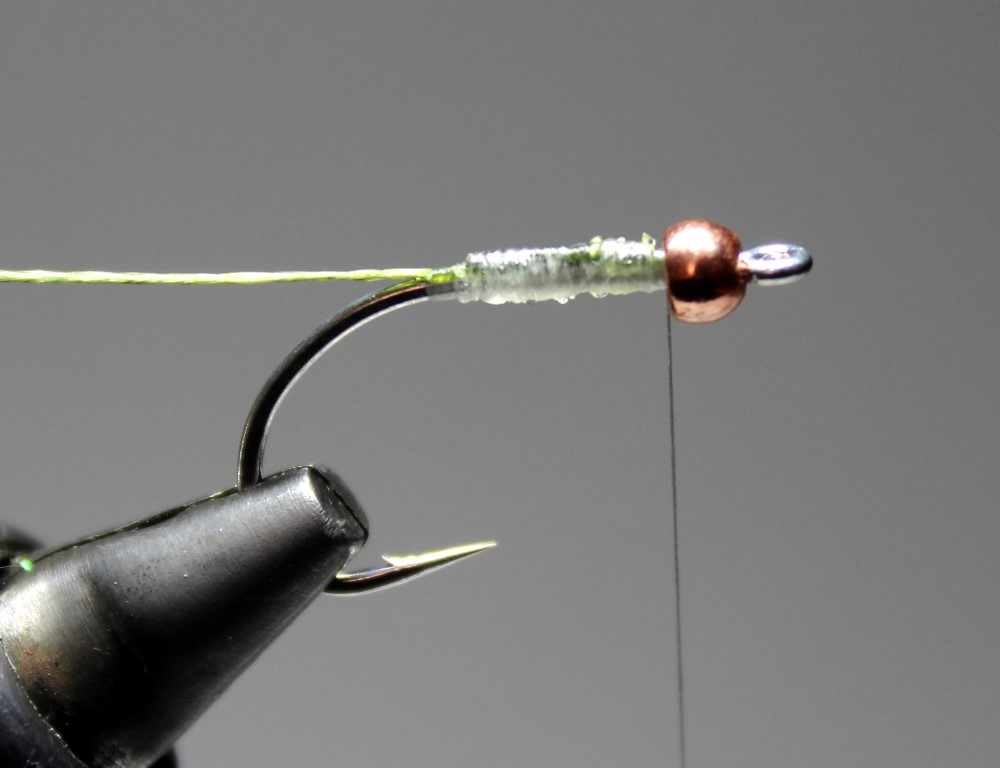
Put the tungsten bead onto the front hook. Do a simple over hand knot in the dyneema fishing line and tie it onto the shank. Secure it with two drops of super glue and keep on tying and fold the dyneema back and forth like shown. No fish will ever destroy this connection!
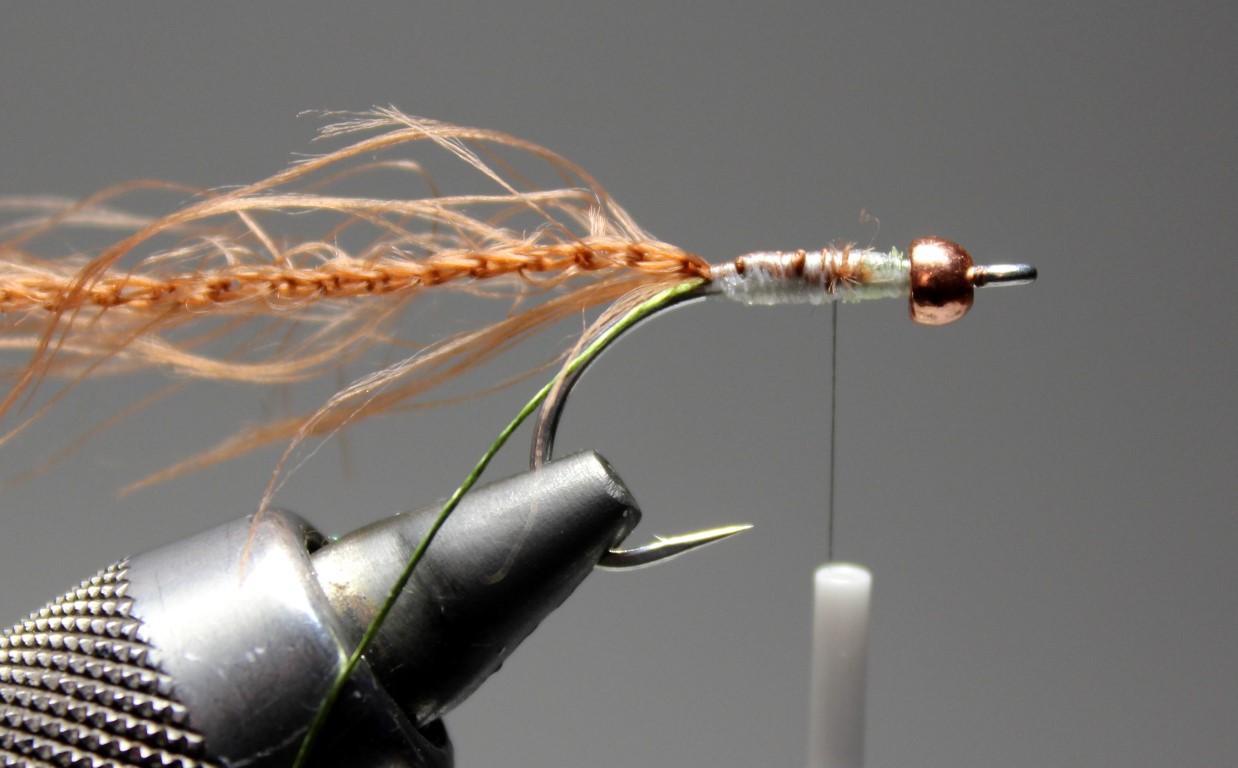
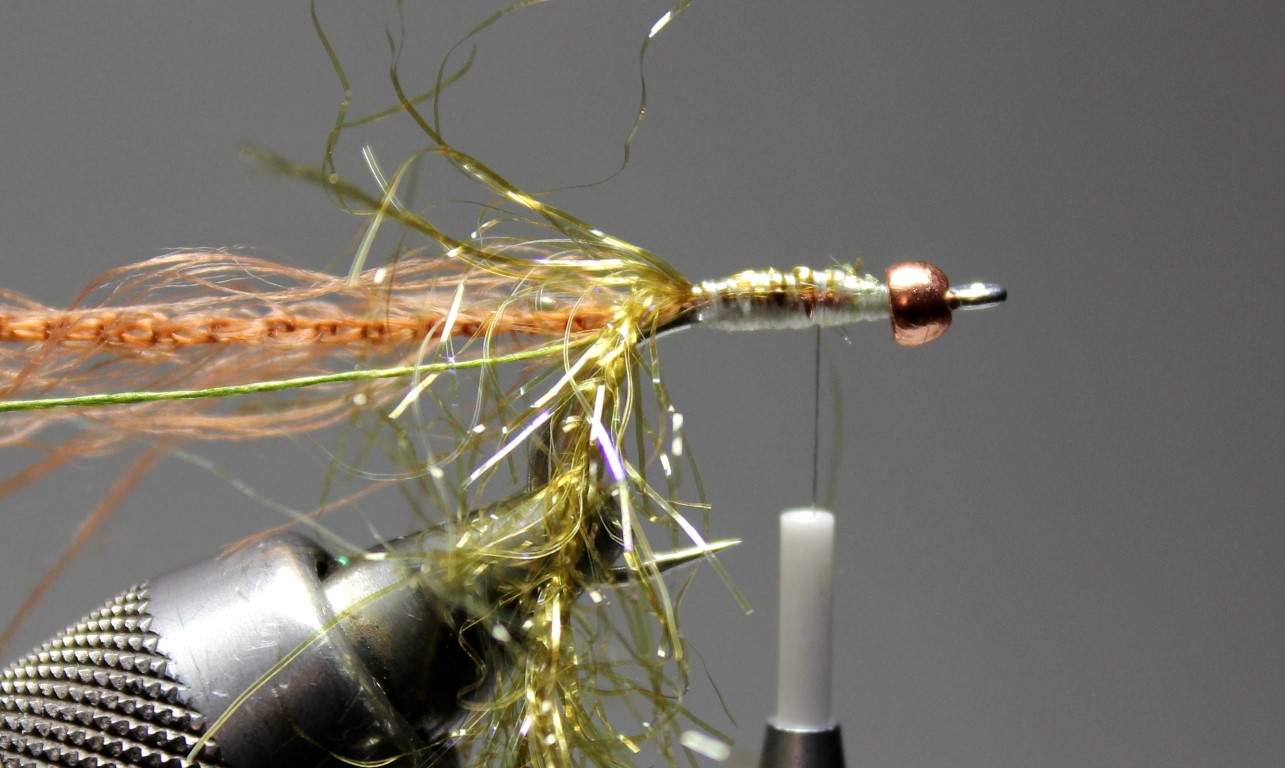
Tie in the polar chenille and the worm wool.
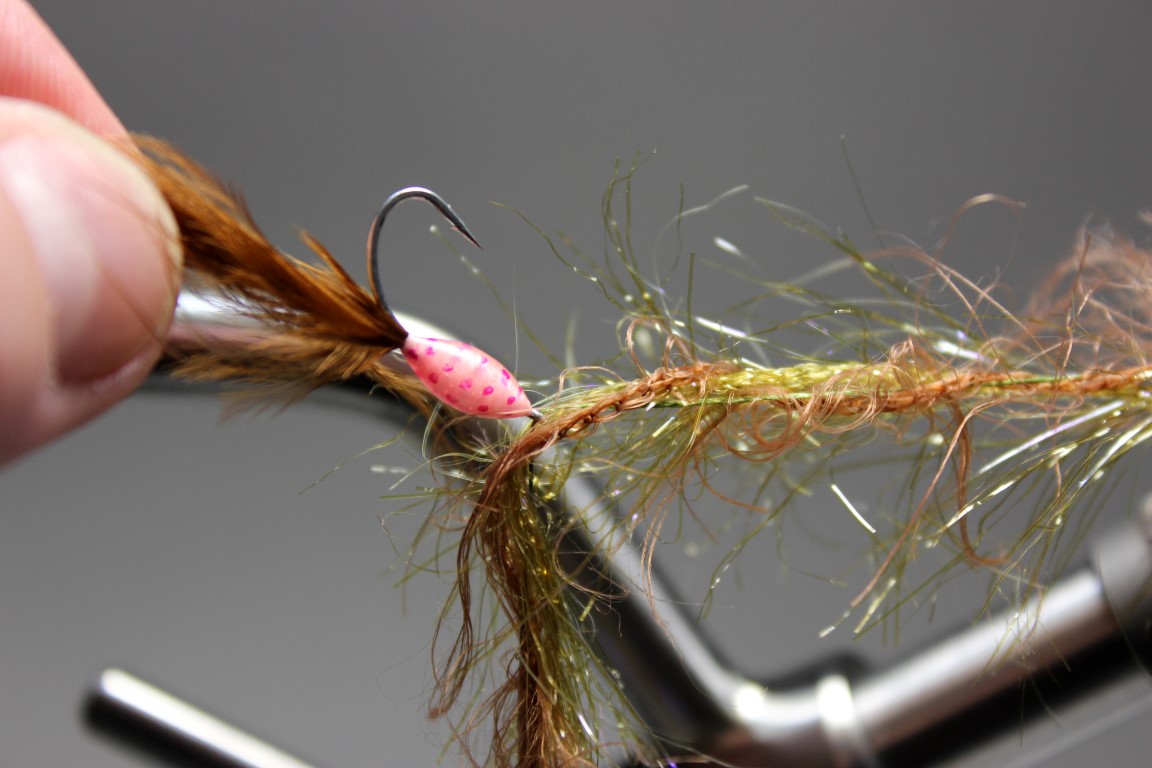
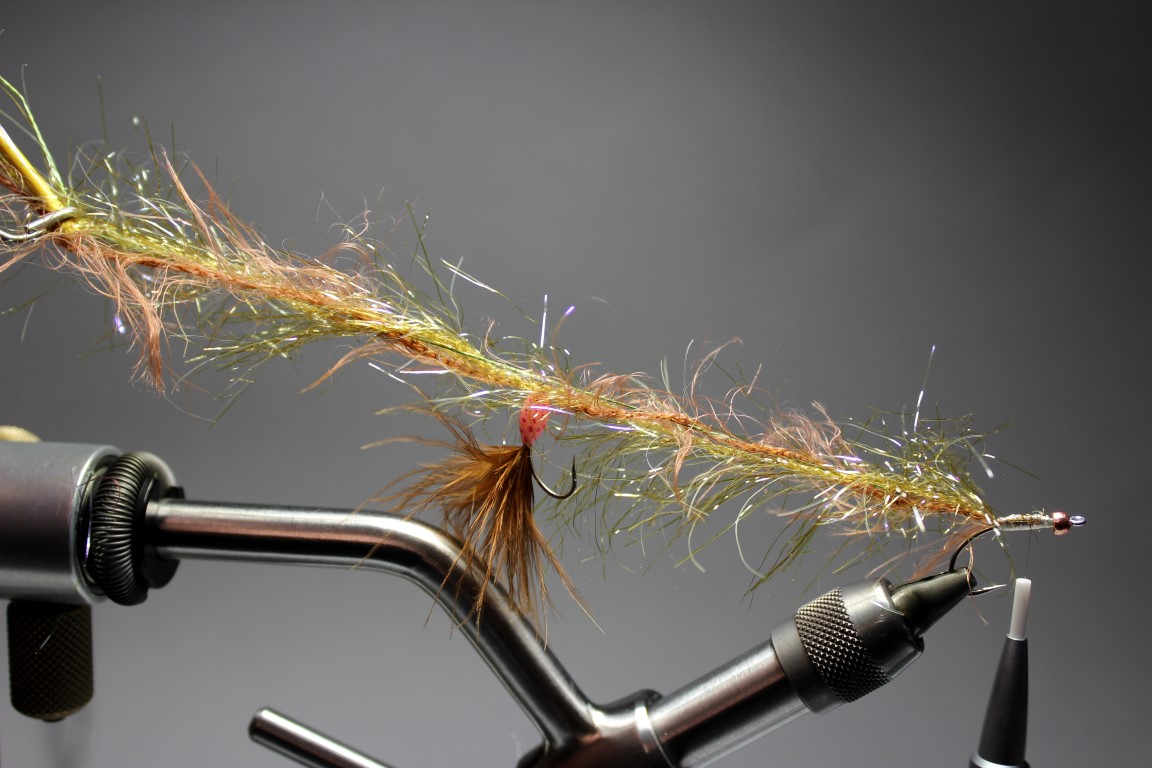
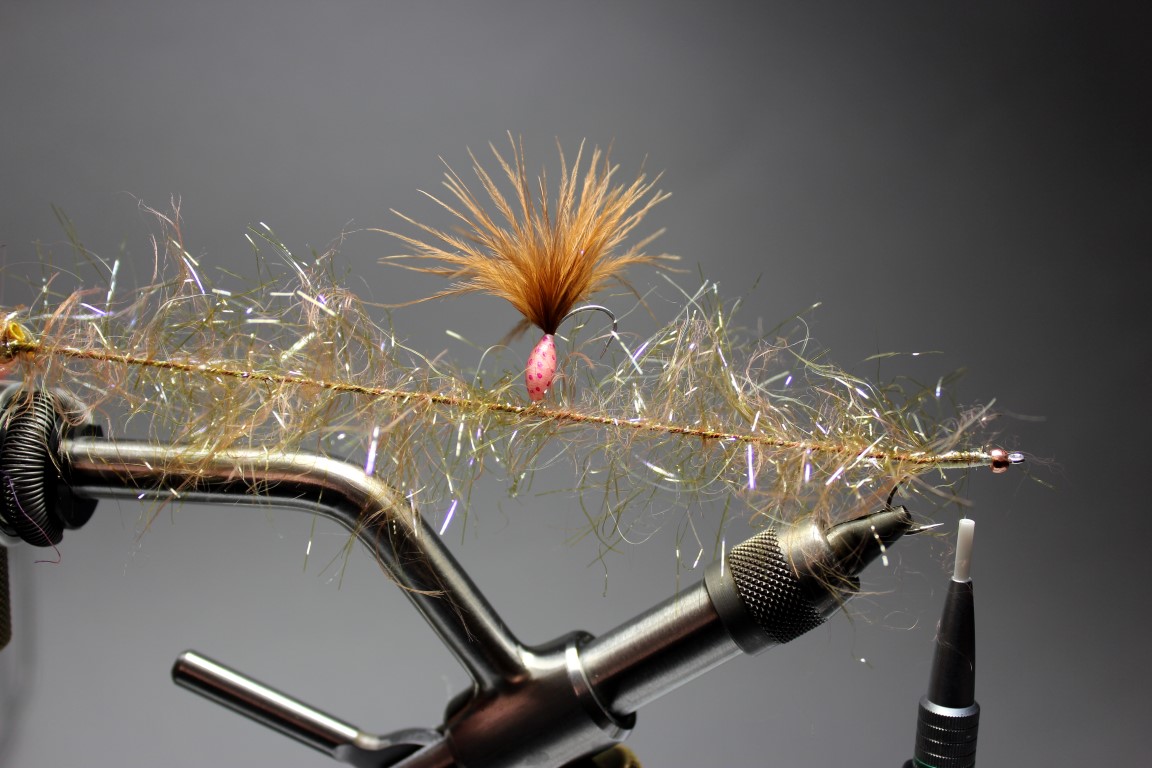
Put the egg hook on the dyneema. That’s how you define the length of the fly. Grab the dyneema, polar chenille and the worm wool and twist it hard.
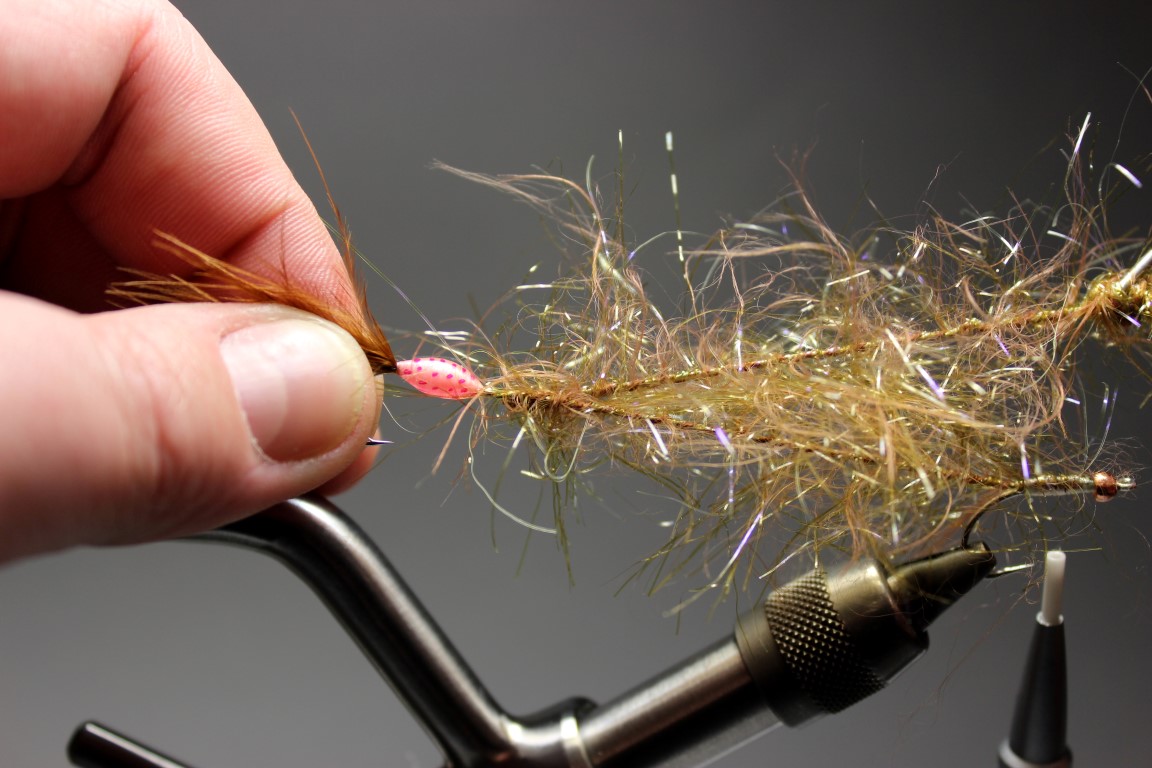
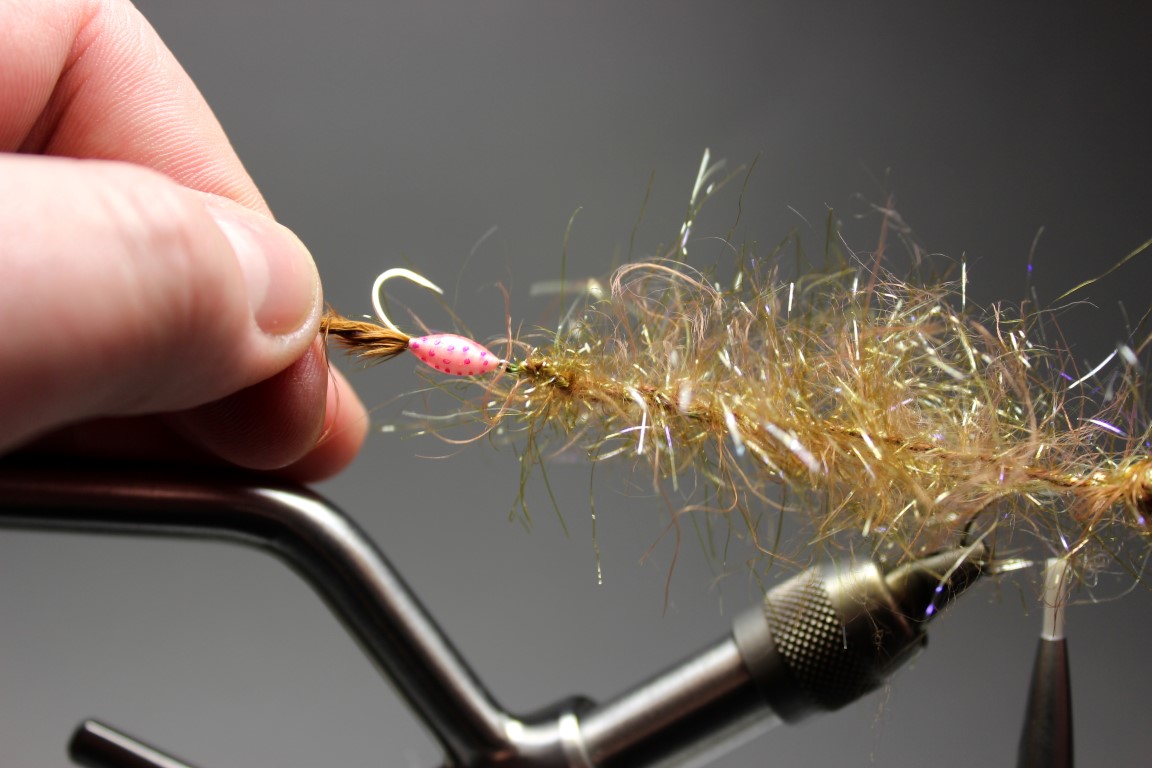
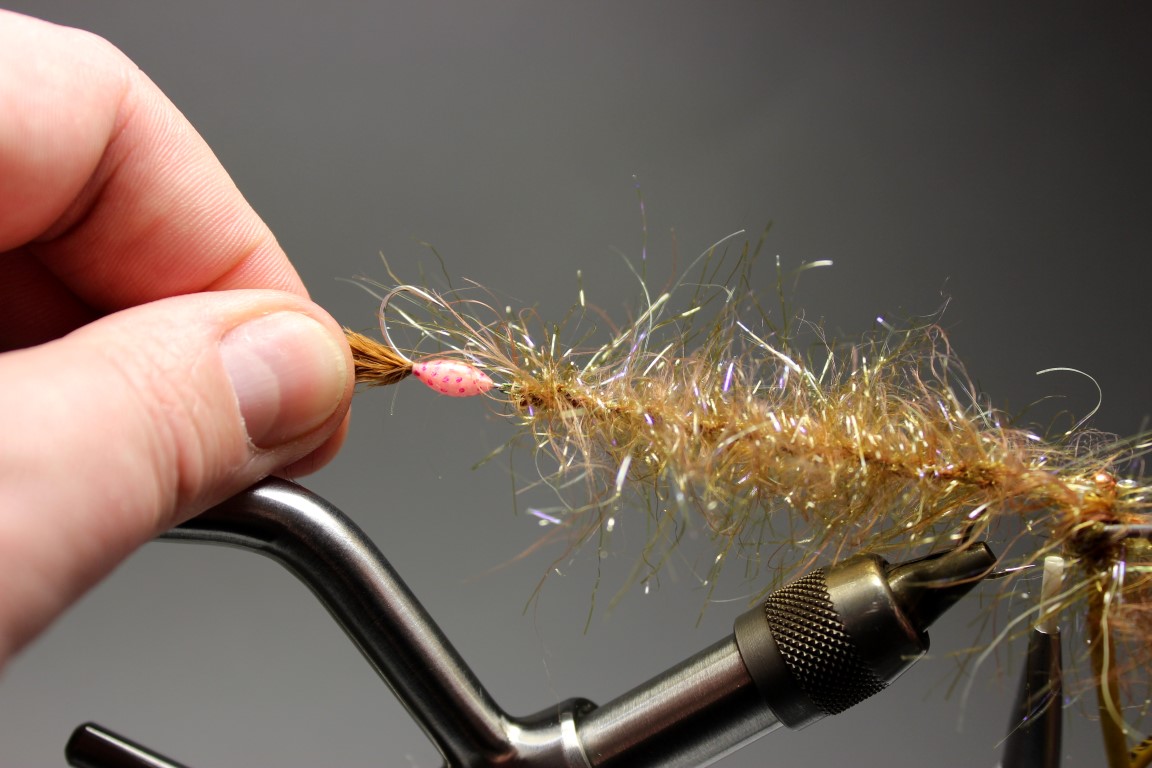
Grab the egg hook and bring the string to the hook eye and let the strings twist into each other.
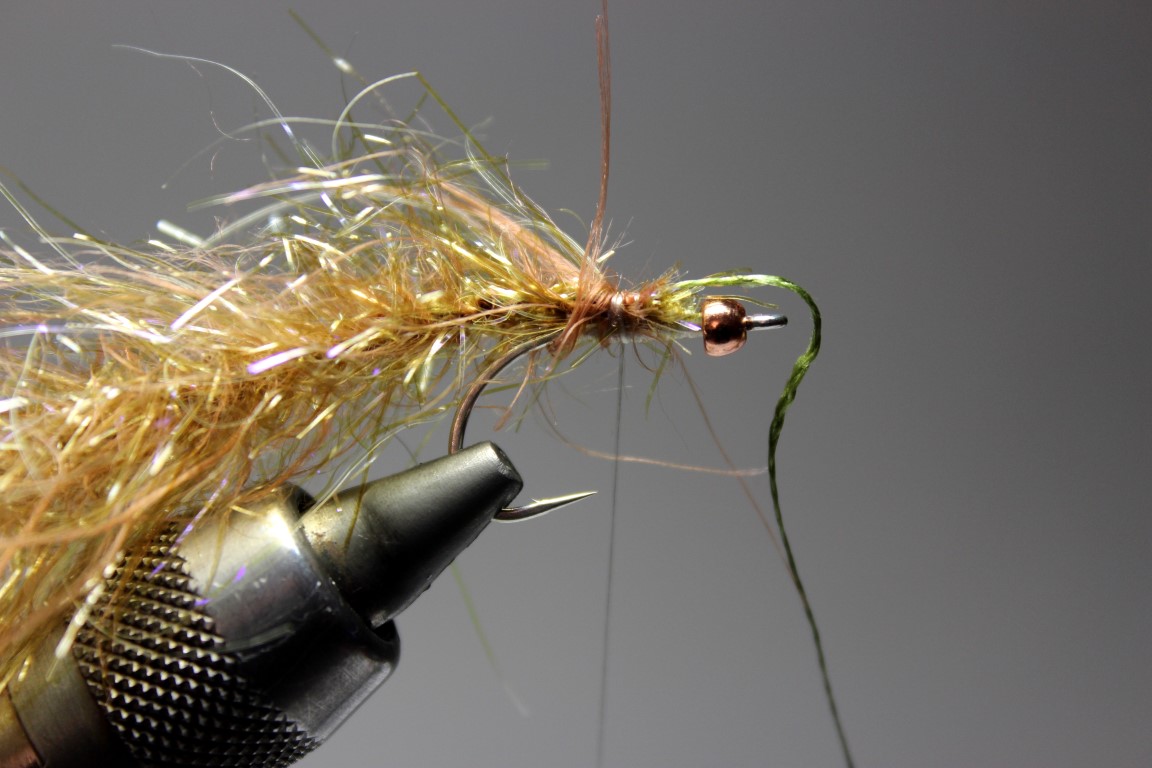
Catch the strings with your thread and cut the polar chenille and the worm wool, but NOT the dyneema fishing line!
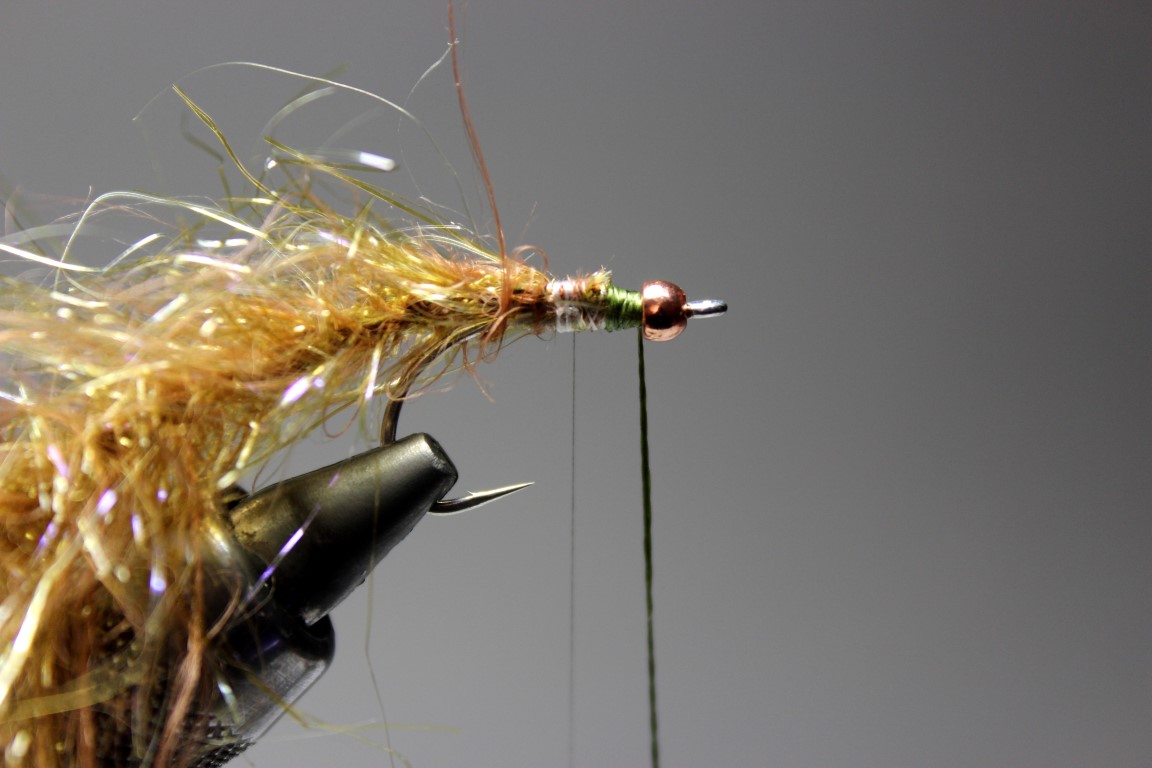
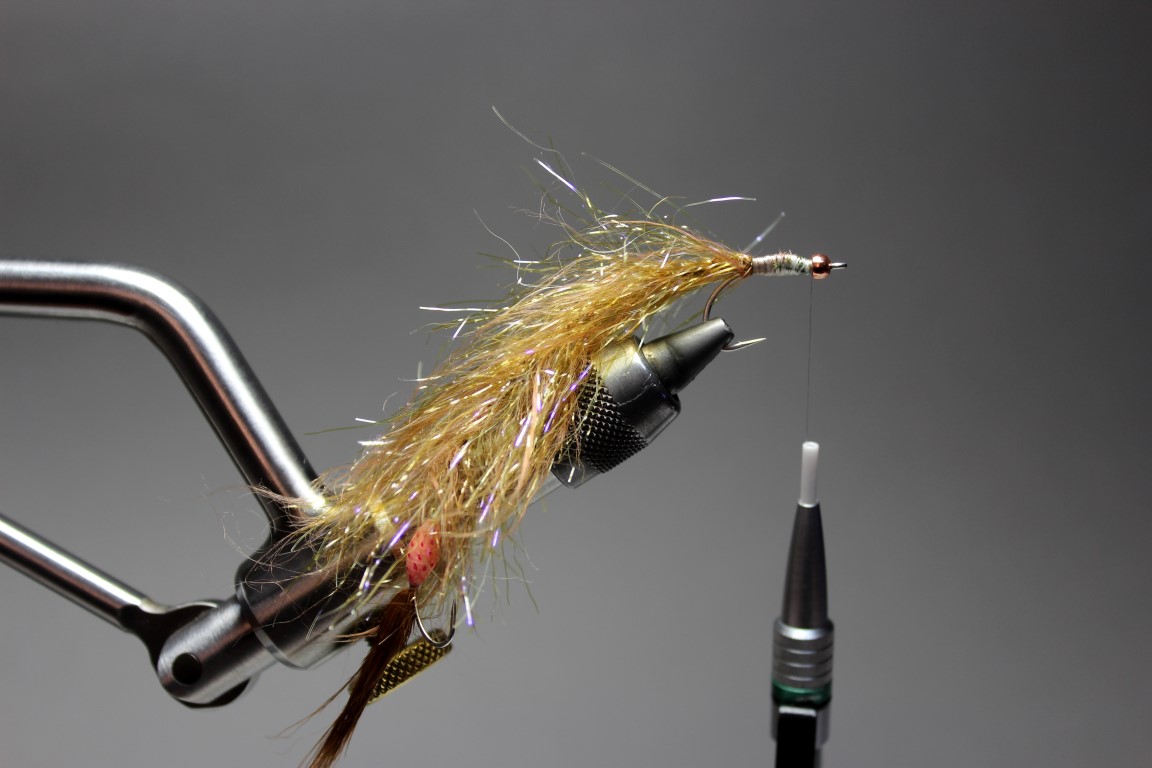
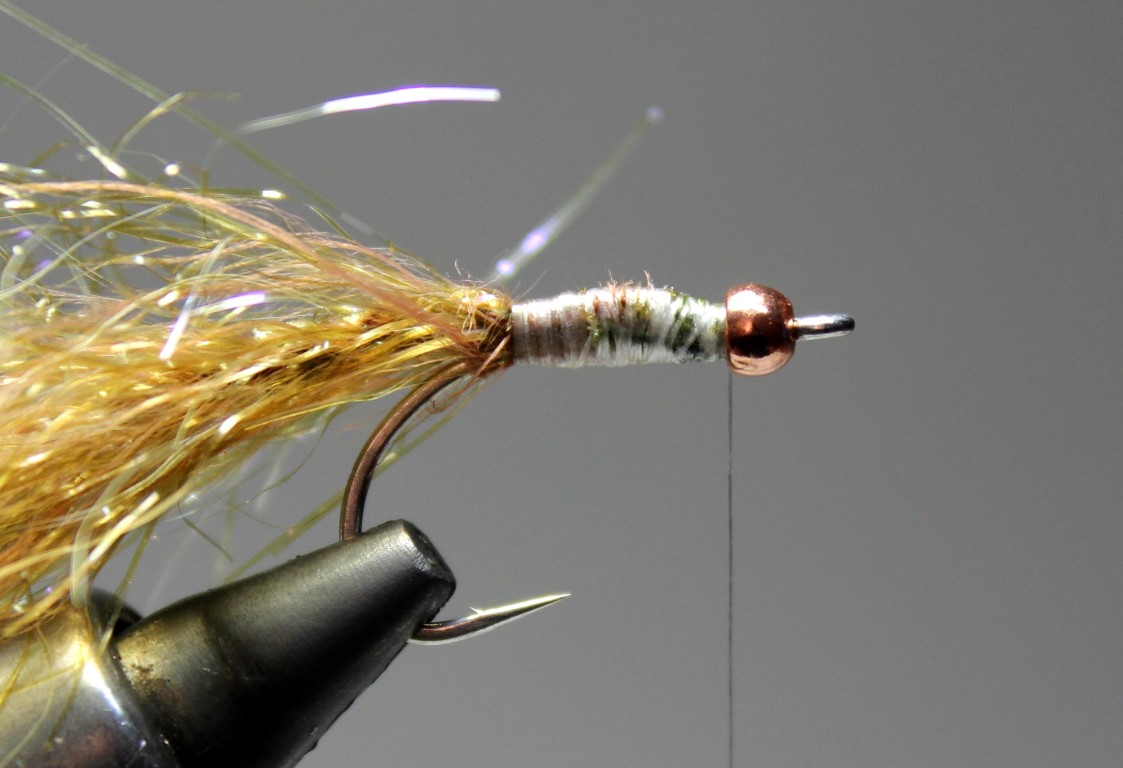
Wind the dyneema fishing line around the hook shank , put a drop of super glue on it and secure it with your tying thread very tight!
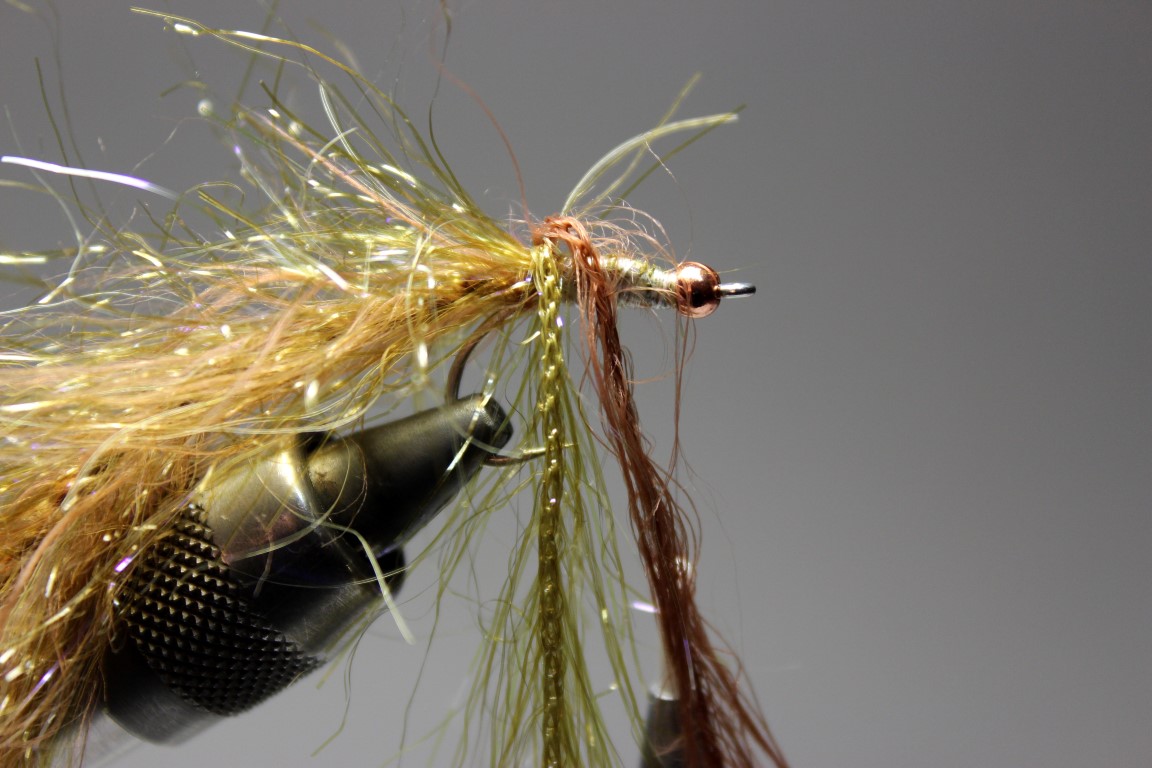
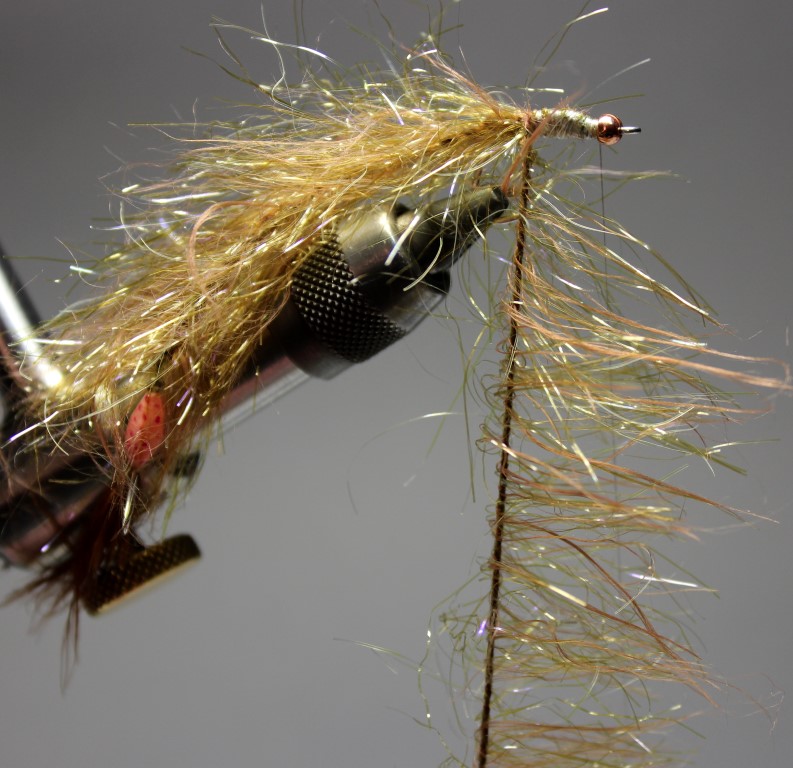
Tie in two another strings of polar chenille and worm wool and twist both strings. Give it a good brush with your velcro. Stroke all fibres to one side.
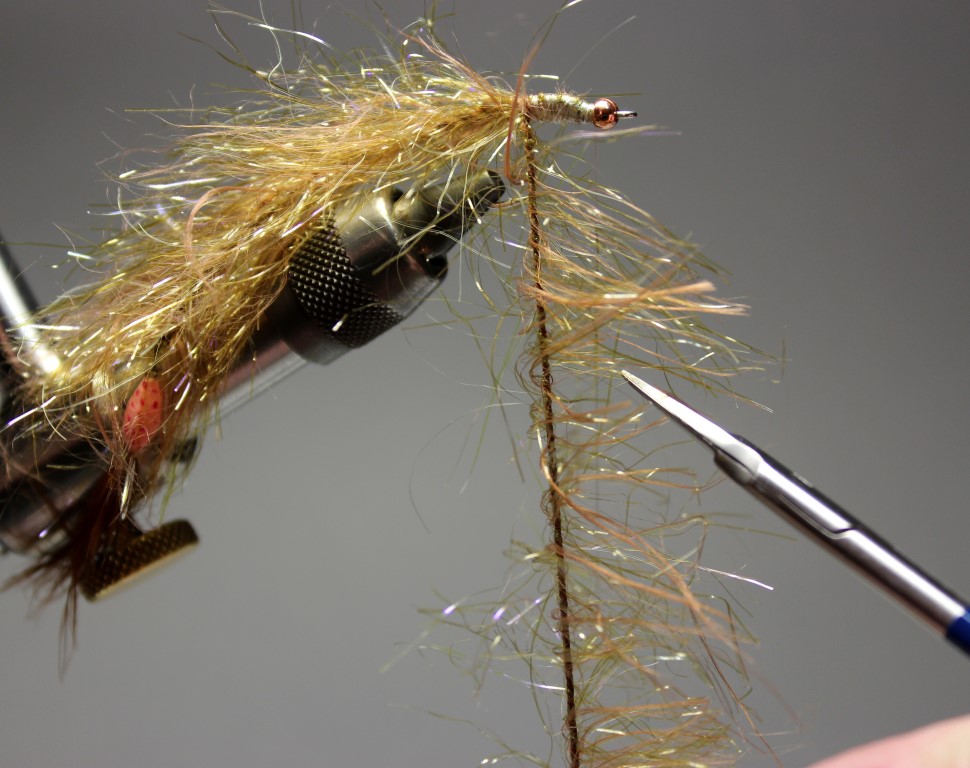
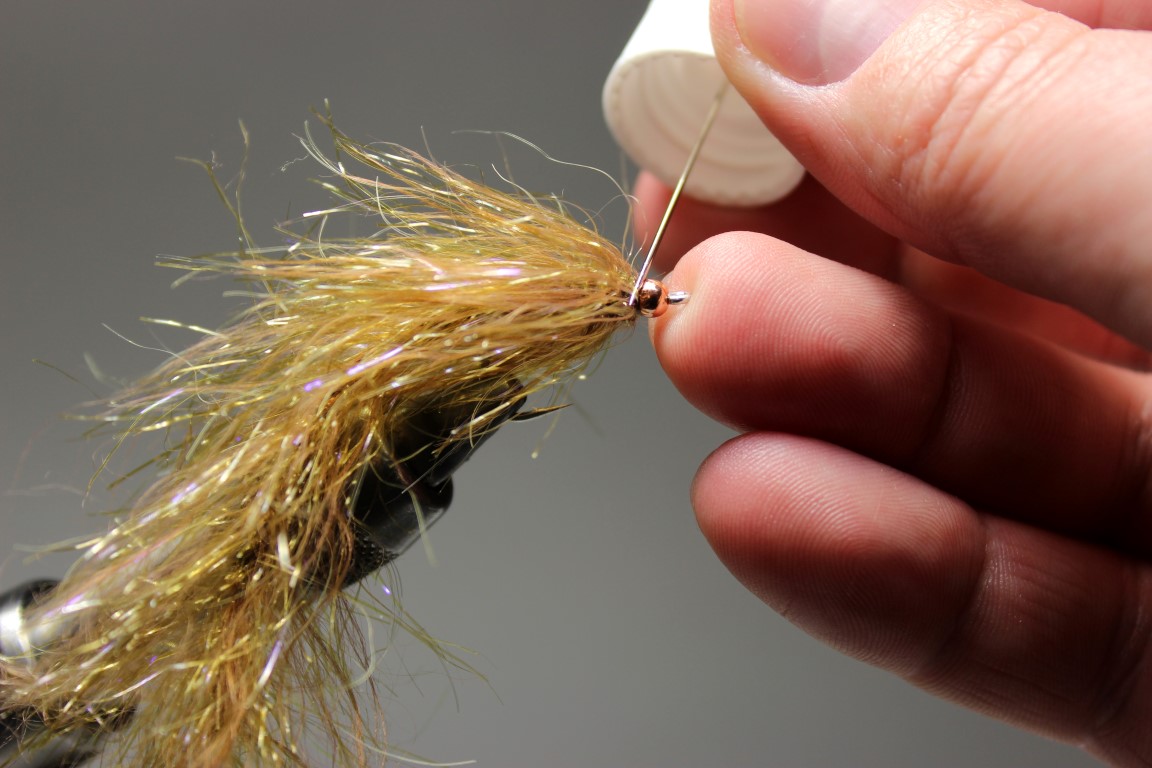
Cut in an angle with your scissors, so the fibres don’t got all the same length. Wind the twisted strands around the shank to the front and catch it with your thread. Cut the strands closely to the bead, do a whip finish and let some thin varnish soak into the front to secure everything.
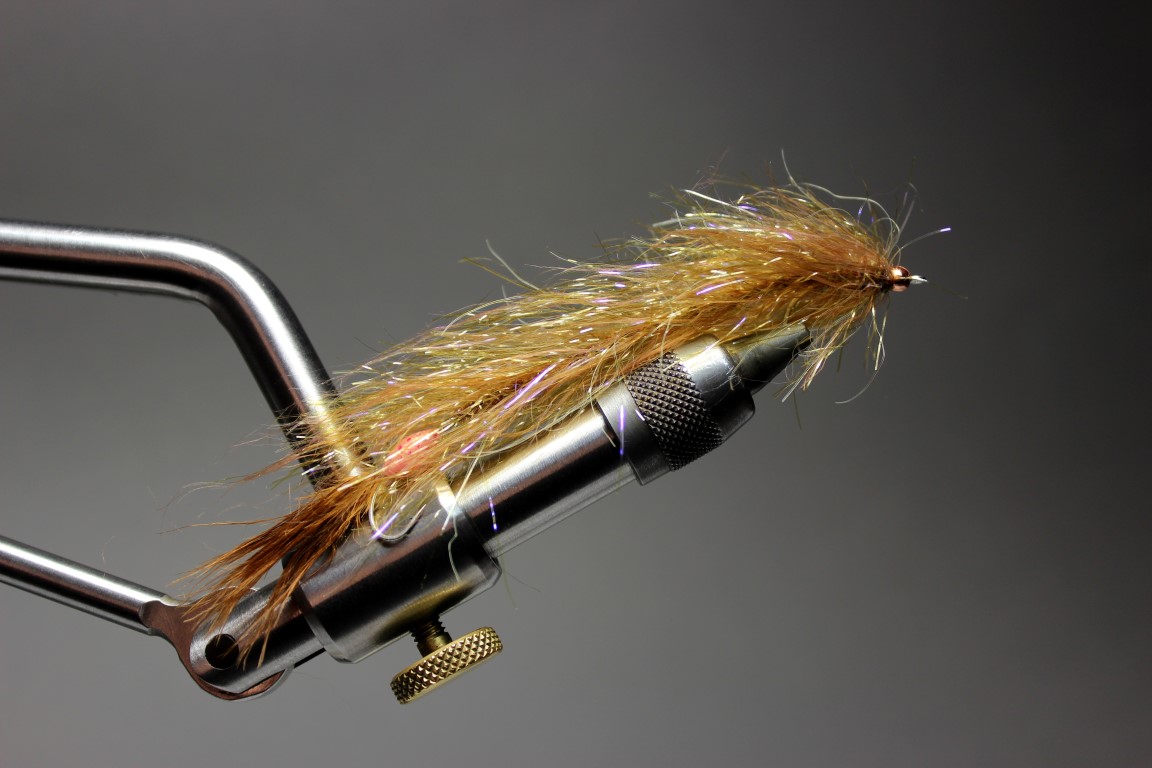
Give the worm a complete brush with your velcro and you’re done! A superb worm fly with a great action in the water and some nice translucency, because of the polar chenille. It’s also a very durable pattern and you can tie it in all colors and sizes you like. If you don’t like flies with two hooks, just cut the hook bend of the front or the back hook close to the body.
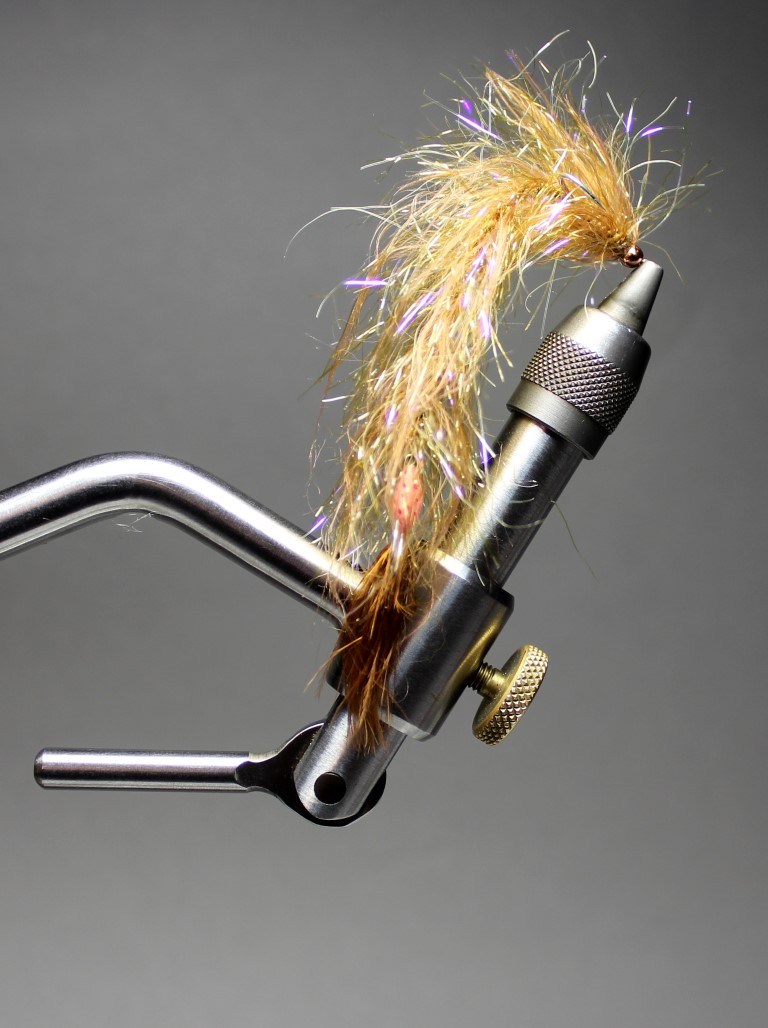
How to tie in Bead Chain Eyes and Dumbbell Eyes ROCK-SOLID!
I was often asked, how bead chain eyes or dumbbel eyes should be tied in, so they won’t twist around the hook shank or getting loose. It seems like a simple task to tie them in, but there are some mistakes you can avoid to get a better result.
I didn’t wanted to do a „how to…“ about it, but I saw a good tying video about a nice streamer pattern yesterday. The fly tyer in the video did the same common mistakes like so many others. He used super glue to fix the eyes, but only at the end on the turns as a kind of topping, and as a topping, super glue can’t show it’s real strength.
So, I made some pictures and I will show you how to tie the eyes in – the ROCK-SOLID-WAY !
If you use G.S.P. thread, you should rotate your bobbin to twist the thread. Otherwise the G.S.P. is too slippery to create a good solid basement for the eyes.
BEAD CHAIN EYES
Ok, let’s start with the bead chain eyes: First, brush some super glue onto the hook shank. I like to use super glue gel.
Twist the tying thread and do a nice layer of thread as a basement. Some glue will be pushed out between the windings of the thread. Don’t whip the glue away.
Go with thread in open windings from the back to the front and then to the back again. Then, wind the thread to the position, where you want to tie in the eyes. You can see, why you shouldn’t wipe off the super glue from the first tying step. You should tie with maximun thread-tension ALL THE TIME!
Tie in the bead chain eyes with only 2-3 turns of thread, not more!
Now comes the „trick“: Brush some super glue on your tying thread like shown on the pictures.
Wind the thread with the super glue in figure-8-turns around the eyes and the shank, like you normally do. Make sure, that the glue is everywhere. That’s the most important thing. The glue is not only on the top of the windings, it secures every single turn of thread and so it creates a perfect connection between hook shank, bead eyes and thread.
View on the underside of the eyes. You can see how the glue is pushed from one turn of thread to the next to create rock-solid bead eyes which won’t move, twist or slip no matter what you are doing to them during fishing. If you did it right, you will need pliers to twist them. The only way to connect them even more solid to the hook is to weld them onto the hook shank….! ;-)
Dumbbell Eyes
When you like to use dumbbell eyes, you may need a larger basement to secure them. 
Tie the thread on the hook shank in the same way, like shown before with the bead chain eyes. Then take some dubbing (no matter what kind of dubbing, but synthetic works best), make a first turn.
Twist the dubbing around the thread to create a little dupping rope and wind it around the hook shank.
Put some super glue on the thread and do some open turns with your glue-thread back and forth over the dubbing with HIGH THREAD TENSION! Now, you got a larger solid basement for the dumbbell eyes.
The next steps are the same like with the bead chain eyes. Attach the dumbbell eyes with 2-3 turns on the hook, put some super glue on the thread and wind it figure-8-like around the dumbbell eyes.
That’s it! The dumbbell eyes will stay there forever! Now throw them to the toothy beasts ! :-D
Caddis Larva Step By Step
Here we go again! After moving to a new server, it’s time for a new step by step tutorial. This Caddis Larva is a very nice imitation of the original and it’s still quite easy to tie. So, it’s not a drama, when you lose it on the river bottom.
You have to fish this larva deep, that’s why there is a lot of weight in it. It still got a slim body, so it sinks fast to the ground. You will find Caddis in almost every river and it’s an important part of the fish’s menu.The coloration with the brown line on the abdomen is not a must. I just did it to show you what for possibilities you have with ordinary marker pens. It’s tied on a # 10 hook, which sounds pretty big, but the body length is close to the original, just try to keep a slim, natural looking body. Ok, let’s start!
Materials:
- Hook: Demmon Competition G601 BL Fly Hook # 10
- Weight: Lead-Foil
- Ribbing: Mono 0,10mm
- Back: Stretch Flex Clear
- Abdomen: Sow Scud Dubbing Beige
- Thorax: Siman Peacock Dubbing Brown
- Thread: G.S.P. 50 D
- Coloration: Edding 3000 Marker Pens
Wind the lead foil in multiple layers around the hook.
Take a CDC feather and cut out the feather steam on the top and tie the feather in like shown on the pictures to create the little tail.
Take the stretch flex and tie it in at the back of the fly. Do the same with the mono for ribbing.
Dub the abdomen on 3/4 of the hook shank with a nice tapering.
Split the thread with your dubbing needle, put the peacock dubbing in the gap, rotate your bobbin to spin the dubbing and wind it around the hook to create the thorax and the legs in on step. Leave a little bit space for the head next to the hook eye.
Fold the stretch flex to the front and catch it with your tying thread next to the hook eye. Fold it back, catch it again with your thread and cut away the excess. That’s the easiest way to form a nice head.
Take the mono and ribb the abdomen in small segments and the thorax in two bigger segments. Catch the ribbing with your tying thread and cut it off. Do two whip finish, cut the tying thread and the tying is done.
With the marker pens, you can give the larva the coloration of your liking or the spicific colors of the originals in your home waters. Put a drop of varnish on the head and the fly is finished, ready to be presented to the fish of your dreams! :-)
Tight lines!
Winged Ant Step By Step
Ants are everywhere, especially in the summer, when the winged ants are flying around. Fish love to eat them, so it’s logical to have some ants in your fly box. This is an easy to tie pattern and with a little bit floatant, it swims very well. I tied here a version with some foam as underbody, coated with uv resin. It’s for the faster flowing water. I tie another version with the two segments completly made with uv resin without any foam. The secound version sits deeper in the surface film, which looks more natural in slow water, where the fish got more time to take a closer look. The shape of the hook is not so important, as long as the hook gap is big enough.
Materials:
- Hook: Dry fly hook # 12-16
- Body: Foam coated wit Bug Bond UV Resin and colored with a black Marker Pen
- Hackle: Whiting black
- Wings: Flash Dubbing
Tie in the foam and fold it to the front and tie it down.
Do the same for the front segment and color it with a marker pen.
Take some Bug Bond Original and cover both segments with the resin and harden it with your BB torch.
Take some strands of flash dubbing and tie it in just before the first segment. It should be tied in V-shaped, so it looks like wings.
Tie in a black hackle and wind it in three turns to the front and catch it with your thread and do a whip finish.
The result. A nice little ant fly ready for the fish.
Easy Nymph Step By Step Without Words
Sparkle Mayfly
Sparkle Mayfly. Wings are two colors of CDC (natural and white from Trout Line) with a few strands of very thin flash. There’s a little sparkle in the wings. It’s hard to show that on the picture, in reality, it’s looks very posh! Thorax is normal dubbing, wingcase is made from pheasant and the body is made with Polish Quills, secured with Bug Bond. Tails are synthetic Mayfly Tails. For the hook I’ve used a D23BL # 14 from Trout Line.
yellow-brown CDC Dun fast step by step
Stickleback Zonker – Fly Tying Tutorial
I made a new little video about an easy to tie pattern of a Stickleback.
[vimeo width=“600″ height=“500″]https://vimeo.com/108999238[/vimeo]

